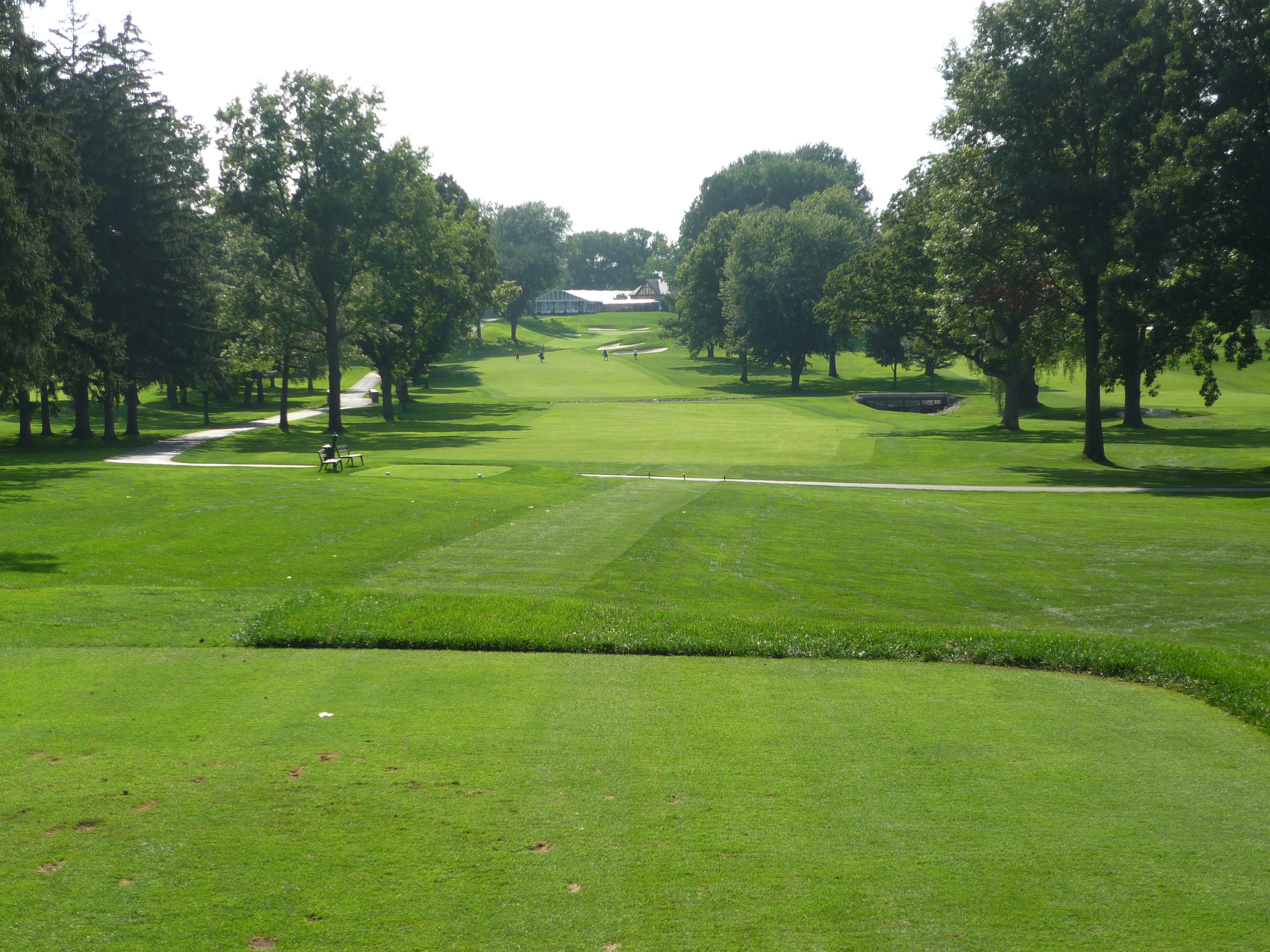
Oak Hill Country Club (East) – Played August 2015
- Rankings: Golf Digest #17, Golf Magazine #32
- Location: 346 Kilbourn Road, Rochester, New York
- Year: 1925
- Original Architect: Donald Ross
- Additional Work By: Robert Trent Jones & Craig Schreiner
- Course Access: Private
- Walking Rules: Carts & Caddies Available
Score Card Information:
- Championship: 7,159 yards, Par 70, 76.4 Rating/148 Slope
- Black: 6,842 yards, Par 71, 75.3 Rating/143 Slope
- Blue: 6,573 yards, Par 71 (Men’s), 75 (Women’s), 72.7 Rating/138 Slope (Men’s), 79.1 Rating/150 Slope (Women’s)
- White: 6,194 yards, Par 71 (Men’s), 75 (Women’s), 71.1 Rating/139 Slope (Men’s), 77.9 Rating/142 Slope (Women’s)
- Gold: 5,920 yards, Par 71 (Men’s), 75 (Women’s), 69.7 Rating/136 Slope (Men’s), 76.6 Rating/142 Slope (Women’s)
Oak Hill Country Club is one of the elder statesmen of American golf courses. The club was incorporated in 1901 on leased land with nine holes. The game was still relatively new in America. Over the next years it grew to be one of the jewels of Rochester.
In 1921, the University of Rochester proposed a land swap for a piece of land in Pittsford. This move was mutually beneficial to the club and the university. The new spot for the club had quadruple the acreage and allowed for two 18-hole golf courses. It also allowed for the wonderful clubhouse you will see in the following photos.
Once the new site was being prepared Dr. John R. Williams decided it would be improved by trees. He planted thousands of oaks, maples, evergreens, and elms. Dr. Williams was famous for pioneering the use of insulin to treat diabetes. The story goes that he lost count at 75,000 trees.
Oak Hill was built to host major competitions and that is just what it did. Starting with the 1949 US Amateur which lead to the 1956 US Open won by Cary Middlecoff. The tradition continued with the 1968 US Open, 1980 PGA Championship, 1984 US Senior Open, 1989 US Open. 1995 Ryder Cup, 1998 US Amateur, 2003 PGA Championship, 2008 Senior PGA Championship, and 2013 PGA Championship. You can see from this list that it is quite a facility steeped in tradition.
One of the coolest features at Oak Hill is the Hill of Fame, also developed by Dr. John R. Williams. It came about in 1956 and is located near the green of the 13th hole on the East Course. The club takes pride in its history and the hill is an extension of that. Consistent with his love of trees, a bronze plaque would be affixed to the trees to commemorate people’s accomplishments. Forty-two people have been honored. They include Dwight Eisenhower, Robert Trent Jones, Walter Hagen, Ben Hogan, Charles Coe, Dr. Cary Middlecoff, Babe Zaharias, Gene Sarazen, Billy Casper, Dr. John R. Williams, Chick Evans, Jr., Francis Ouimet, Bob Hope, Horton Smith, Joseph C. Dey, Jr., Arnold Palmer, Jack Nicklaus, Gary Player, Lee Trevino, Byron Nelson, Nancy Lopez, and Donald Ross. That is quite a list of names.
I was lucky enough to get an email from one of my readers with an opportunity to play this famous course. I jumped at the opportunity and drove right up to upstate New York. The round was the result of a charity auction and I couldn’t have been more appreciative.
One of the most iconic parts of Oak Hill is its clubhouse. It is a Tudor-style building that is massive. It even has a bowling alley. Our member host gave us a wonderful tour and filled us in on some of the history of the club.
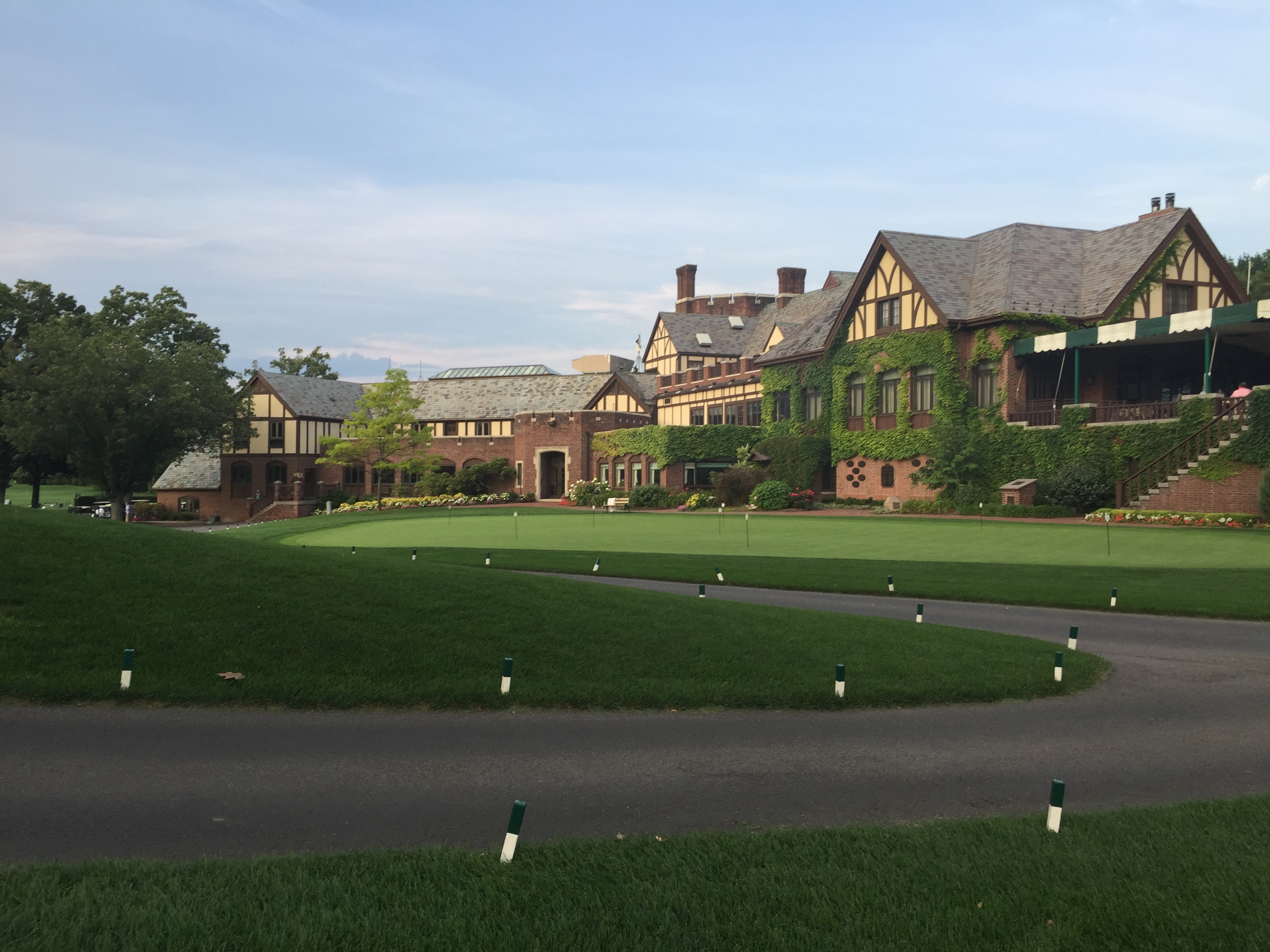
We decided to play the blue tees and were off.
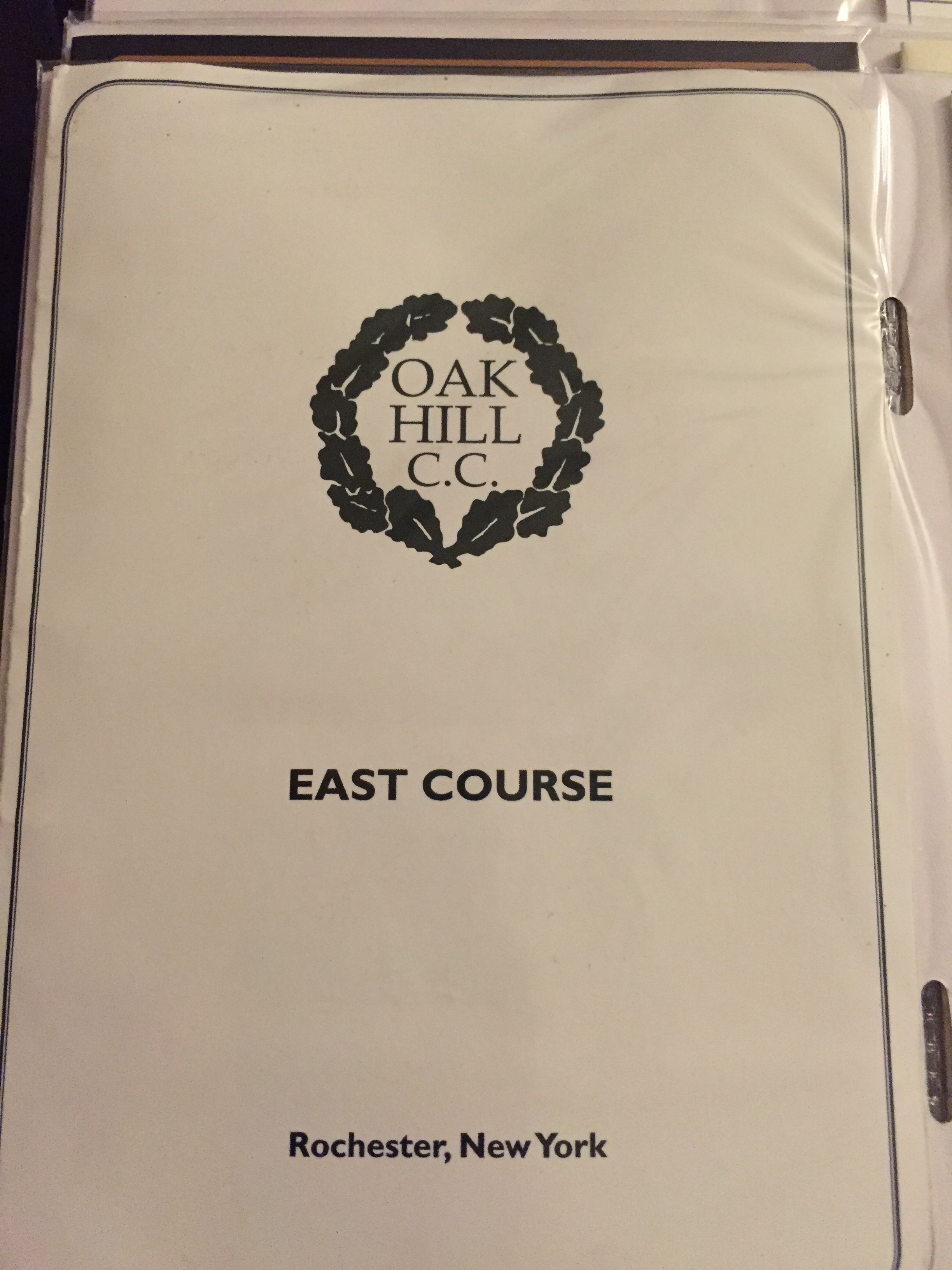
Hole 1 – 435 yards – Par 4 – Challenge
Ben Hogan called this the hardest opening hole in major championship golf. From our tees, the trees on the right are in play. You want to hit a long draw here to get the most out of your tee shot.
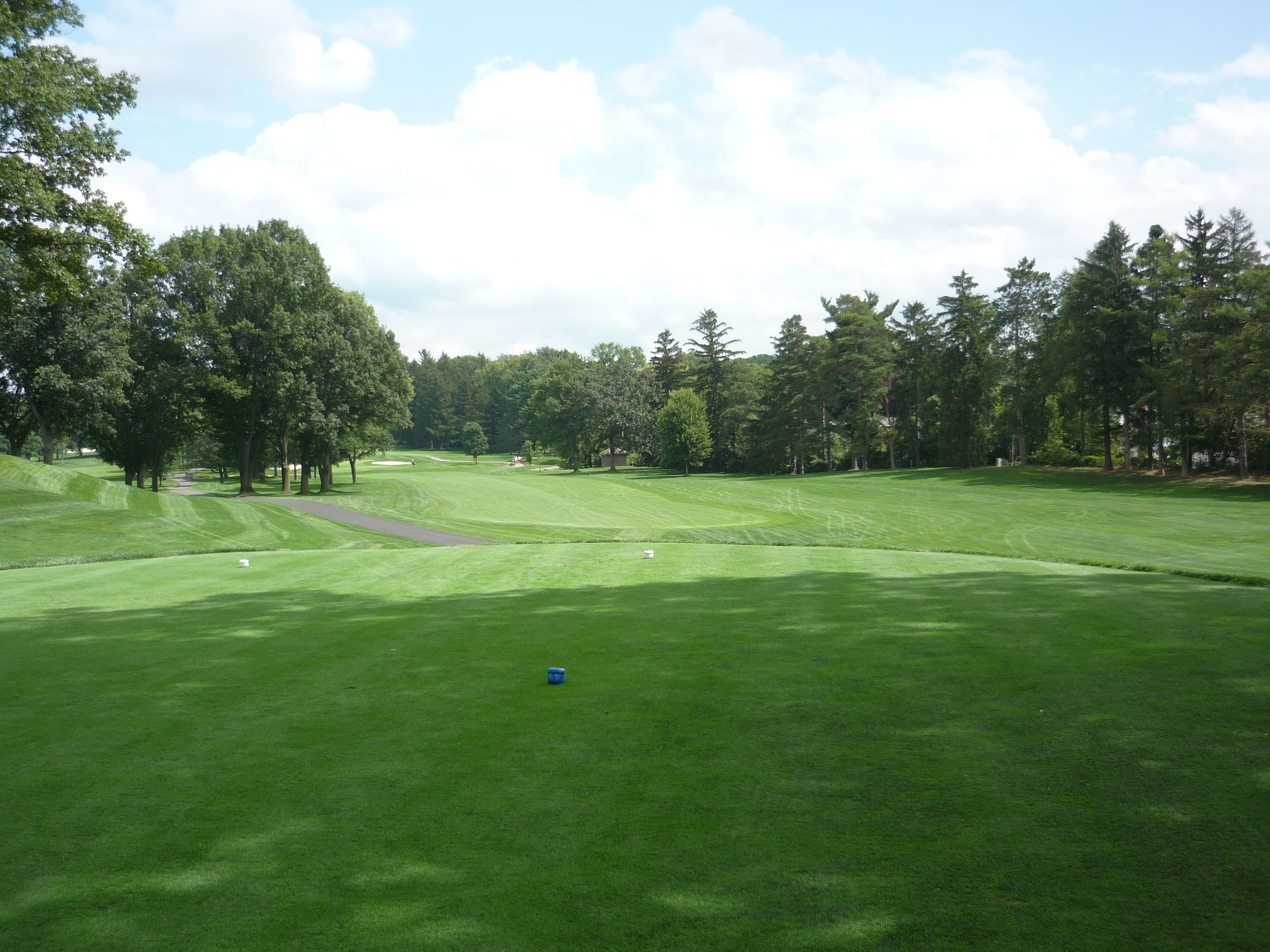
The second shot must deal with Allen’s Creek that runs through the fairway. The green is open in the front to accept running shots.
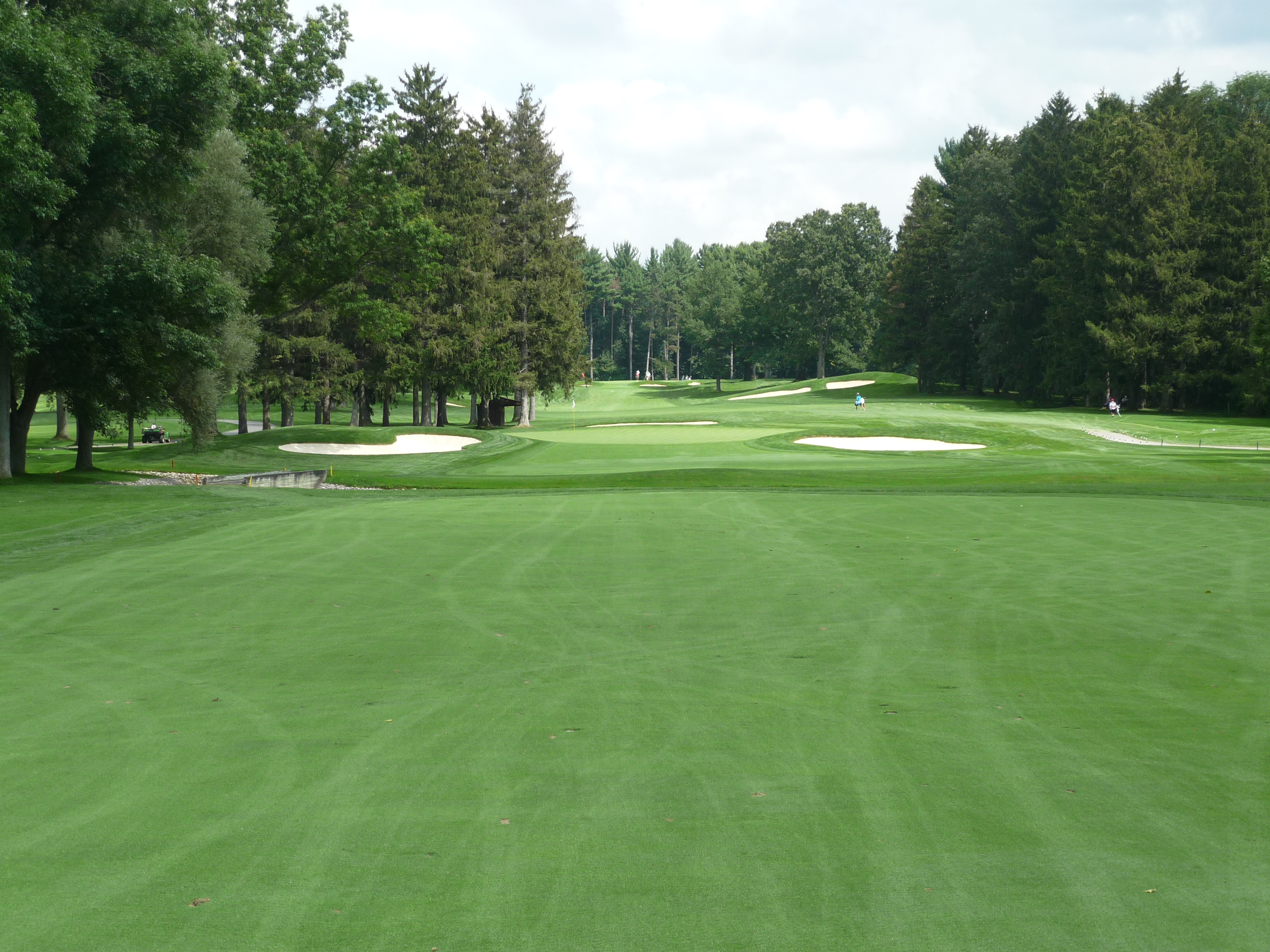
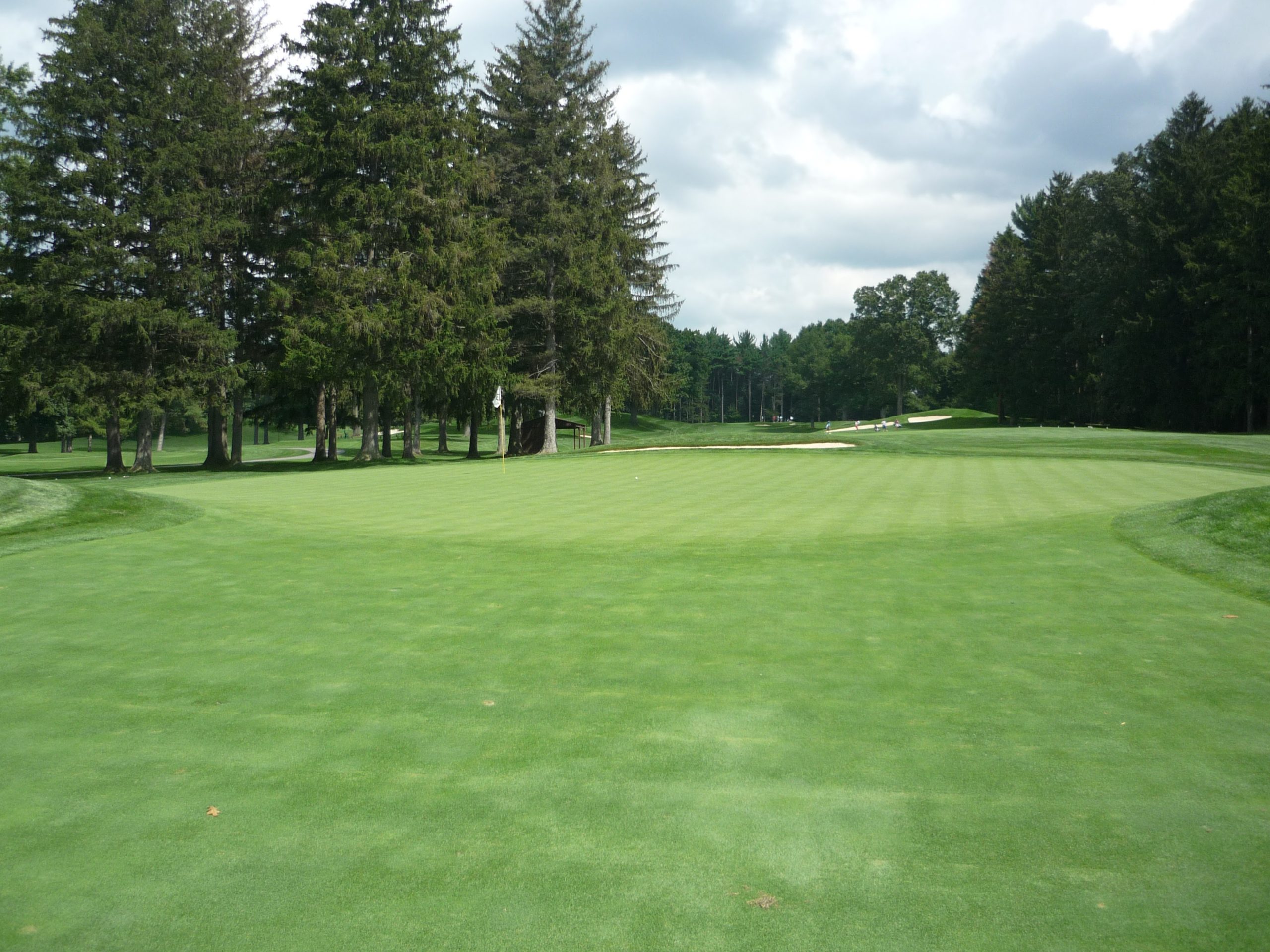
Another angle shows the slope.
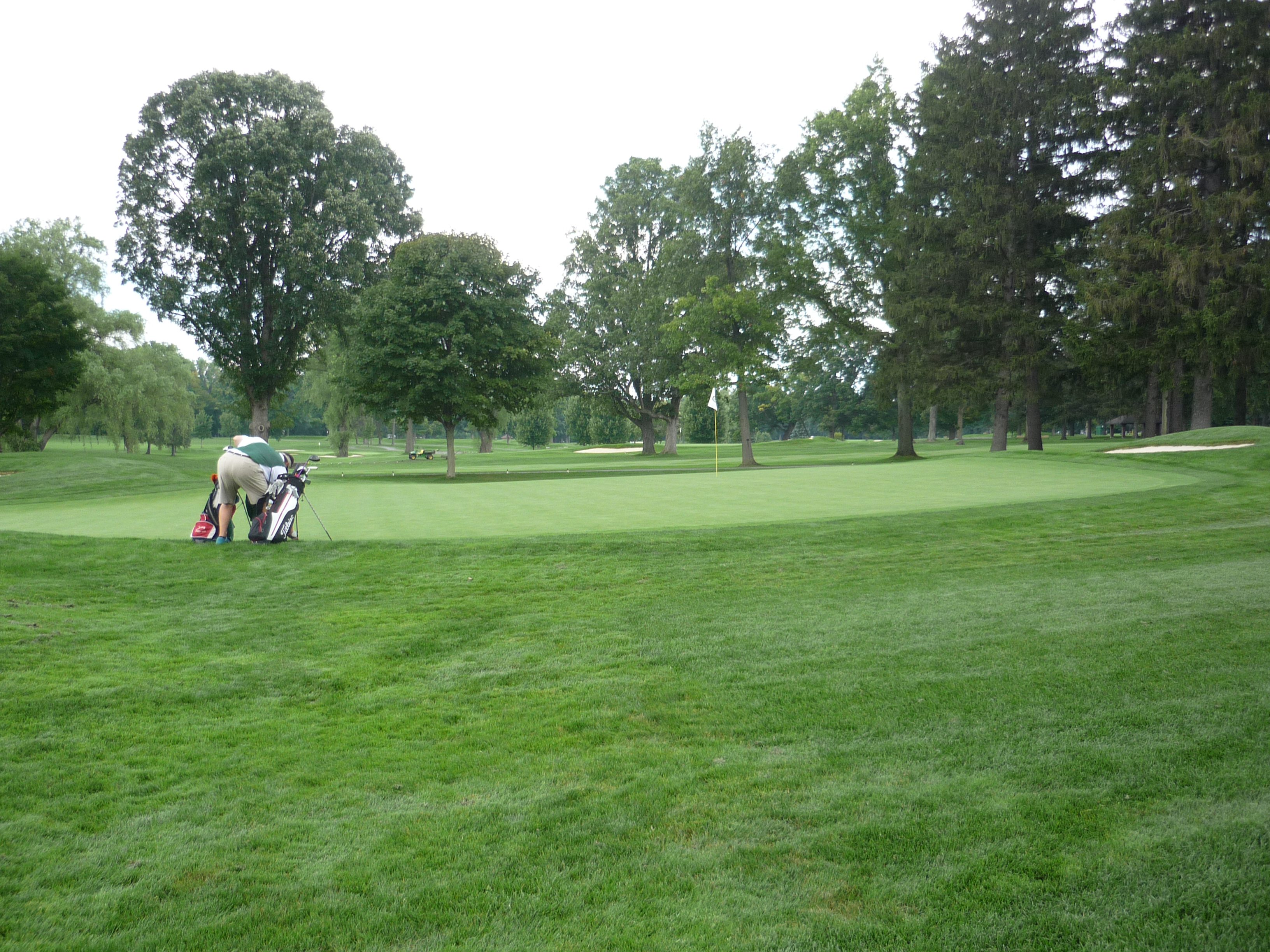
Hole 2 – 361 yards – Par 4 – Breather
The second hole offers just what its name implies. It is a breather after the tough opening hole. You need to keep your drive up the center or left side of the fairway. It is uphill all the way.
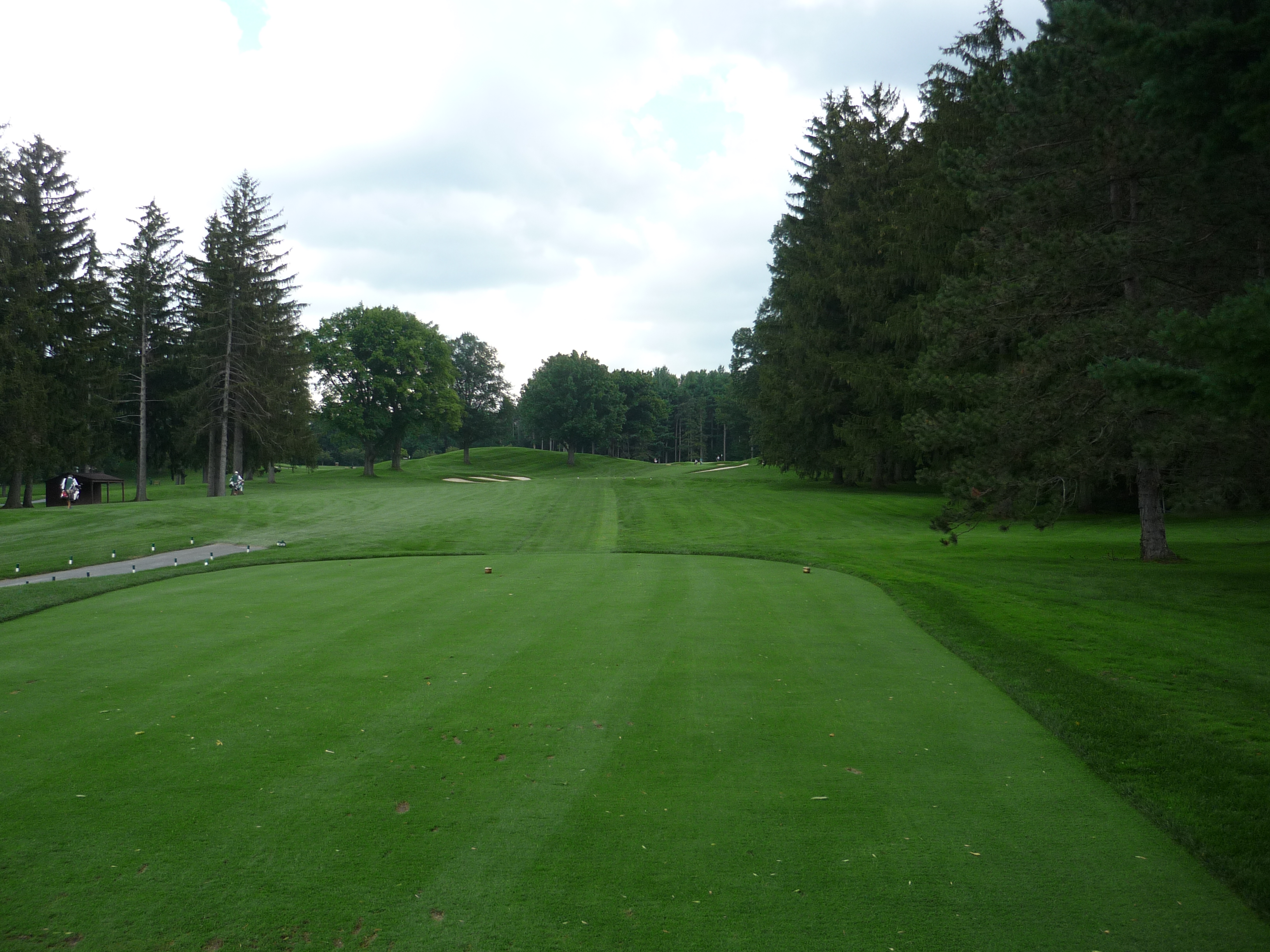
The approach shot plays uphill to a raised green. This one looked like quintessential Ross to me. There are three bunkers around the green ready to scoop up errant shots.
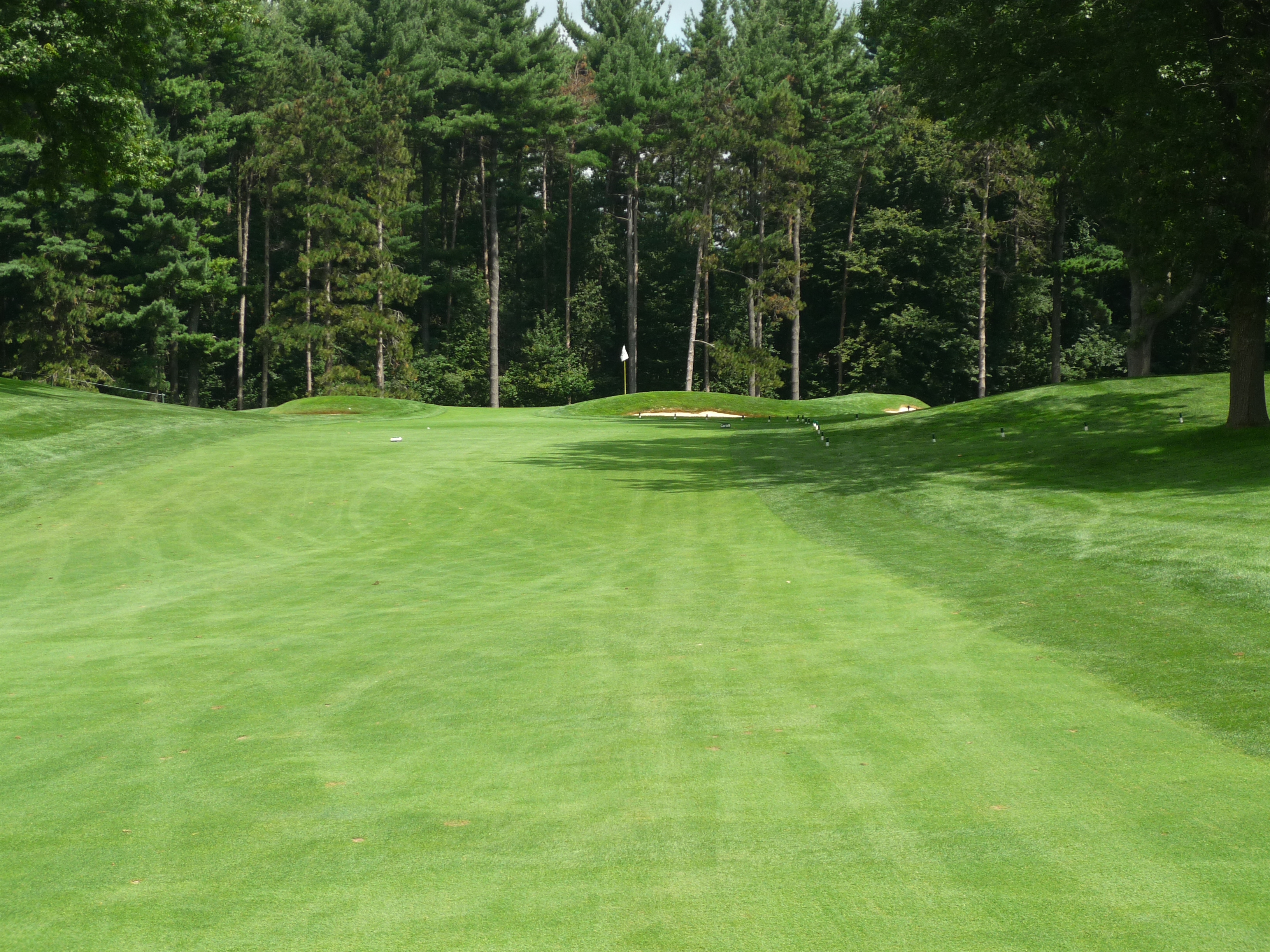
Here is the putting surface and the gnarly lie I was faced with.
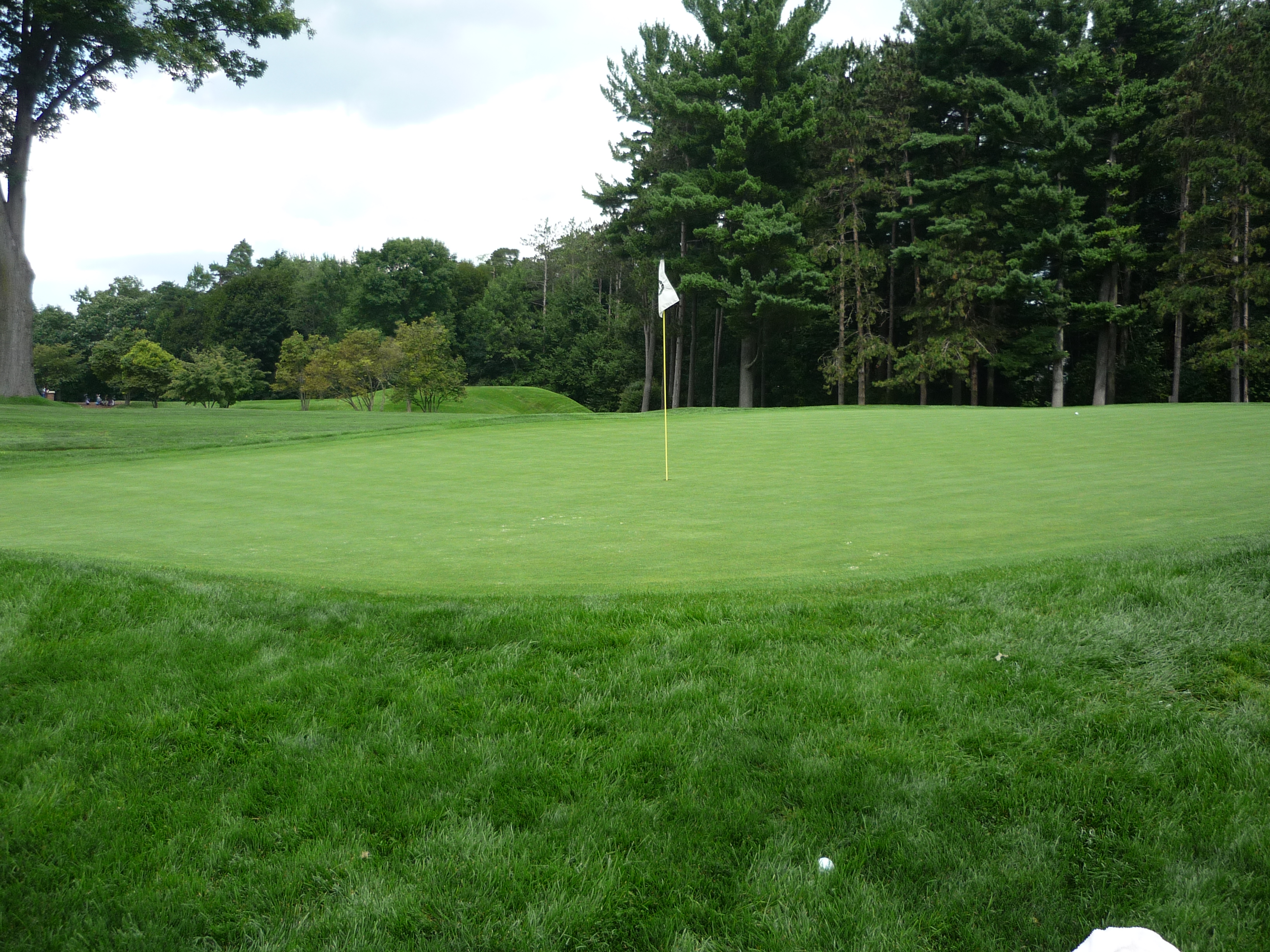
Here is a wider shot to show the whole green.
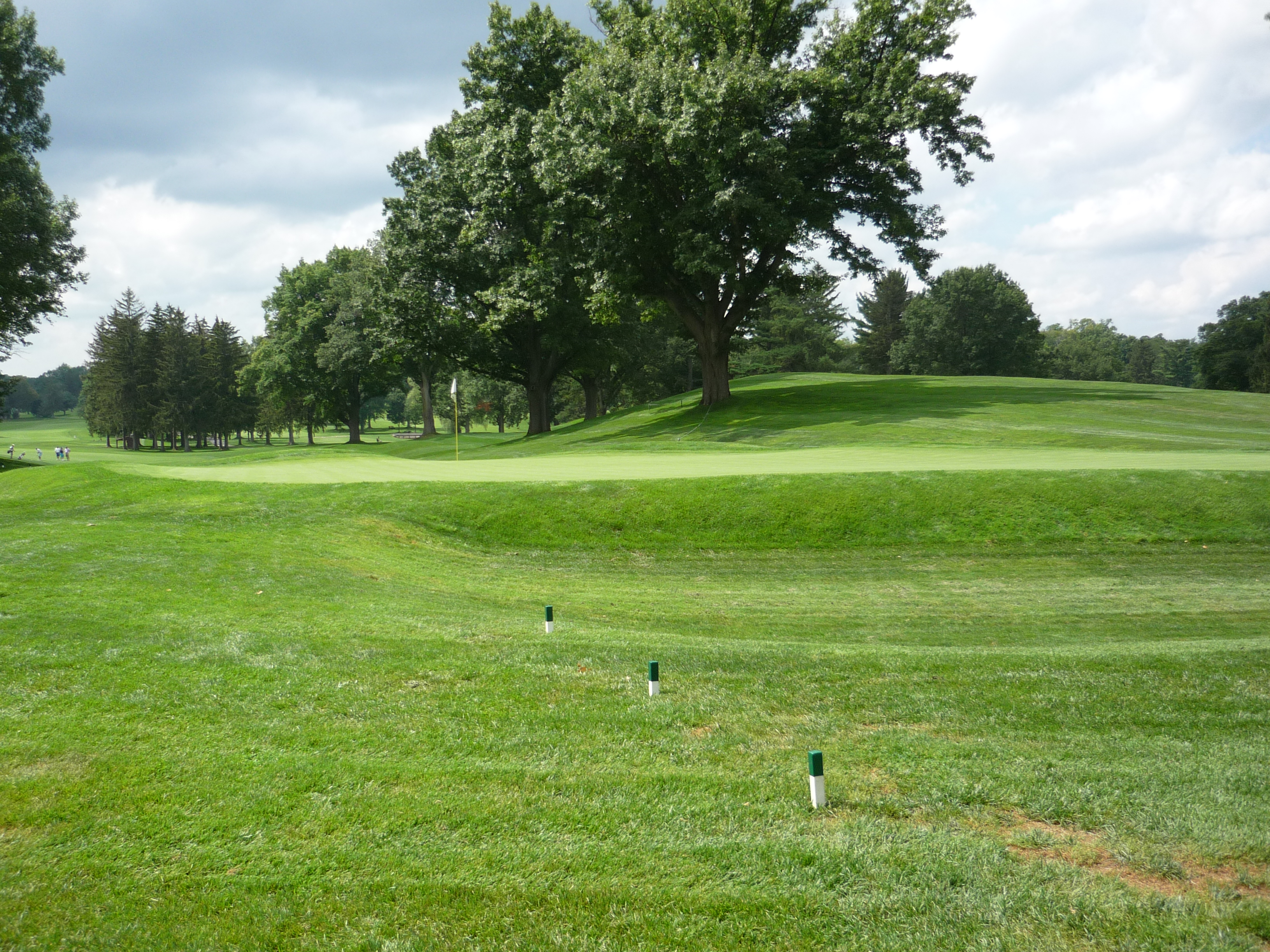
Hole 3 – 176 yards – Par 3 – The Pines
I loved these tee collection boxes. I wish more courses would use these to keep tee boxes clean. You can also see that the tee markers are acorns.
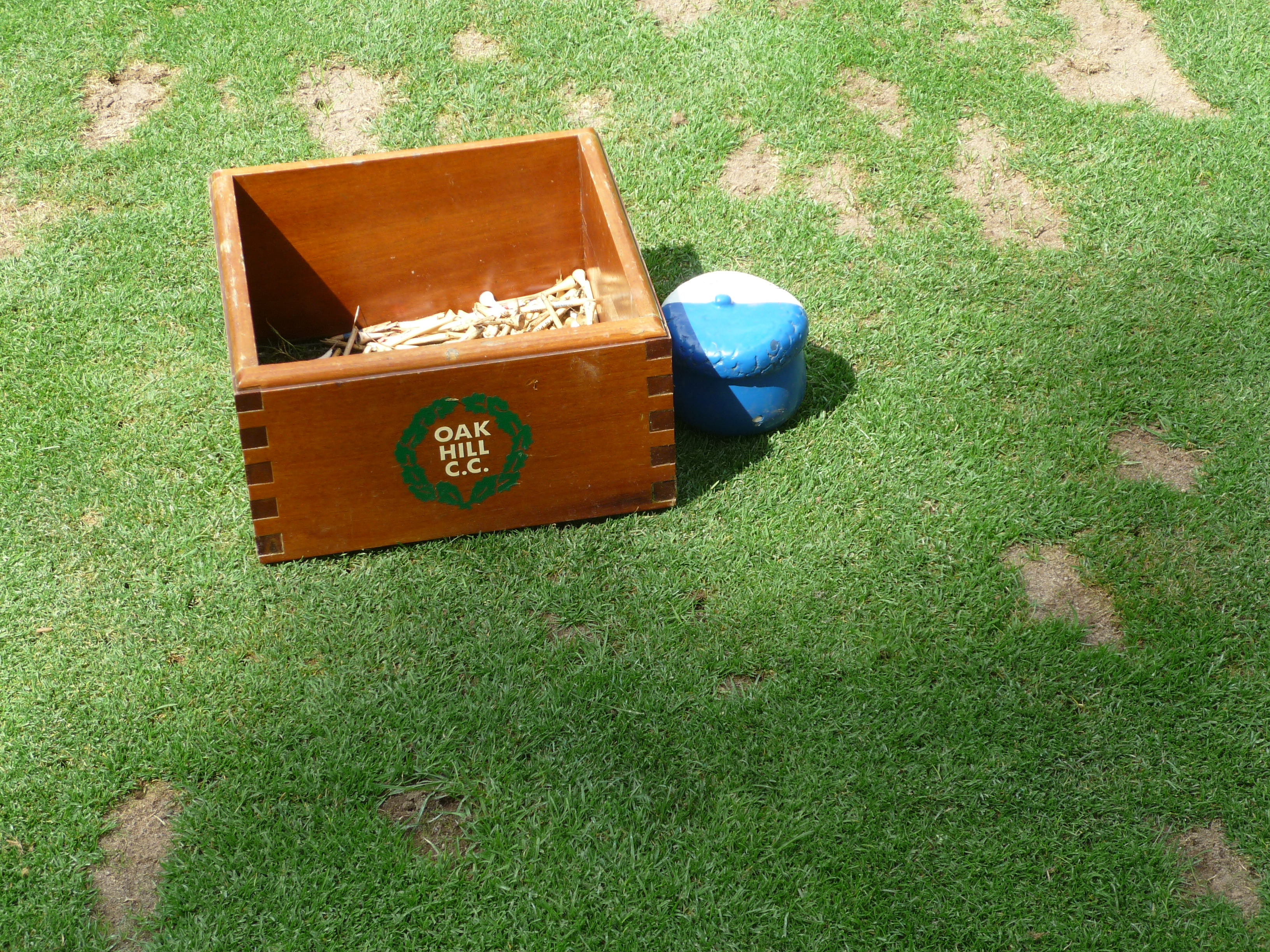
There are plenty of bunkers on this hole that are very deep. You don’t want to miss long or right. The tree is definitely in play if you pull your tee shot.
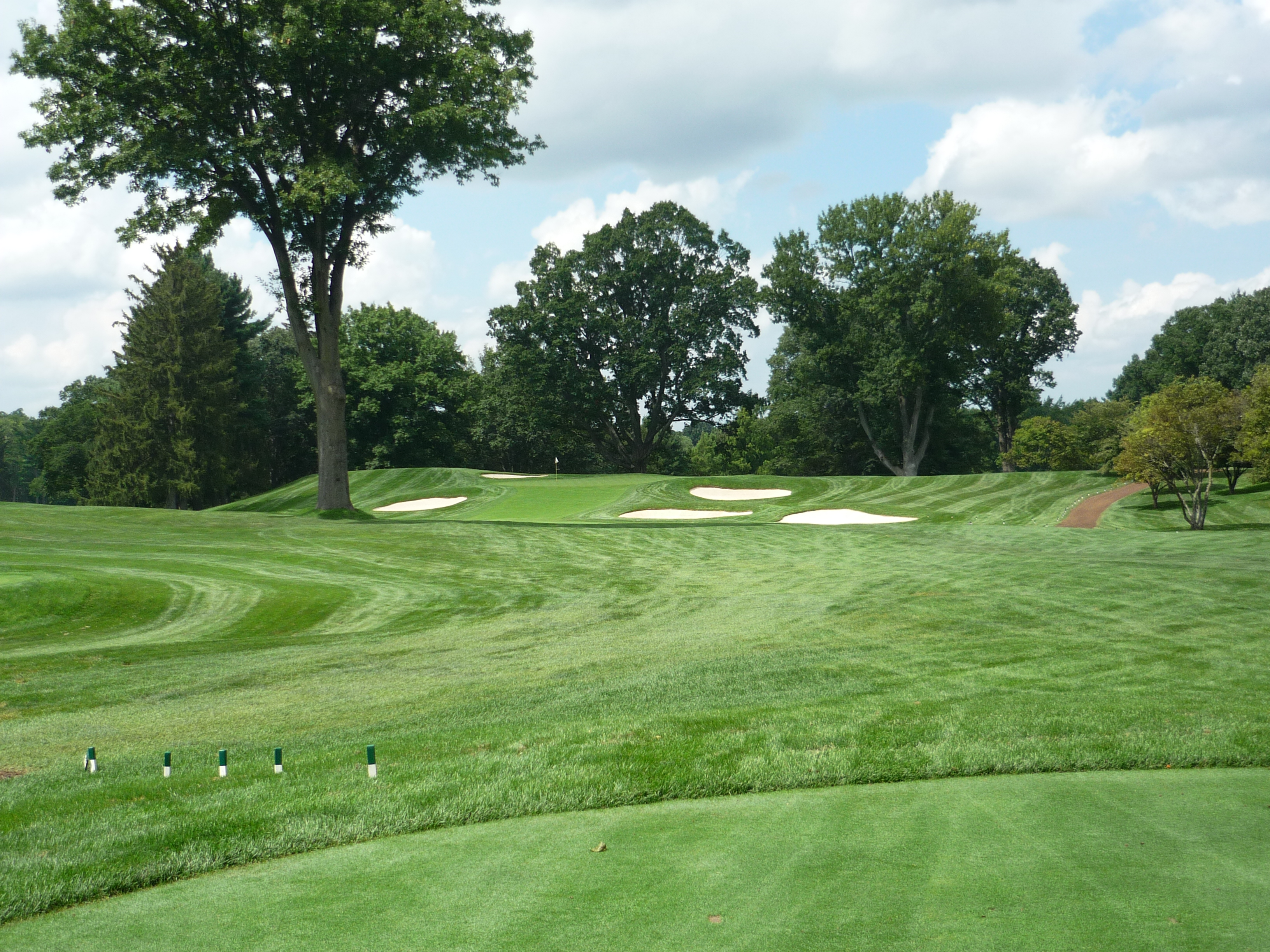
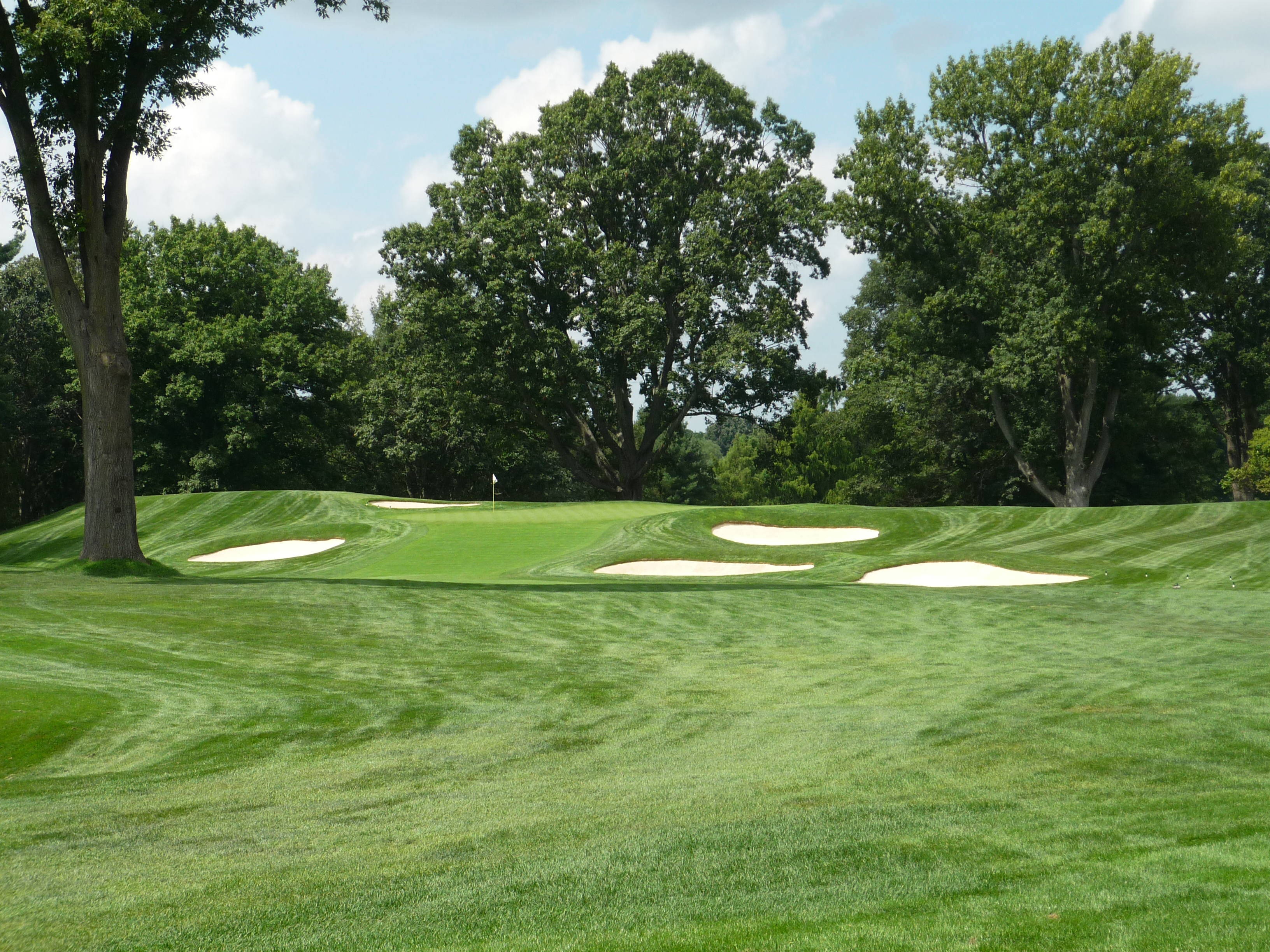
The green has a false front and is definitely treacherous.
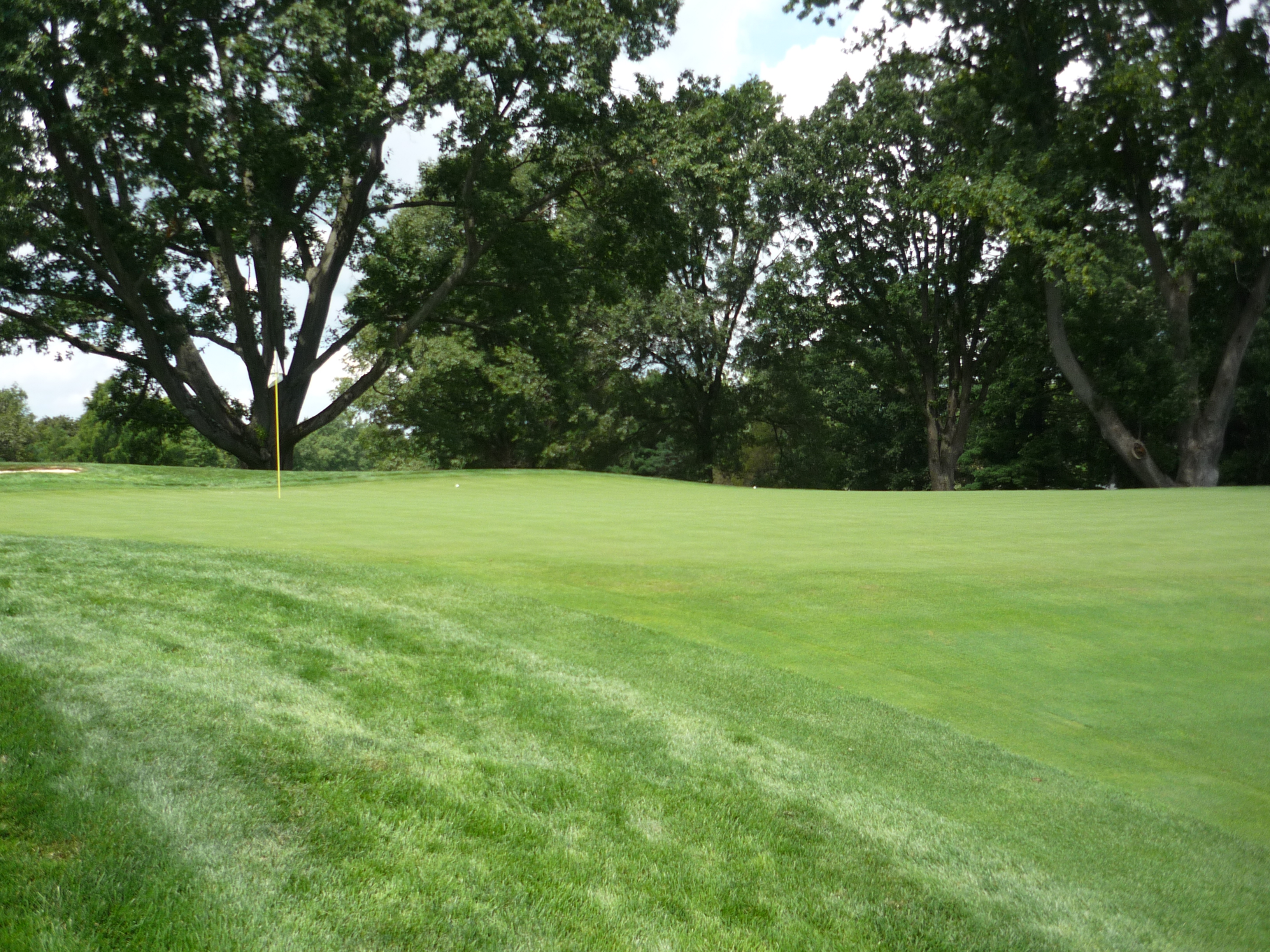
This other angle shows the slopes in the green.
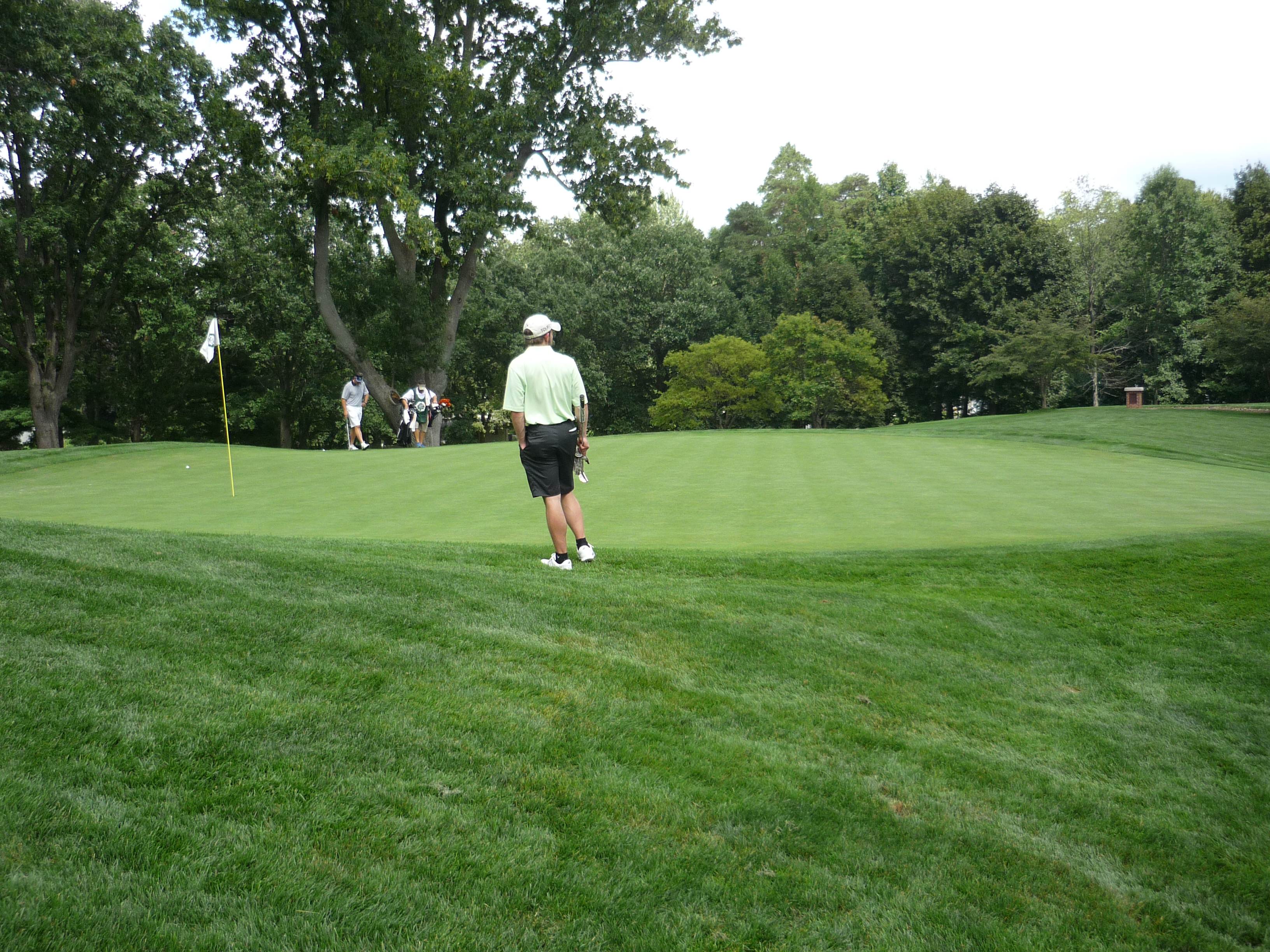
Hole 4 – 542 yards – Par 5 – The High and Mighty
This is a tough driving hole with bunkers and out of bounds guarding the right side. A power fade is the best shot shape from this tee.

The second shot plays through some of Dr. Williams’s trees. A draw up the right side of the fairway will leave you with a solid approach.
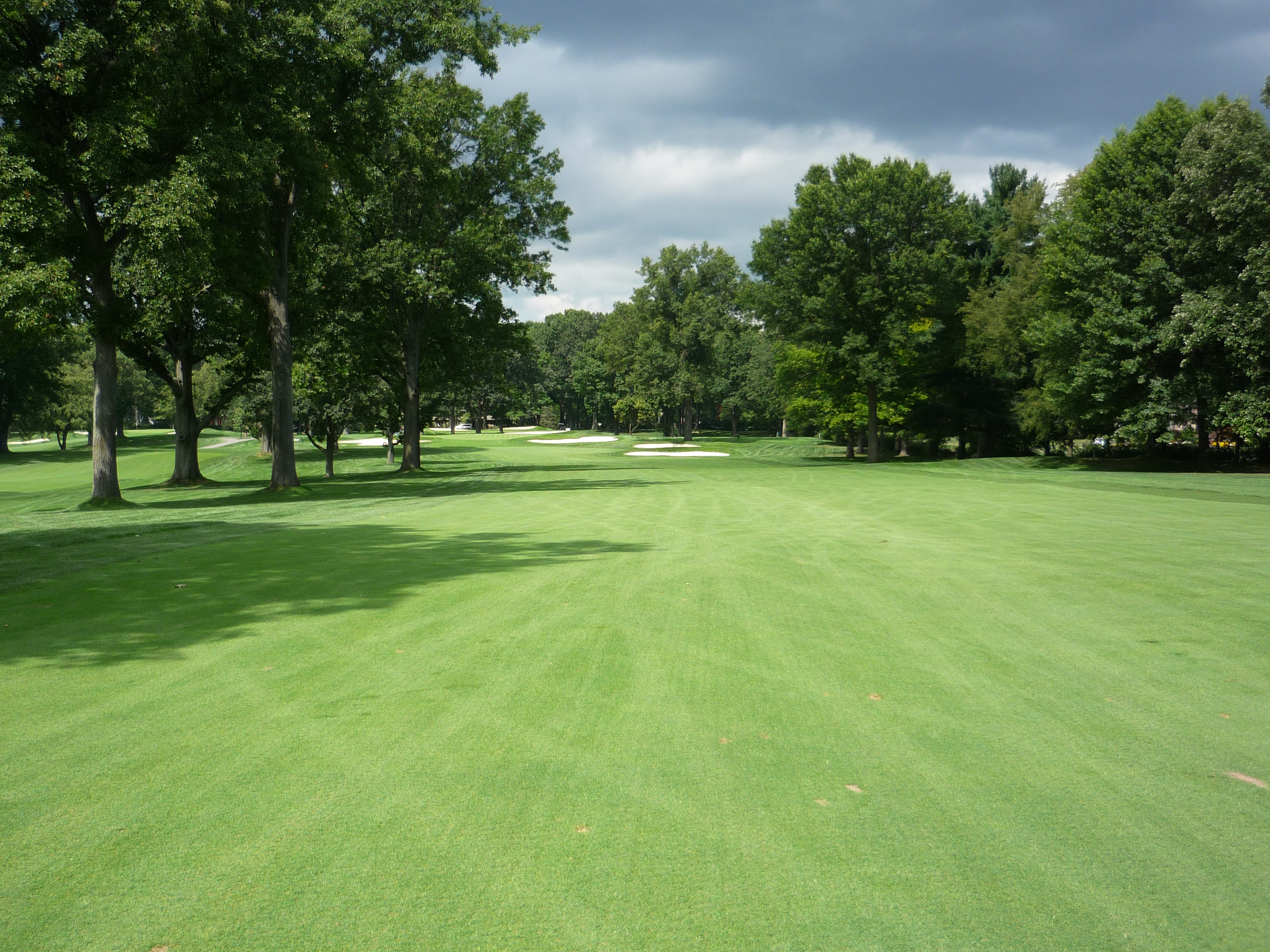
The approach shot to the green is not too hard if you have a wedge in your hand. You will want to avoid going long.
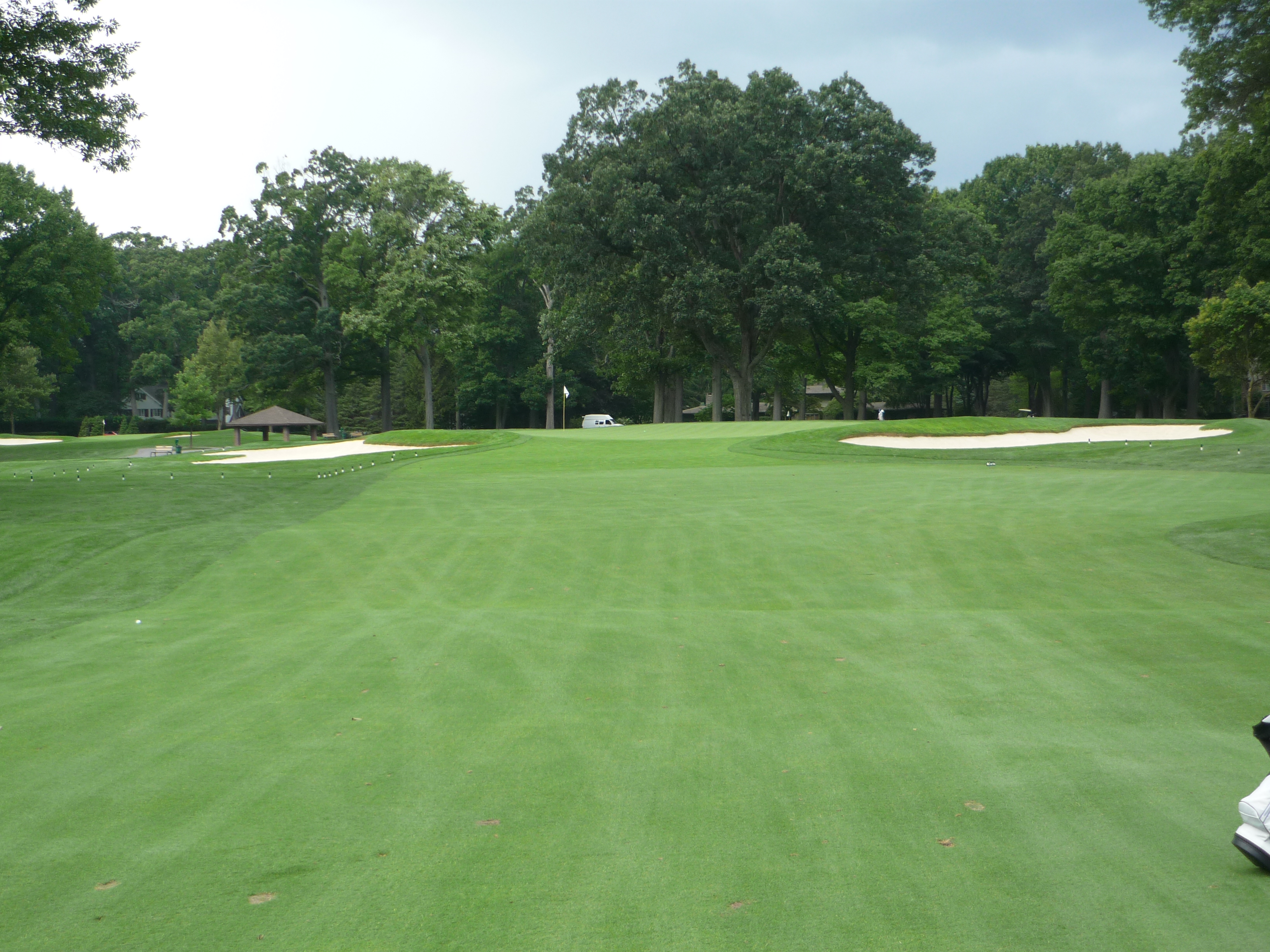
Below is the green.
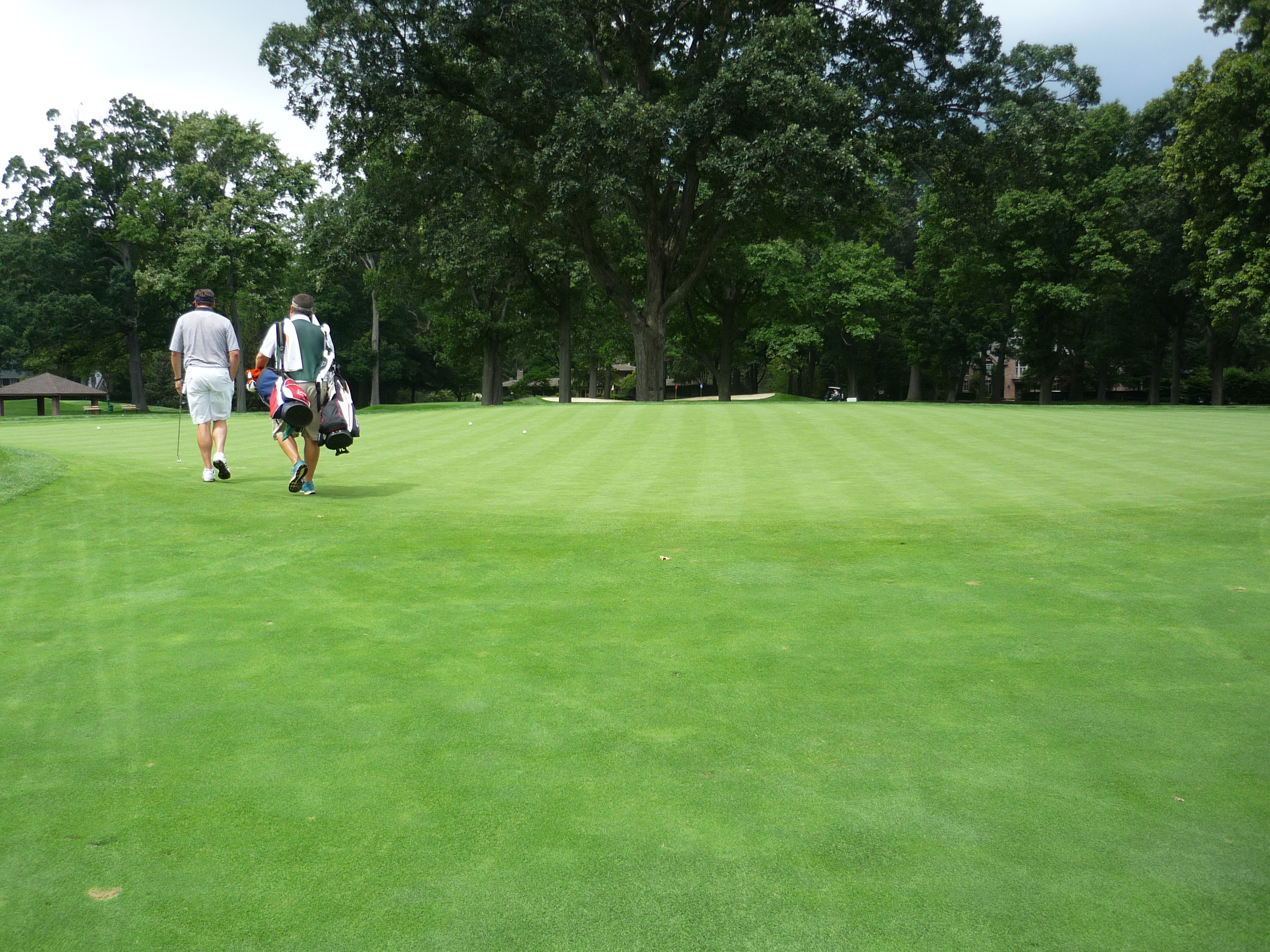
Hole 5 – 406 yards – Par 4 – Double Trouble
The name of the hole relates to the creek coming into play off the tee and on the approach. You have to split the trees with your tee shot.
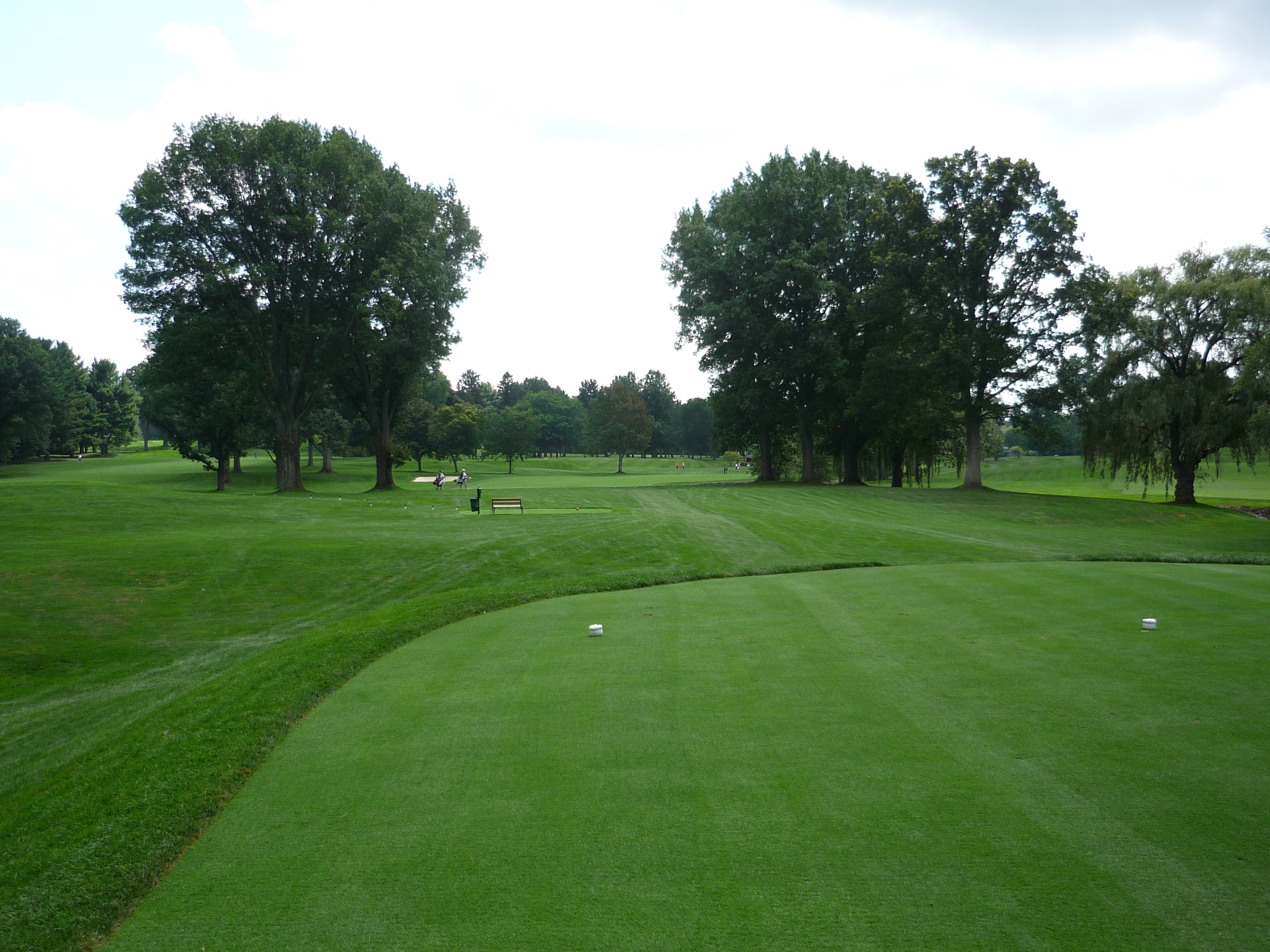
The approach must clear the creek and land on a shallow green. There is deep rough all around the green.
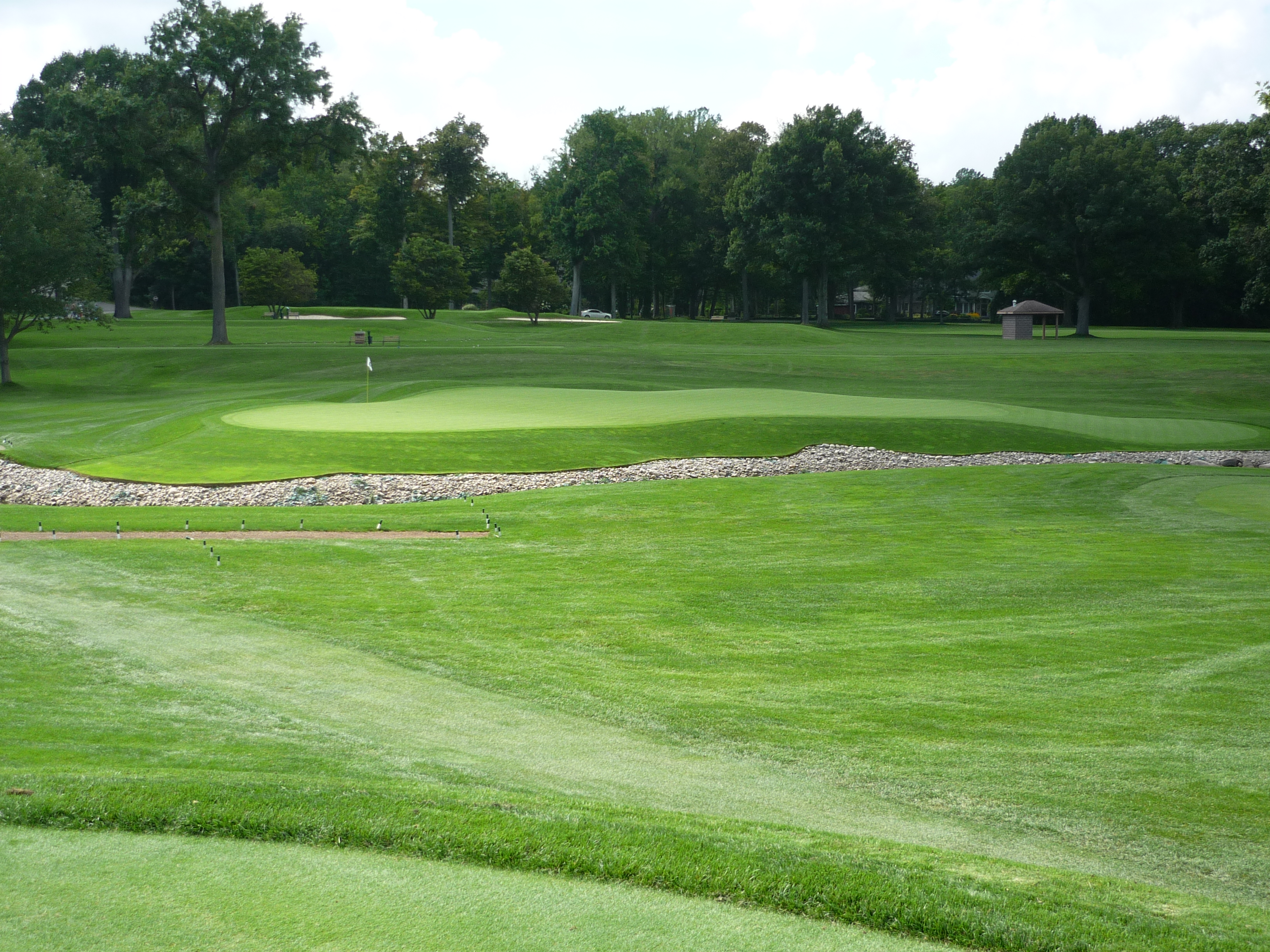
Hole 6 – 139 yards – Par 3 – Pin Point
This short hole is guarded by a creek that wraps around everything but the right side. In the 1989 US Open four hole in ones were recorded here in the second round.
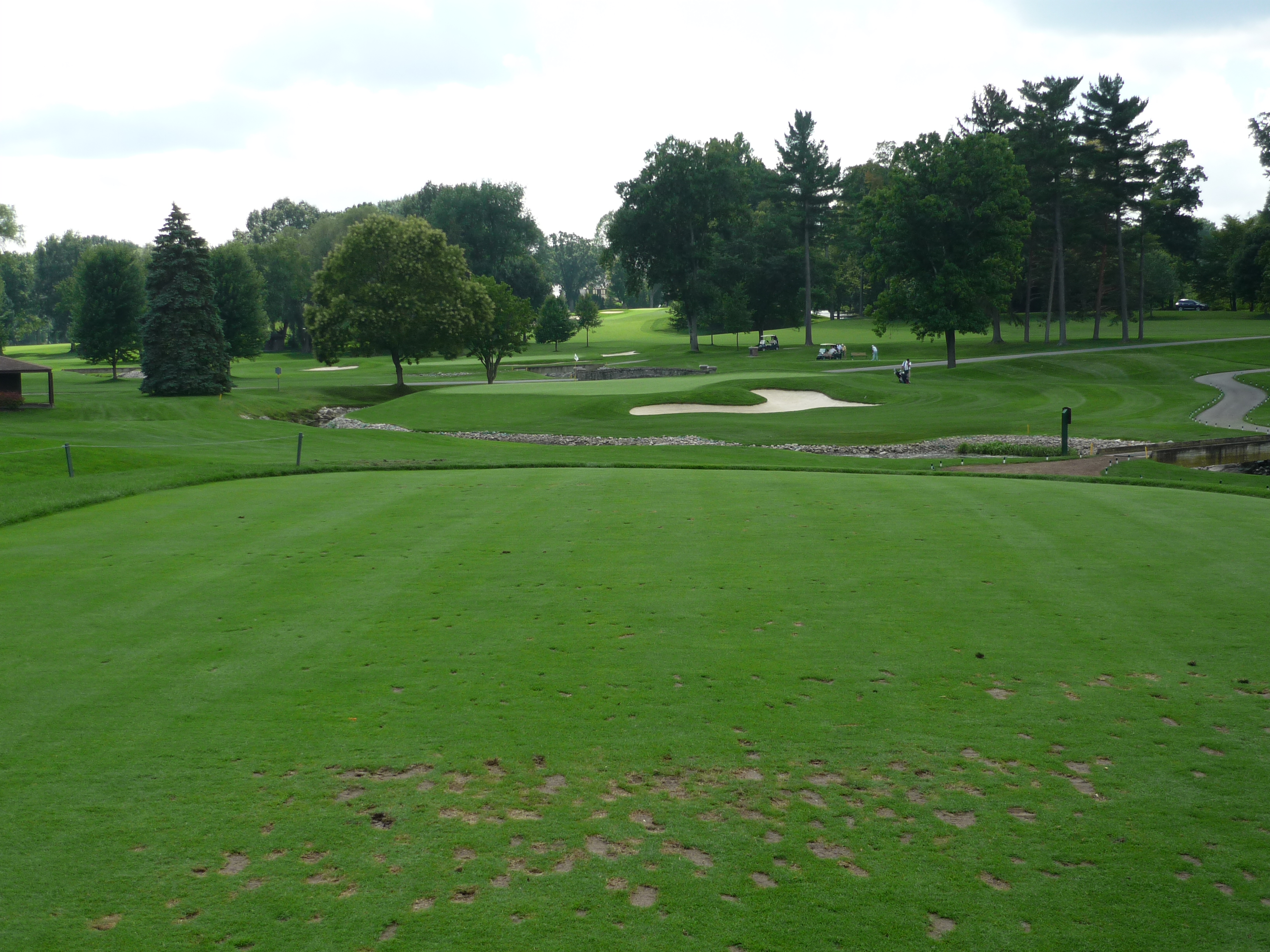
Here is a little closer look. You definitely don’t want to be chipping here.
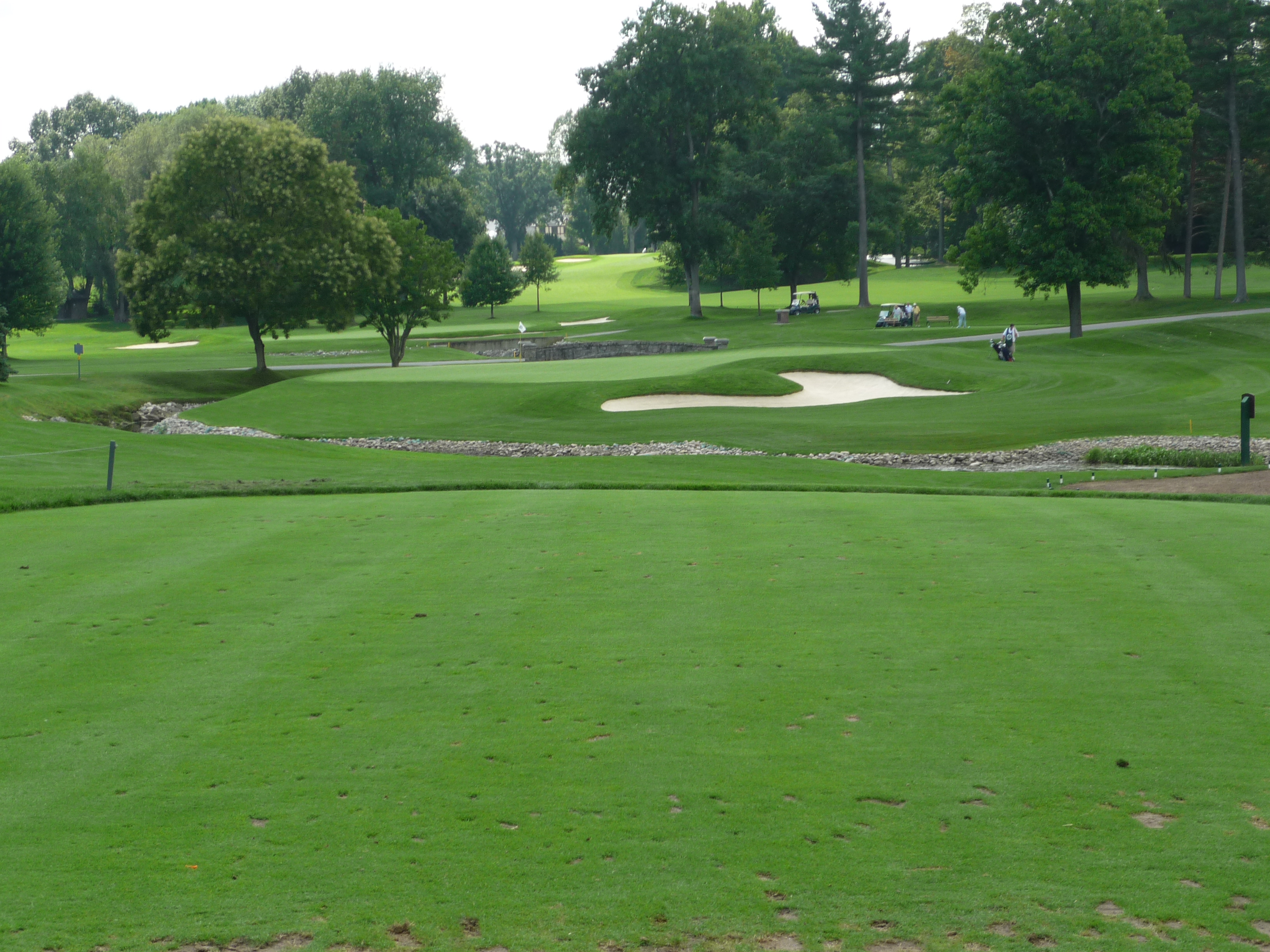
The putting surface is not overly undulating and should provide a good chance at birdie if you have hit the green.
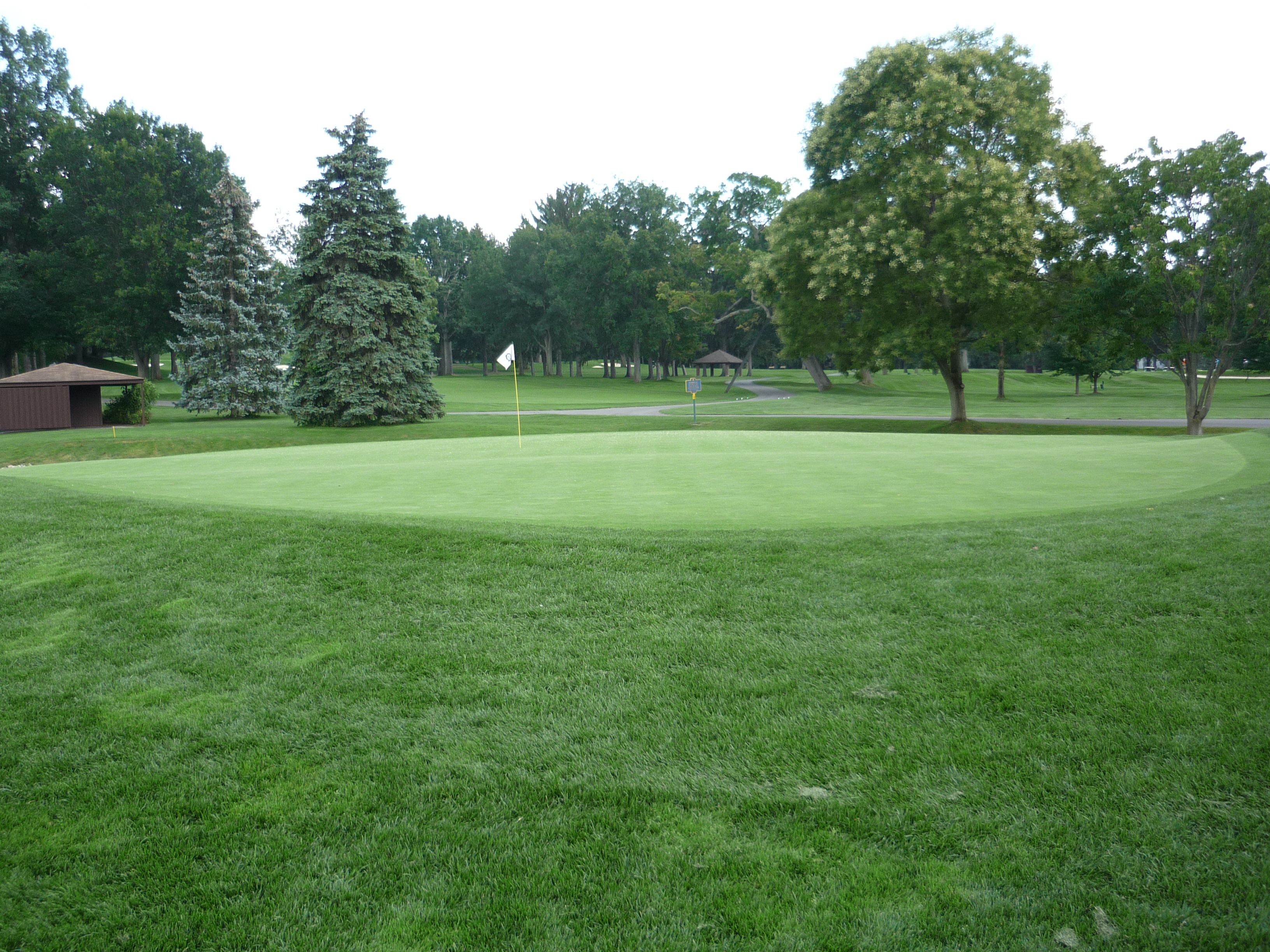
Here is the green from another angle.
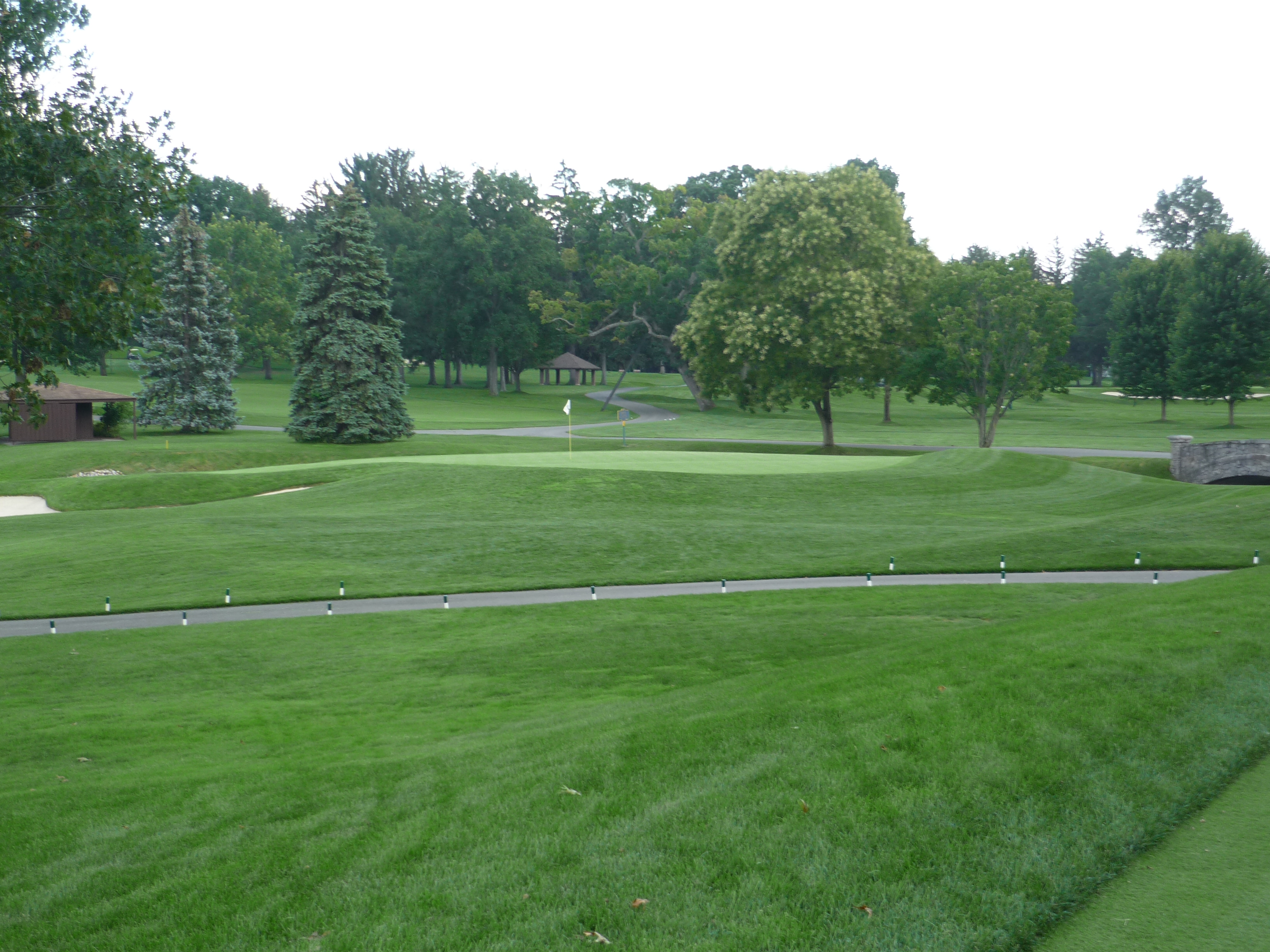
Hole 7 – 414 yards – Par 4 – Creek’s Elbow
This tee shot needs to be precise. You want to favor the left side, but the rough comes into play there as well.
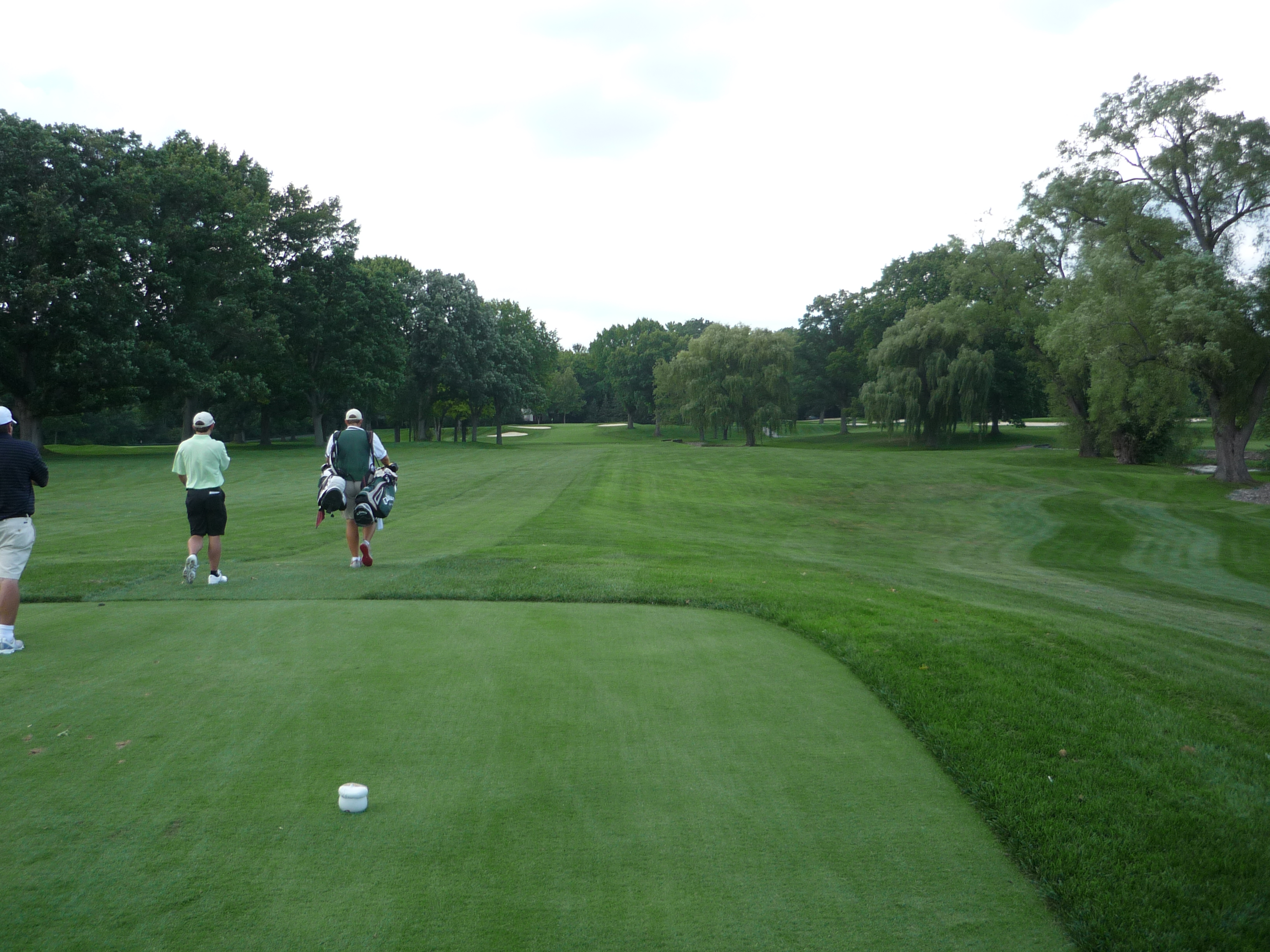
The approach shot plays over the creek to a raised green surrounded by three bunkers. It is a difficult approach since it is a longer hole.
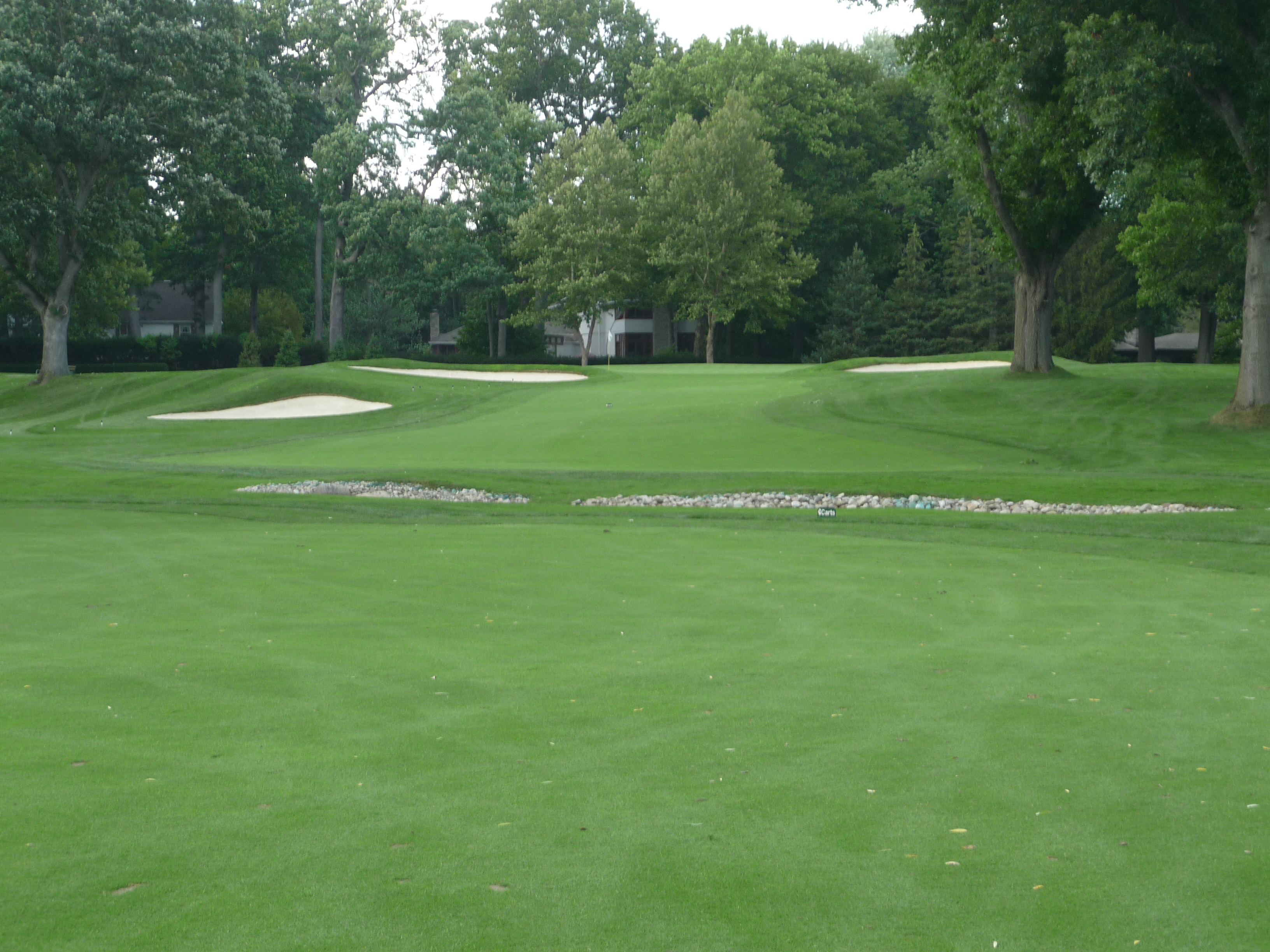
The green is open in front, but once you stray there is plenty of sand and rough to cause trouble.
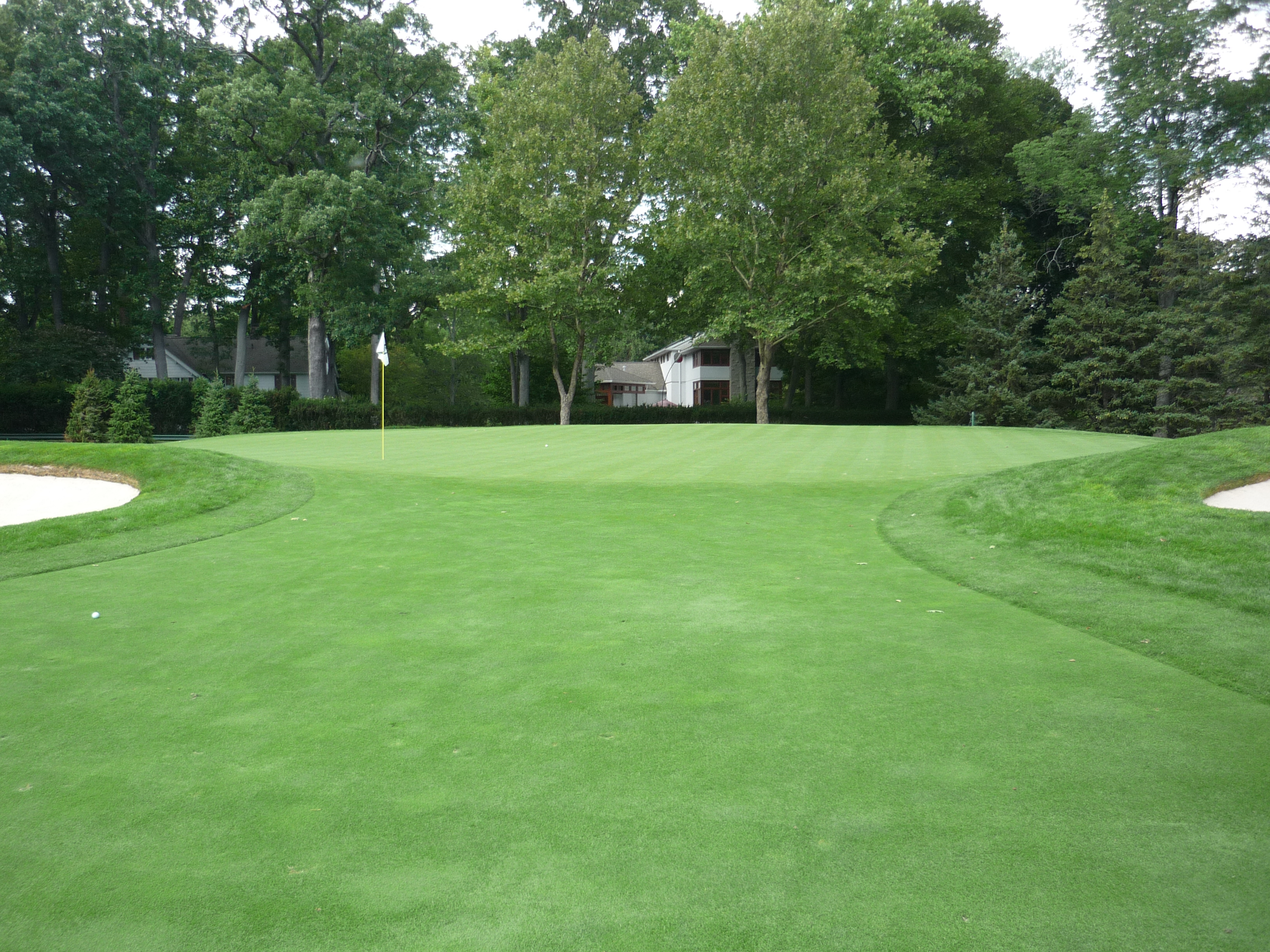
I got into the habit during this round of taking photos from multiple angles. Here is another one.
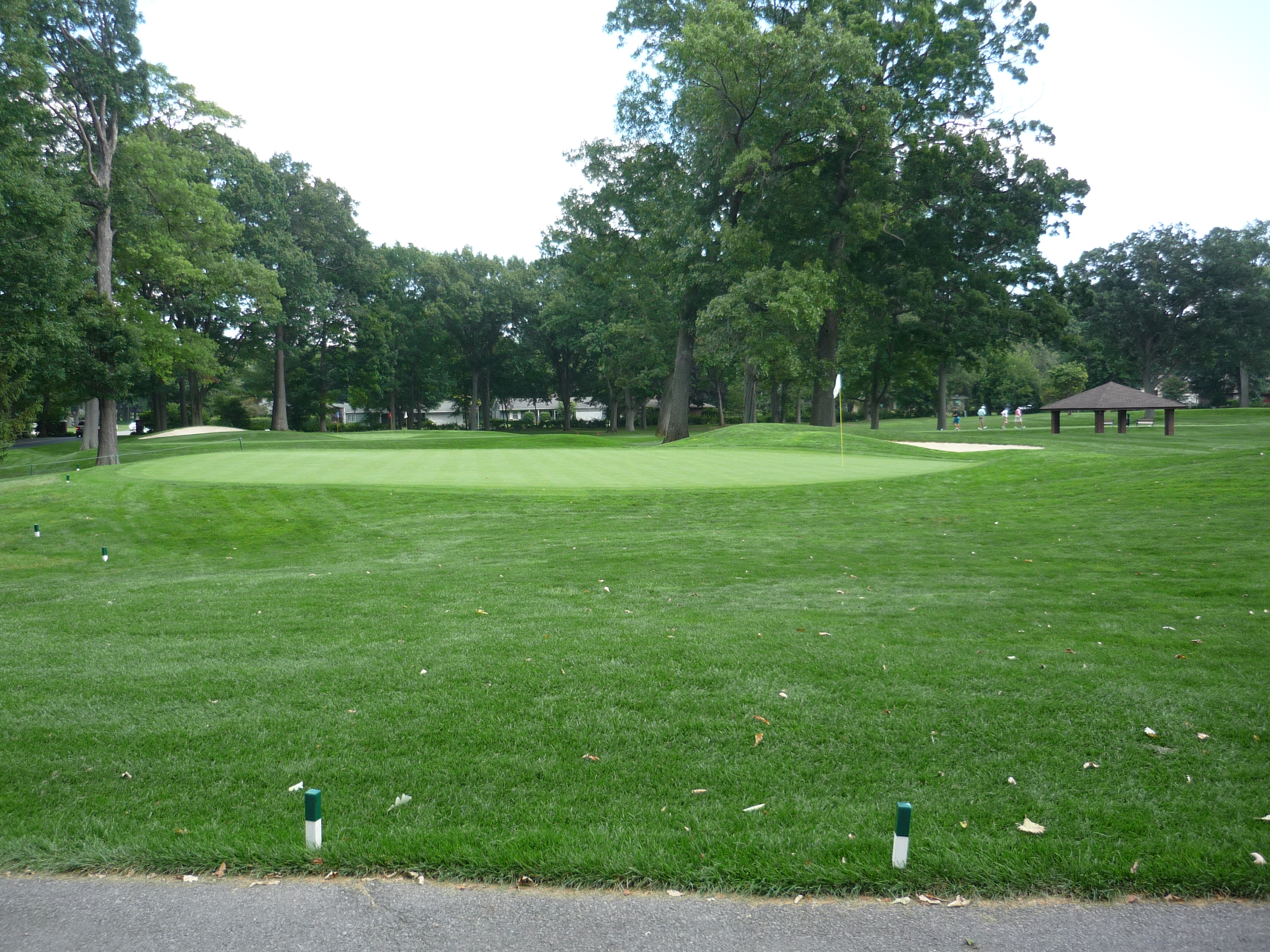
Hole 8 – 423 yards – Par 4 – Wayside
This fairway is bordered by deep bunkers on both sides. A road also runs along the right side of the hole. A long drive is essential.
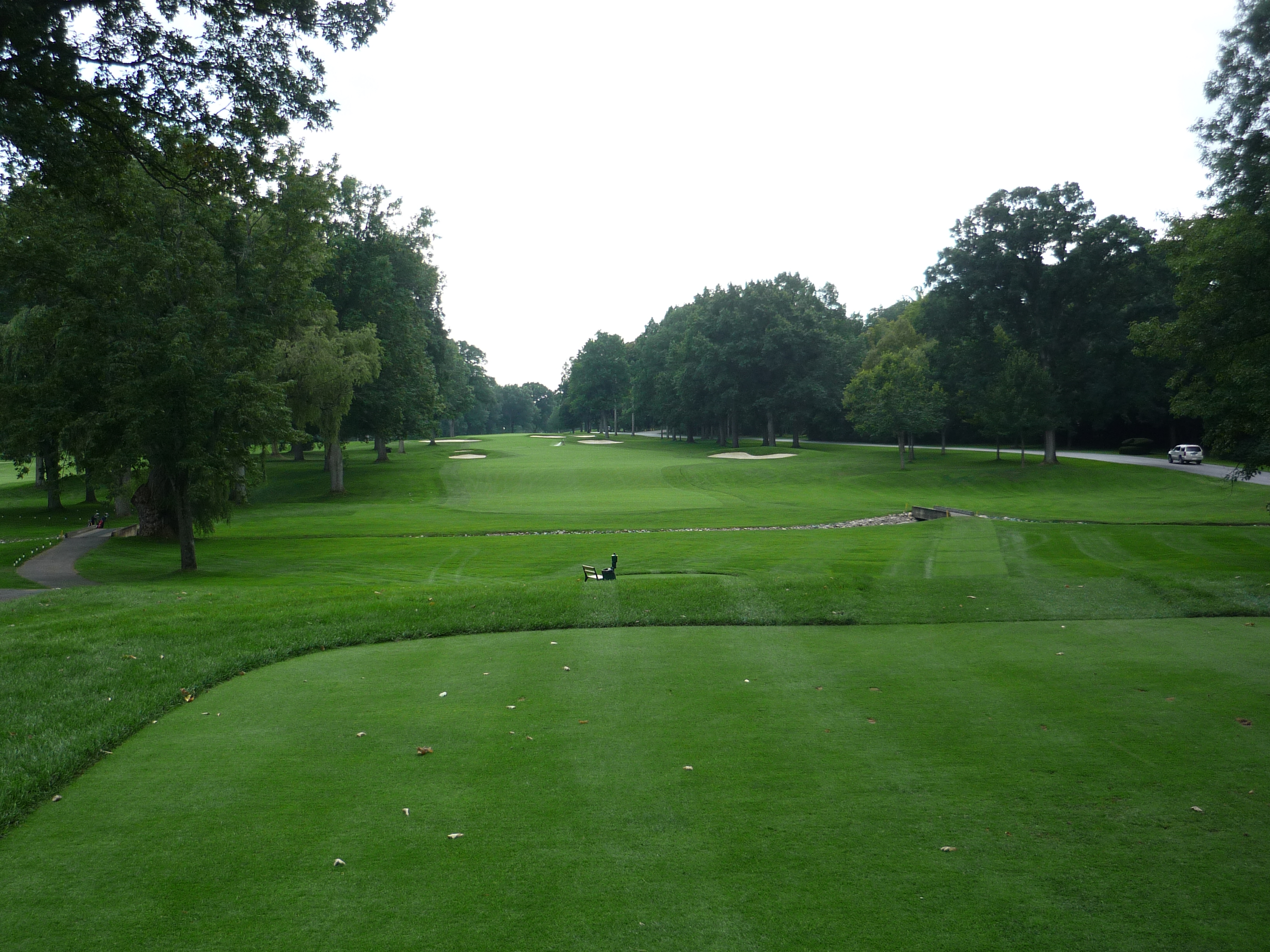
The approach shot plays uphill to another green guarded by sand.
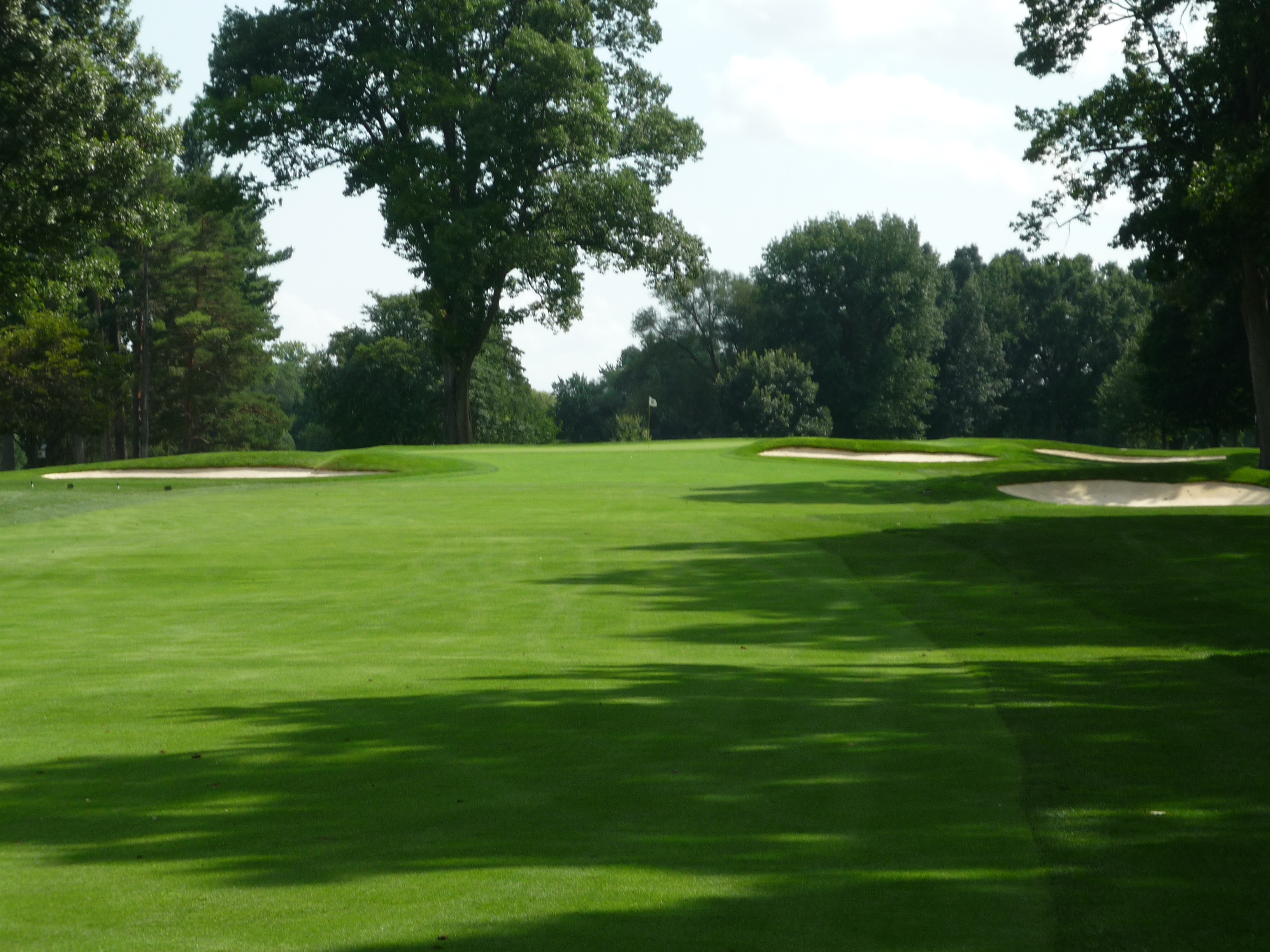
Hole 9 – 400 yards – Par 4 – Needle’s Eye
This is another difficult tee shot. The hole doglegs to the right and plays uphill. Play a fade off of the bunker for the best approach shot.
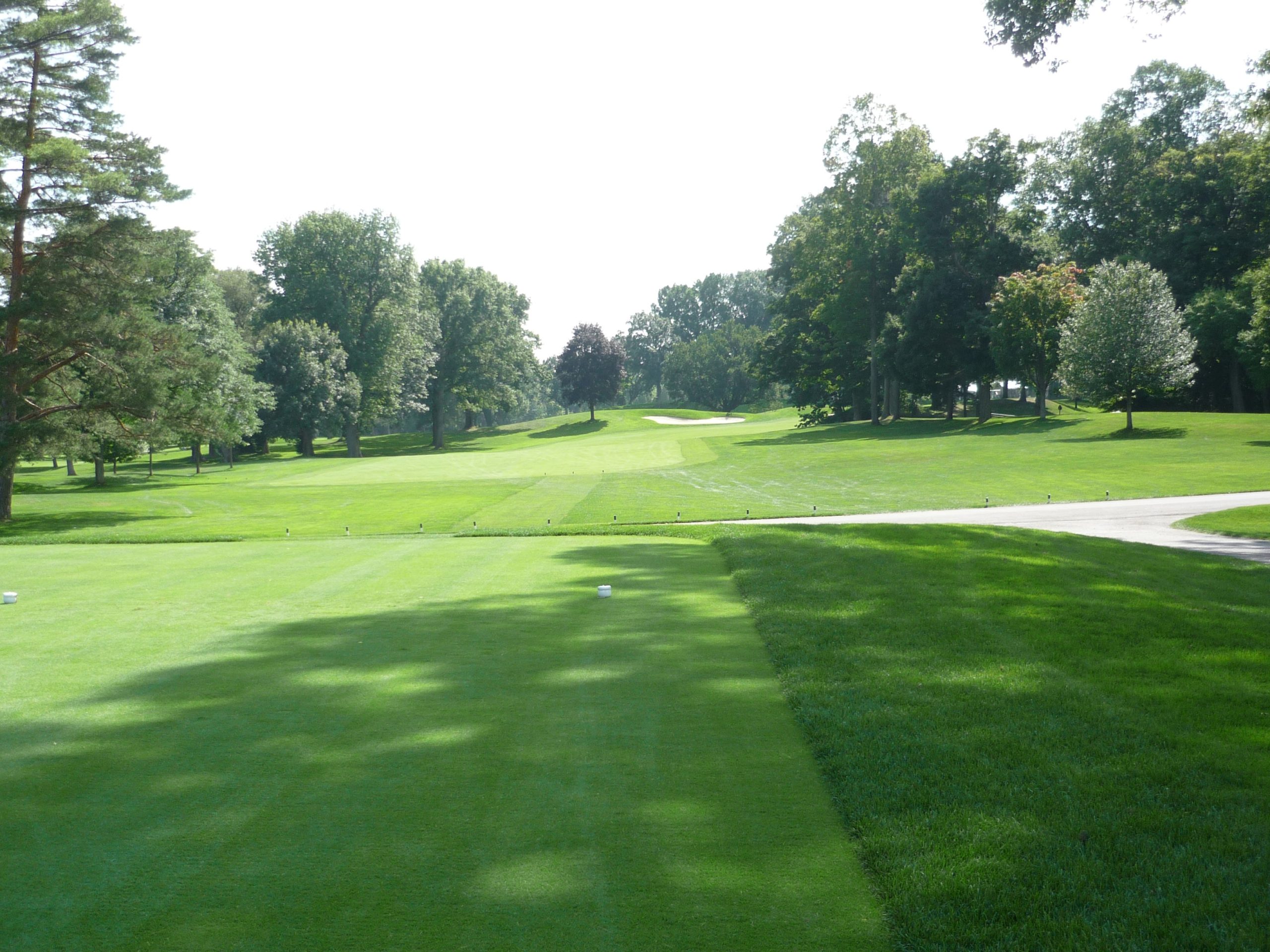
The green is fronted by two bunkers and is slightly raised. You will want to carry it all the way to the green though.
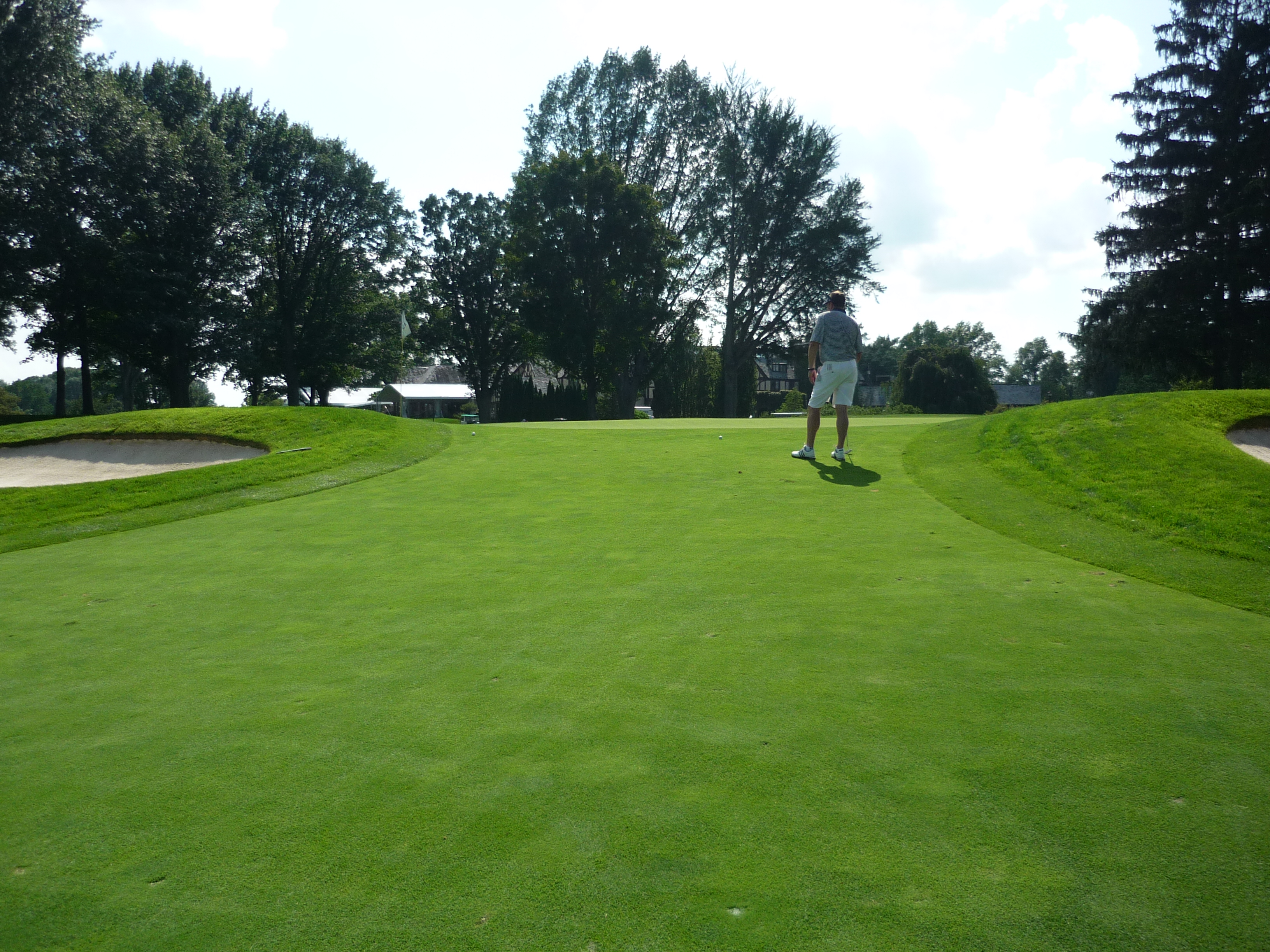
Here is another look at the front of the green. It drops off sharply on the left side.
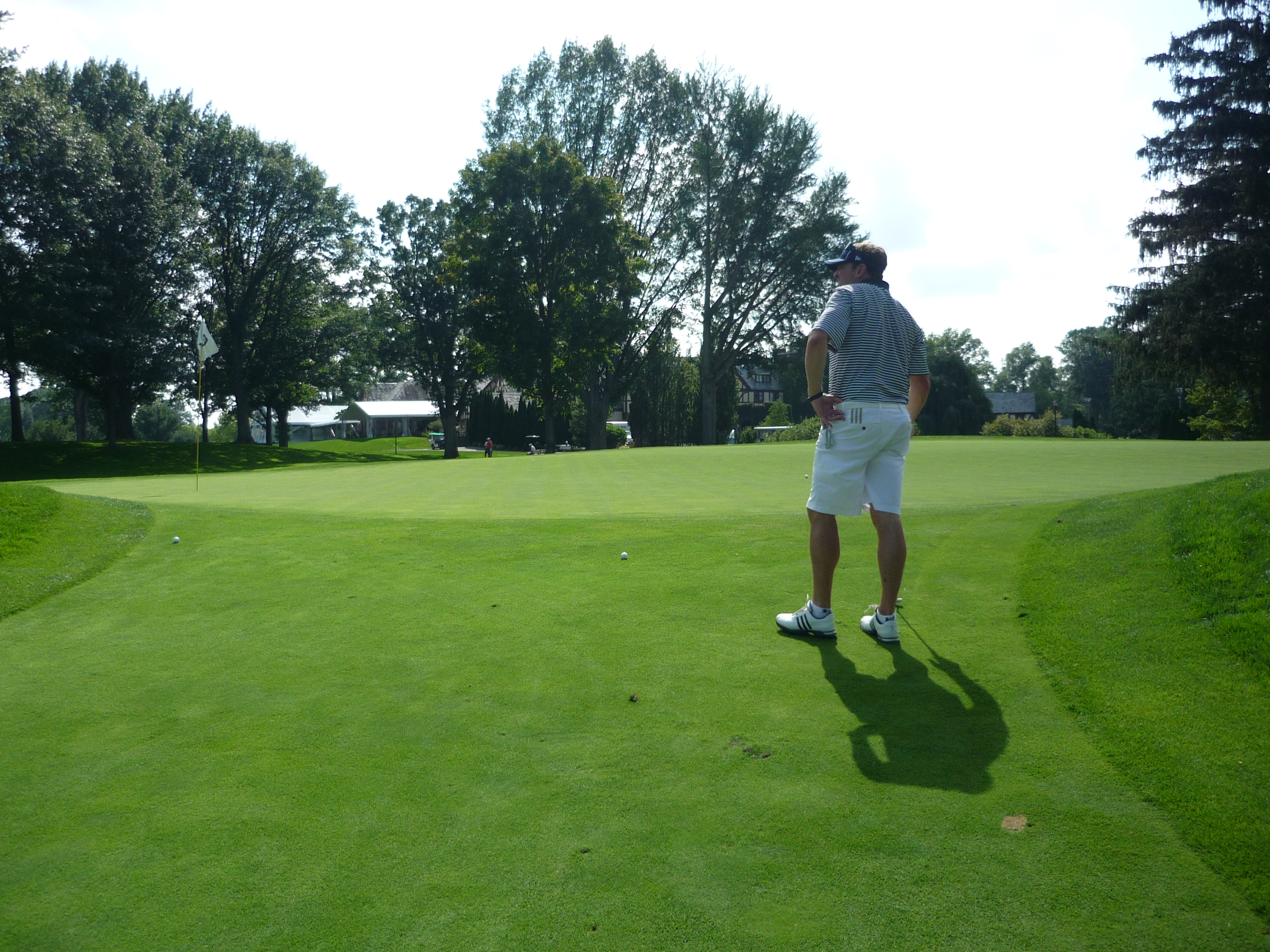
Here is another angle of the putting surface.
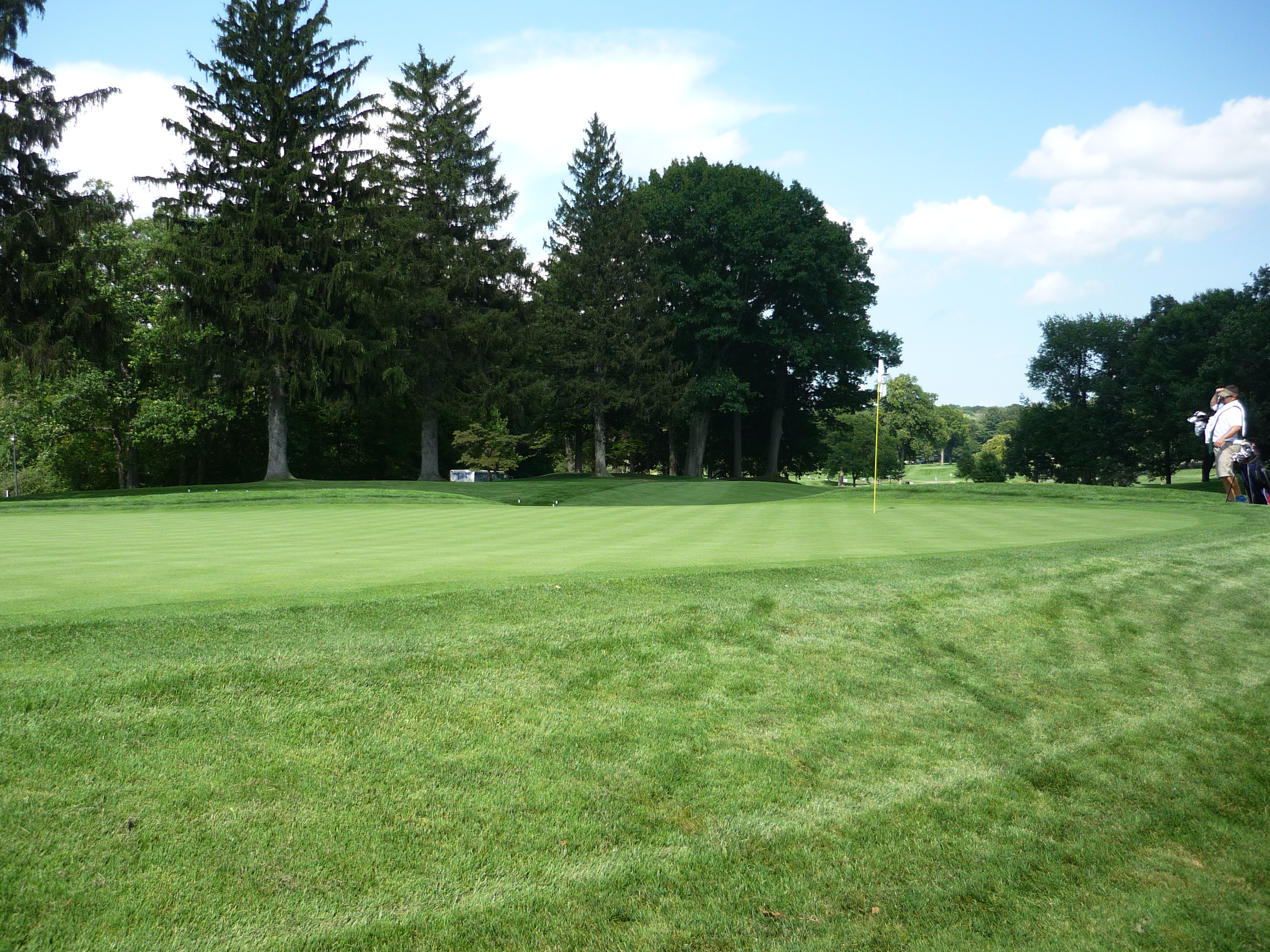
Hole 10 – 403 yards – Par 4 – Council Grove
This downhill tee shot can be very difficult. The fairway is difficult to hit due to its slope. There is a bunker on the left side of the fairway, but it can be carried with a good drive.
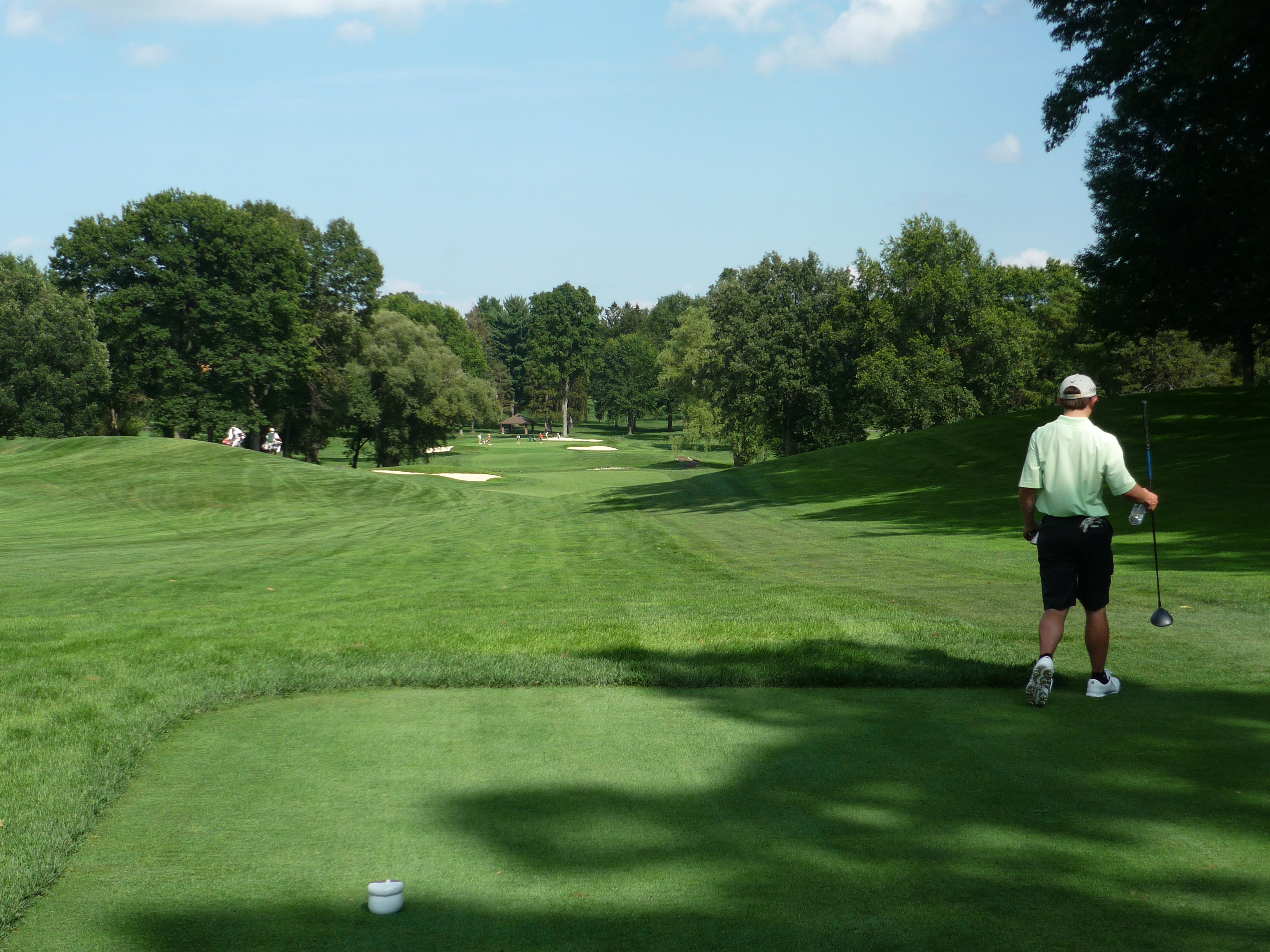
This approach is another one over the creek. The green is elevated and edged with three bunkers.
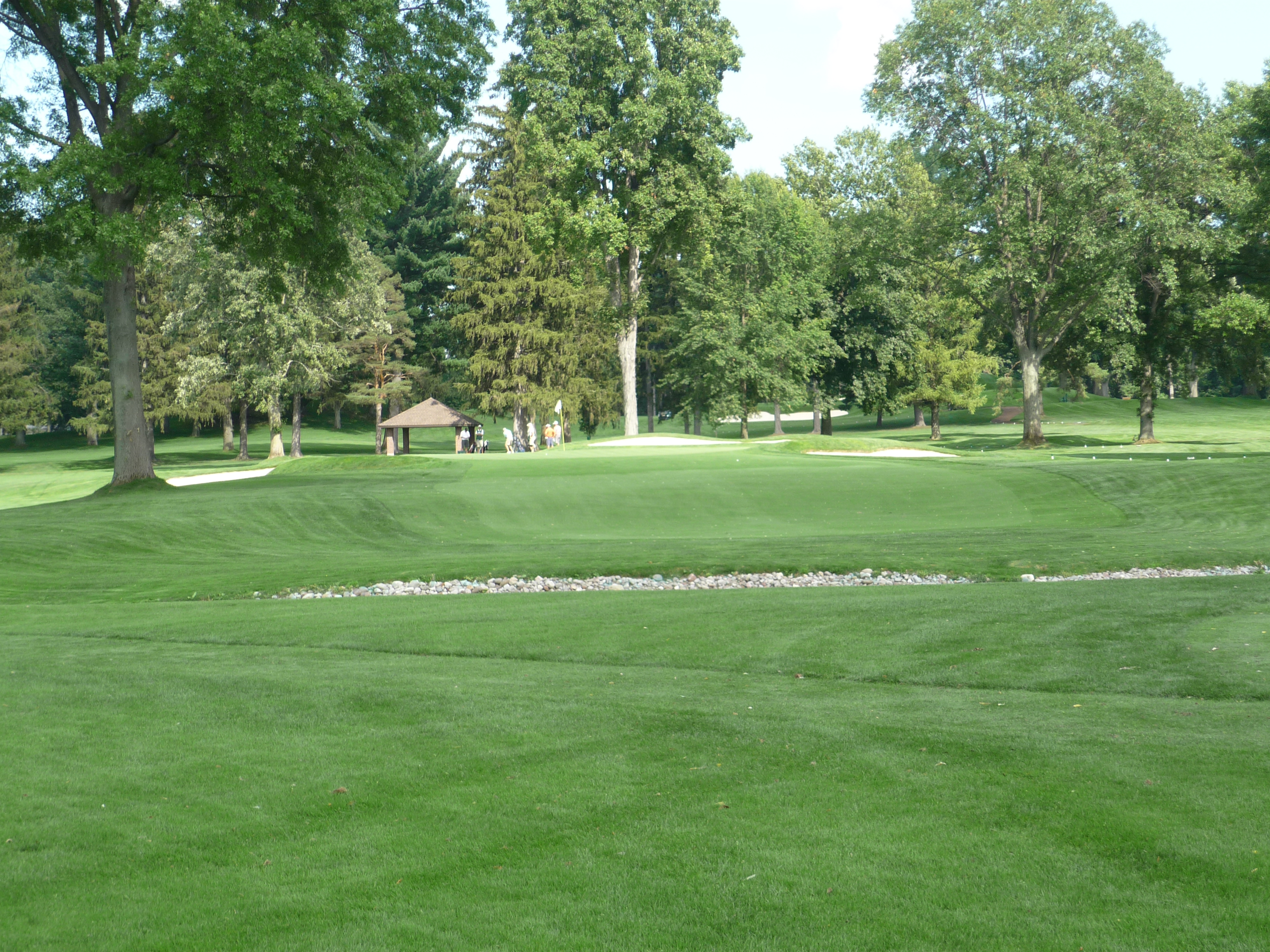
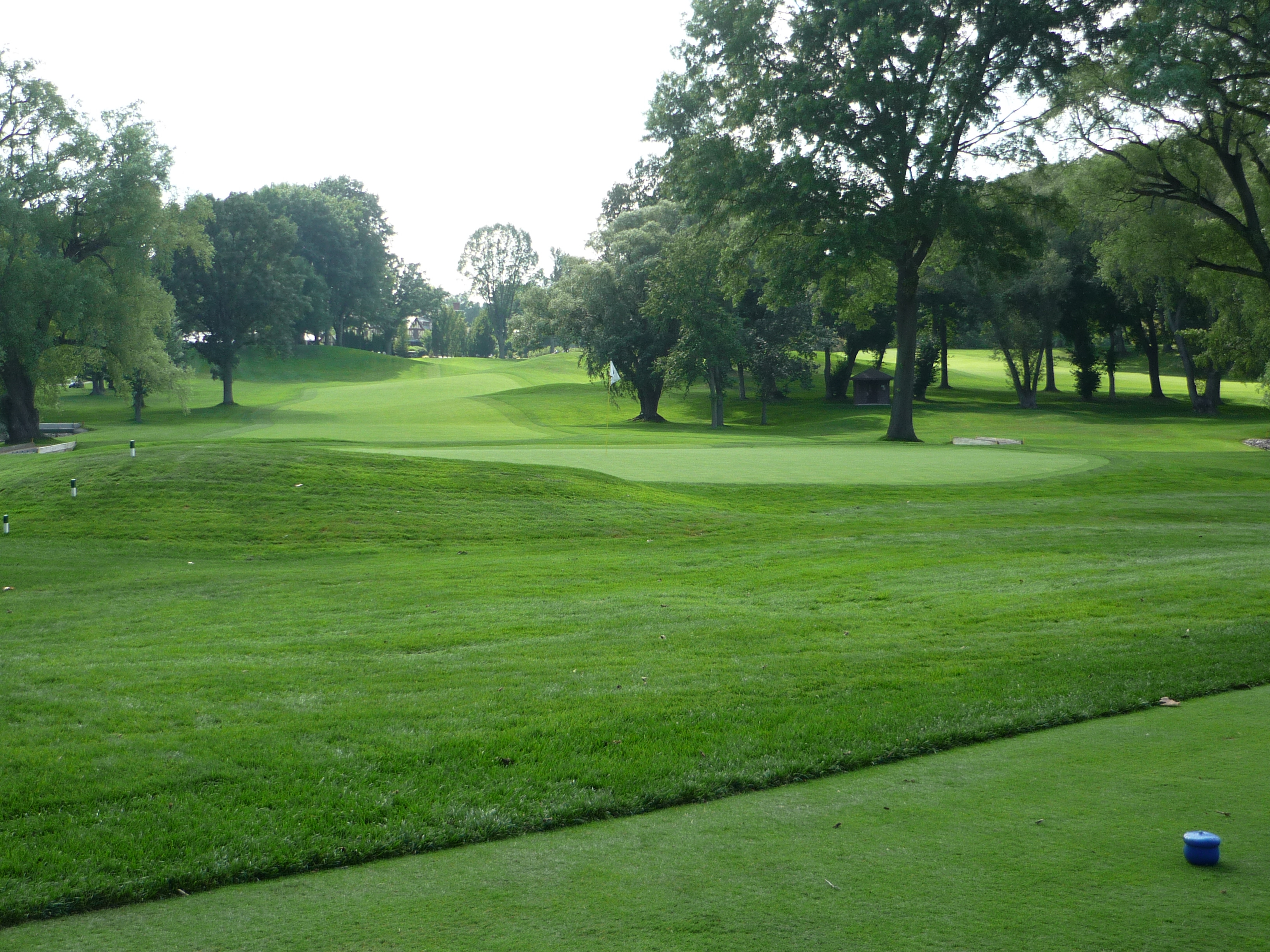
Hole 11 – 175 yards – Par 3 – Waterfall
The pesky creek is in play again. Due to the wind, this hole usually plays longer than the yardage. When the flag is middle or left the tee shot will play over the bunker.
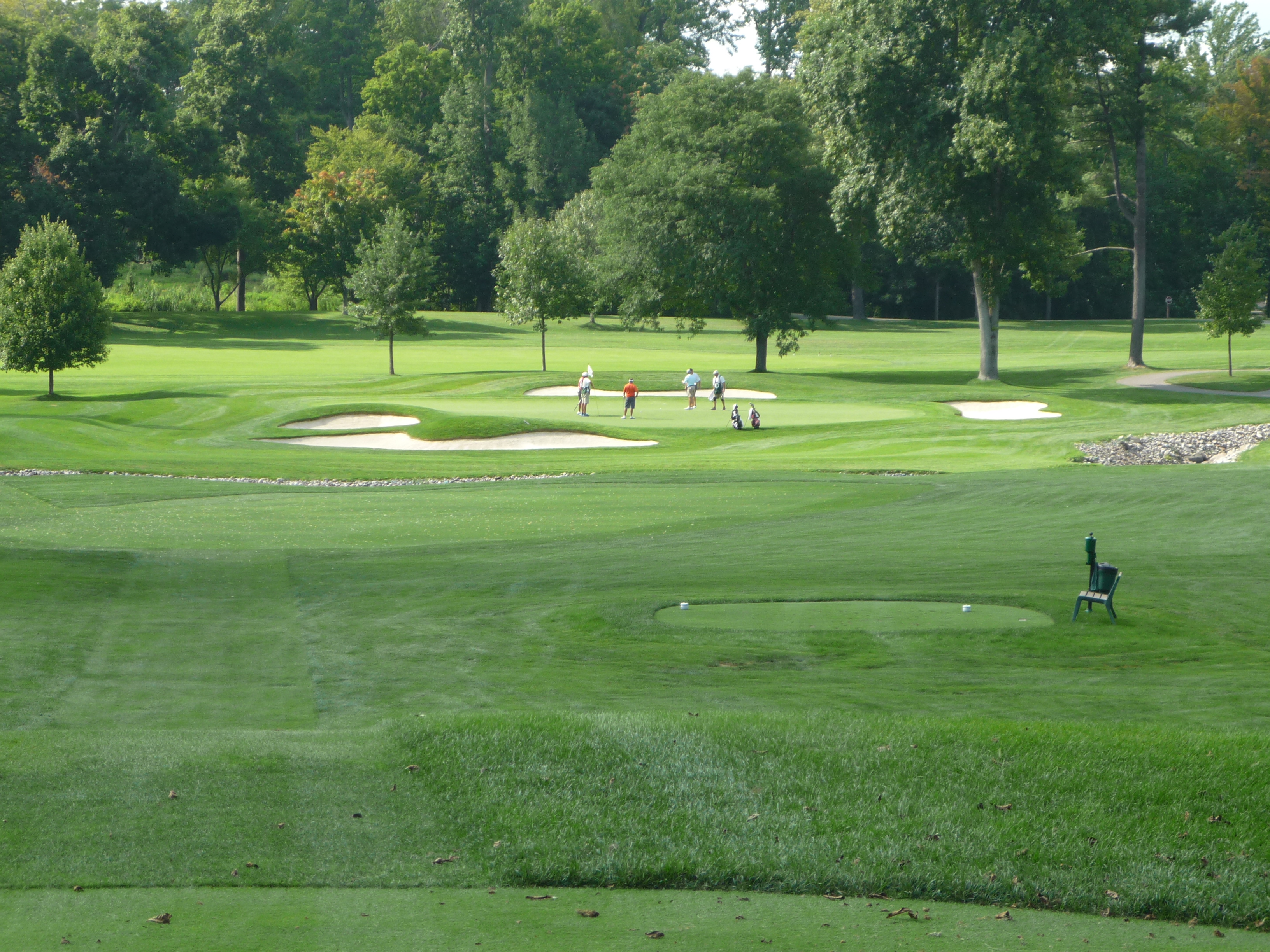
This view from the right of the green shows the massive bunker on that side.
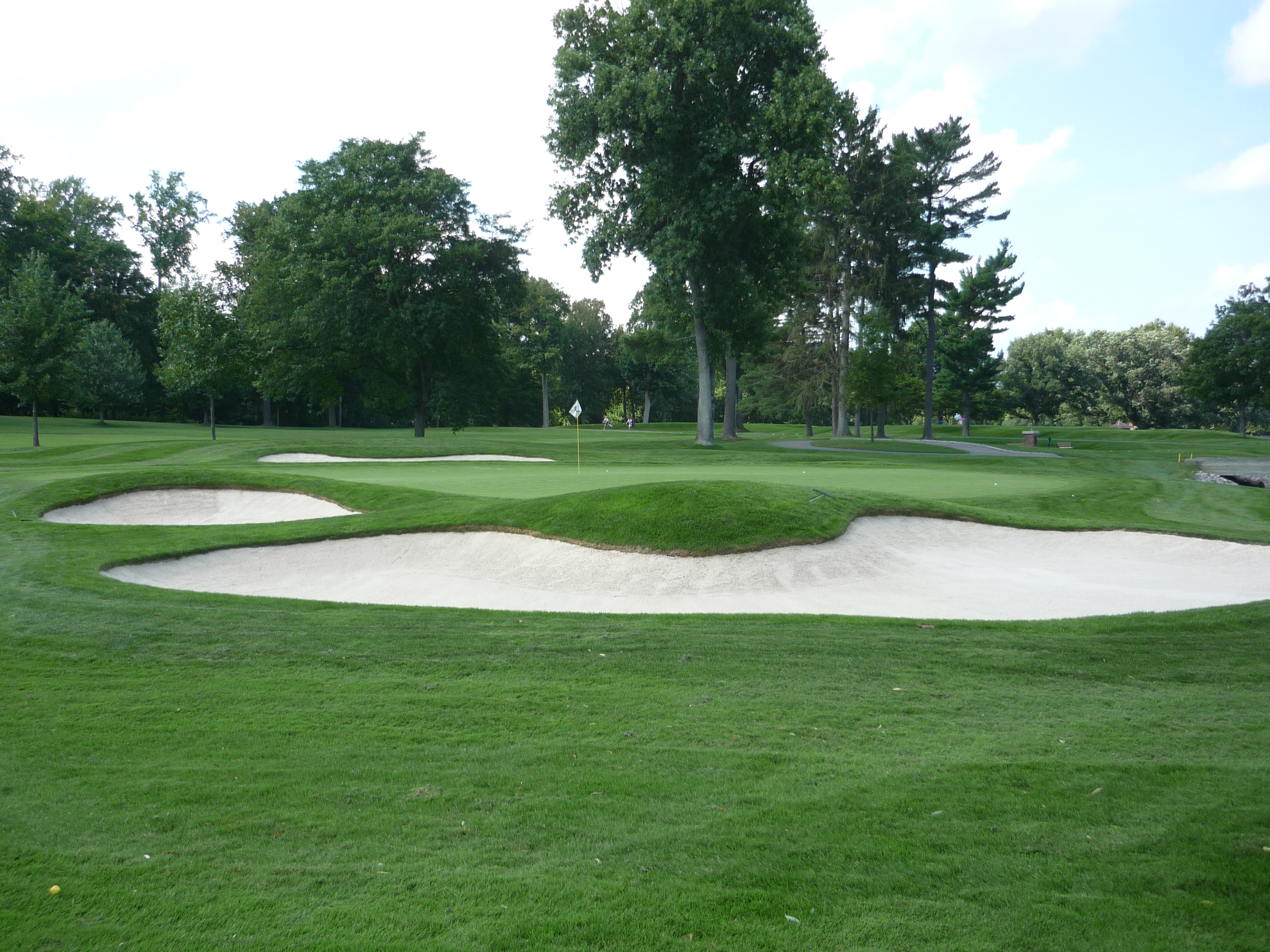
This photo shows the putting surface and the ridge that bisects the green.
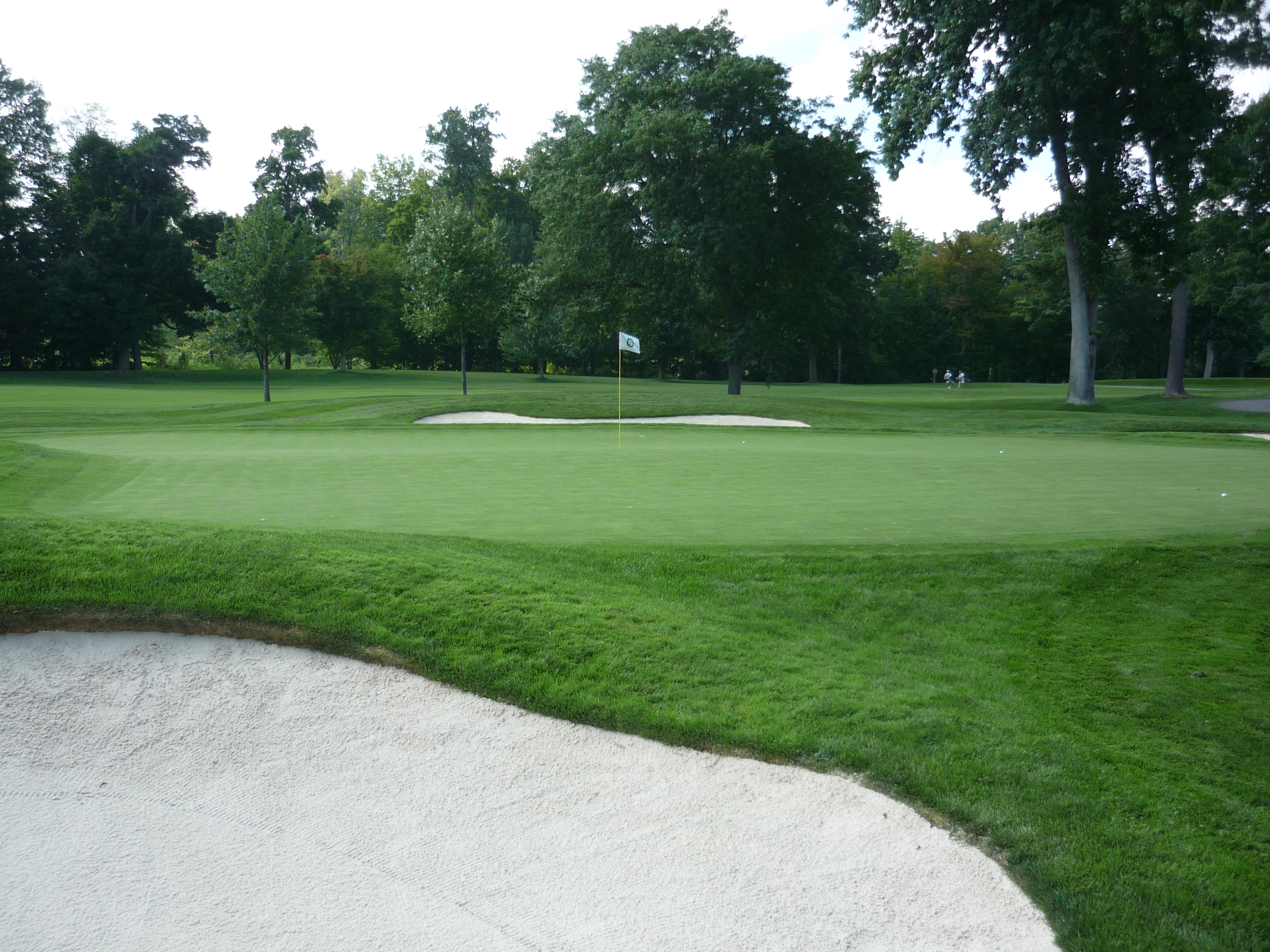
Hole 12 – 367 yards – Par 4 – Leaning Oak
The tee shot here calls for a fade. There is an actual leaning oak on the right side of the fairway that you can see in this photo. You don’t always need driver here since there are trees guarding both sides of the fairway.
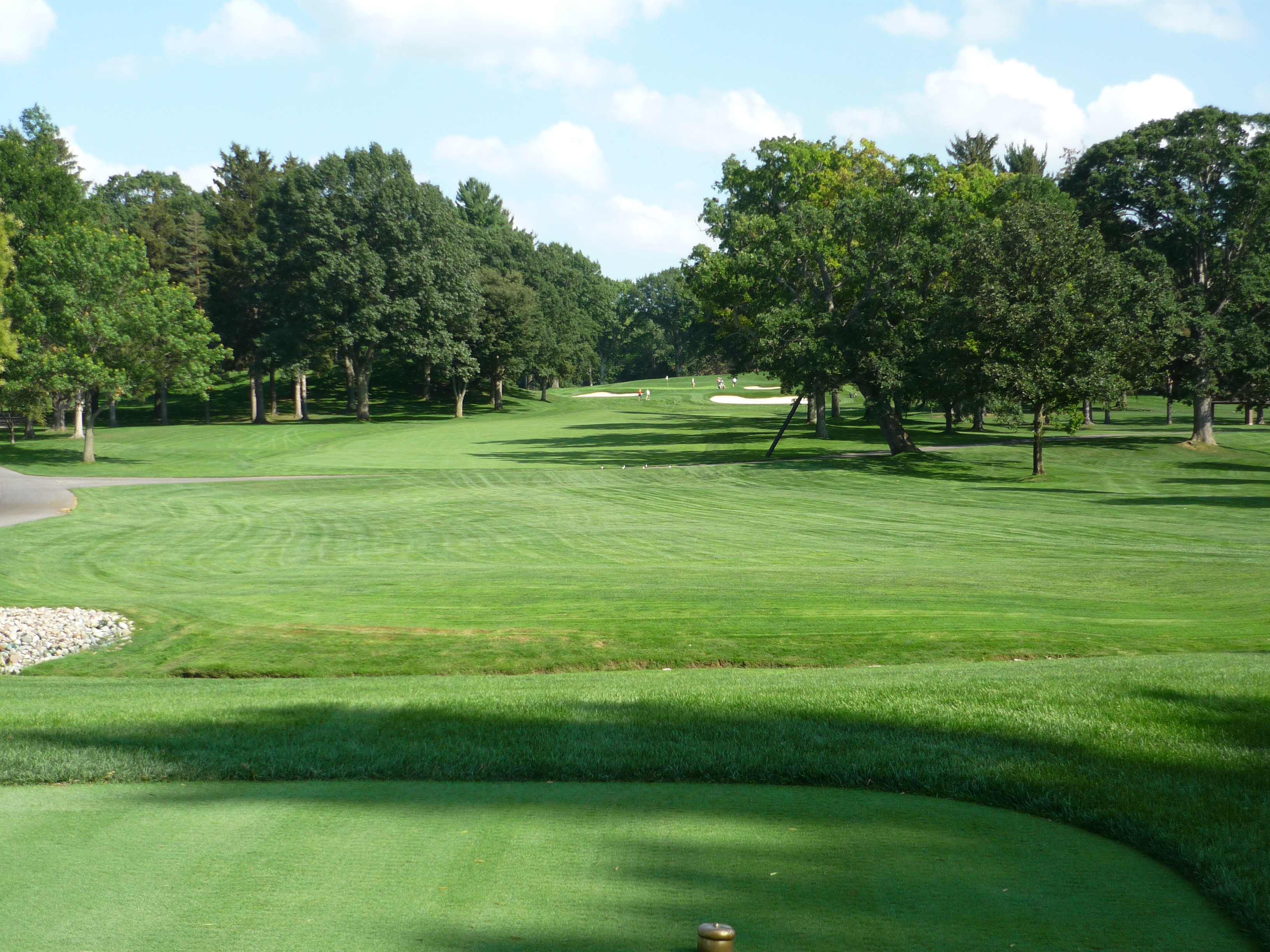
The approach shot plays up the hill. The first bunker on the right is not as close to the green as it may look.
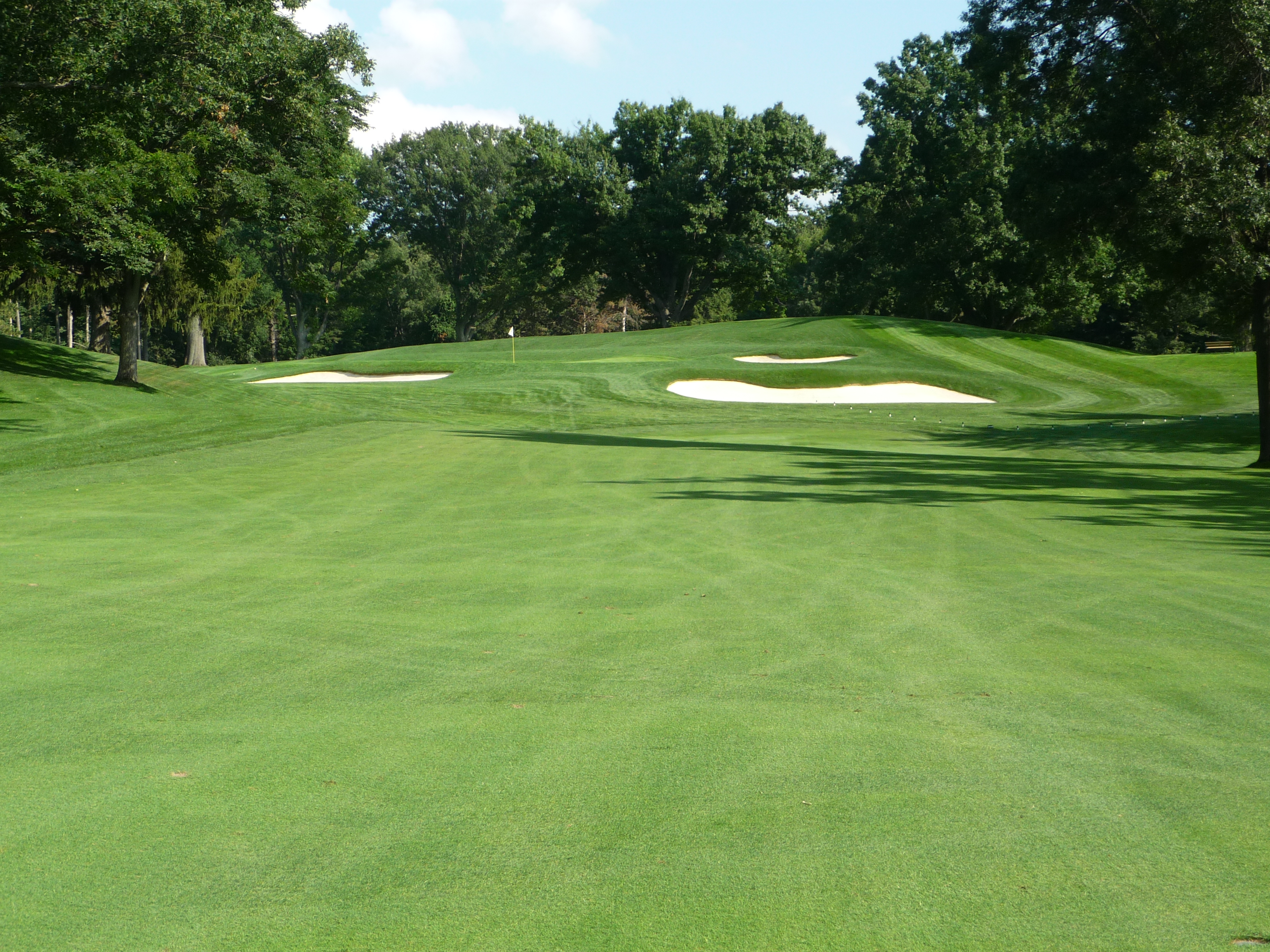
That doesn’t mean that you can’t hit into it as you can see below. It is quite deep and calls for a tough recovery shot.
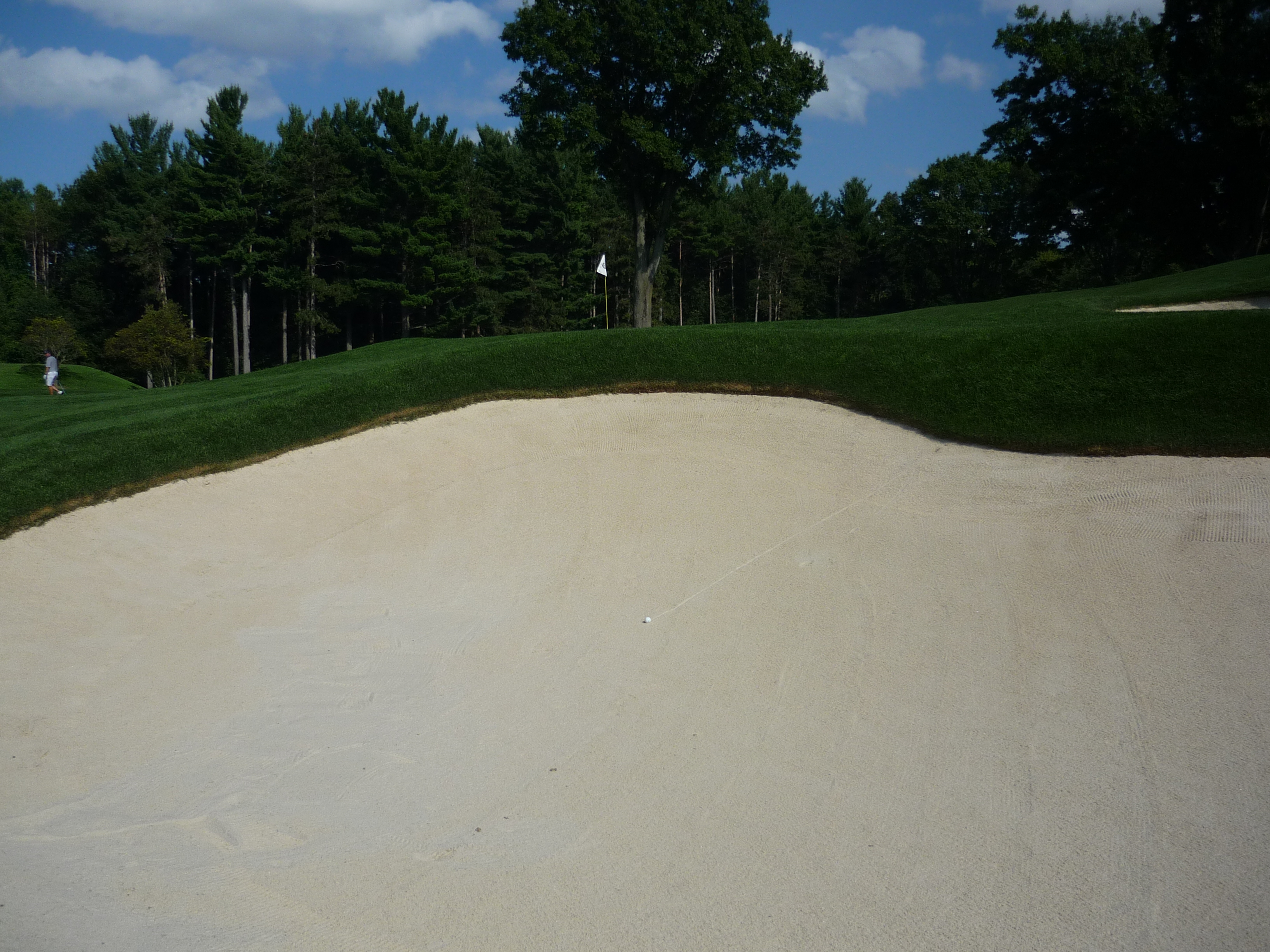
The putting surface contains most of its slope in the back, right portion. It is not very large.
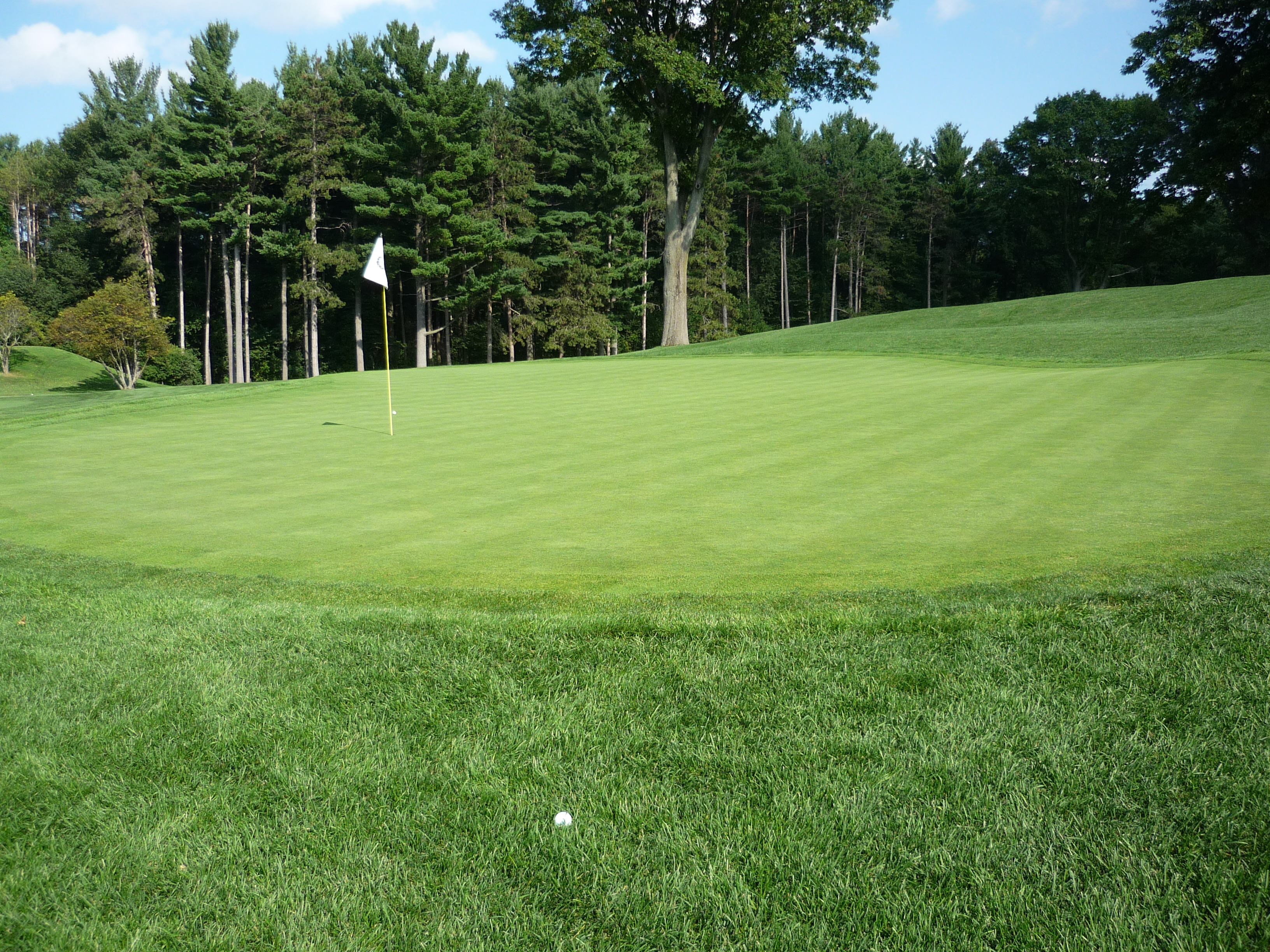
Hole 13 – 563 yards – Par 5 – Hill of Fame
This is the signature hole of The East Course. The Hill of Fame is located here. It is a great hole from start to finish. It demands a good drive. The creek crossed the fairway and is up the right side as well.

The second shot plays uphill and over the creek. You must avoid the large bunker on the right side so layup with precision.
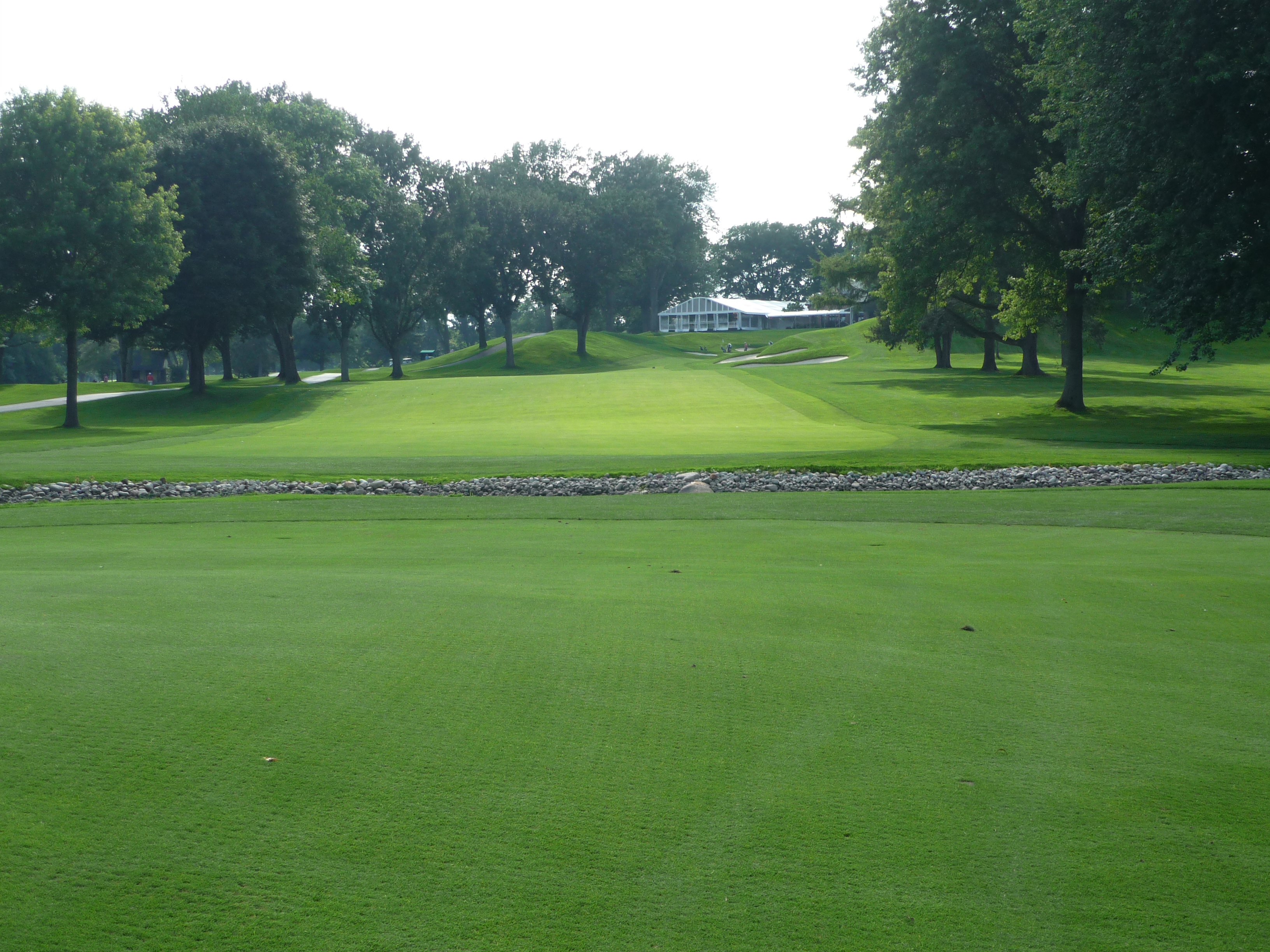
Here is another look at the hole from the bridge that crosses the creek.
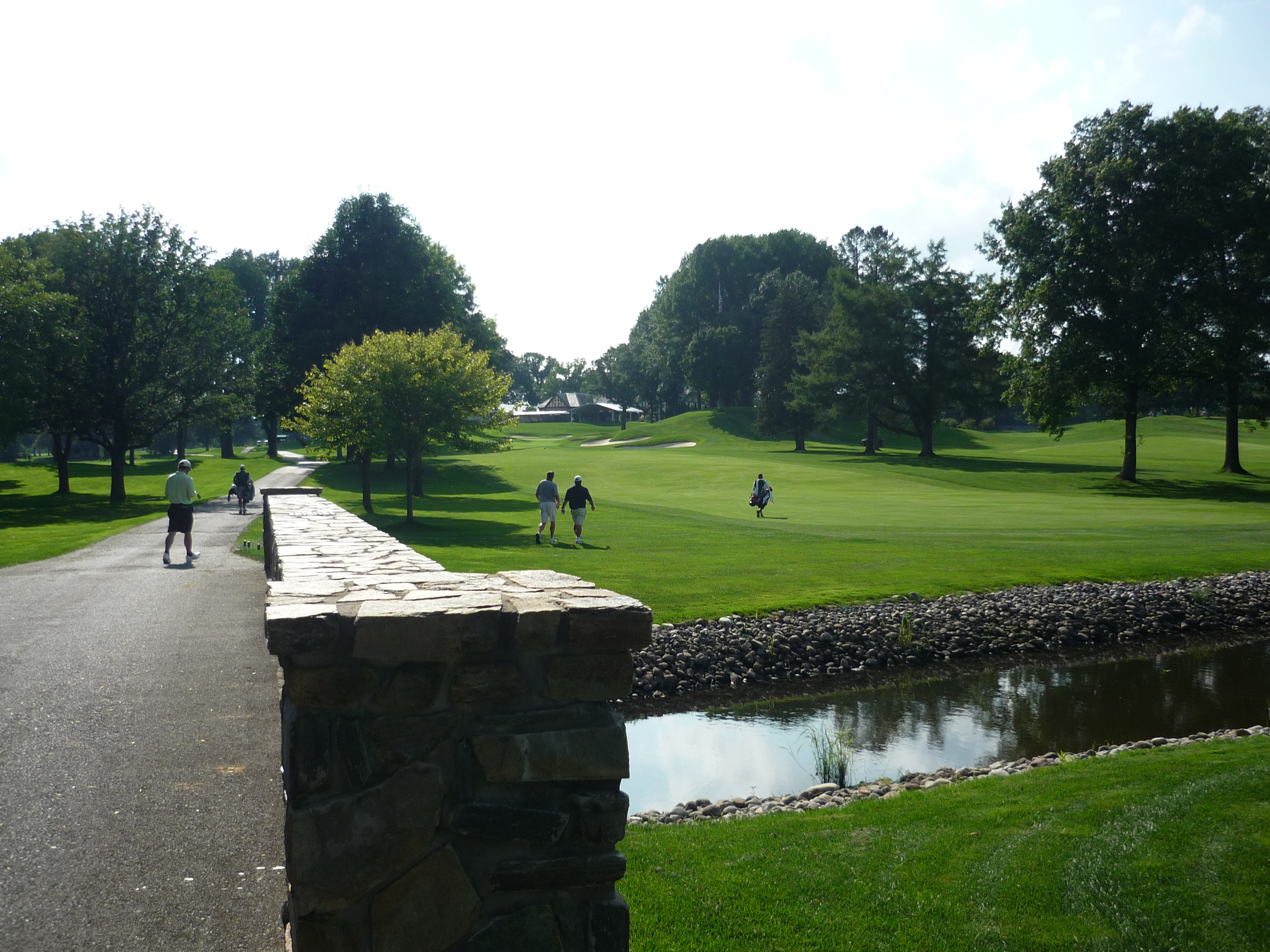
The green is seen below. You can see that is guarded by many bunkers. The green slopes severely from back to front.
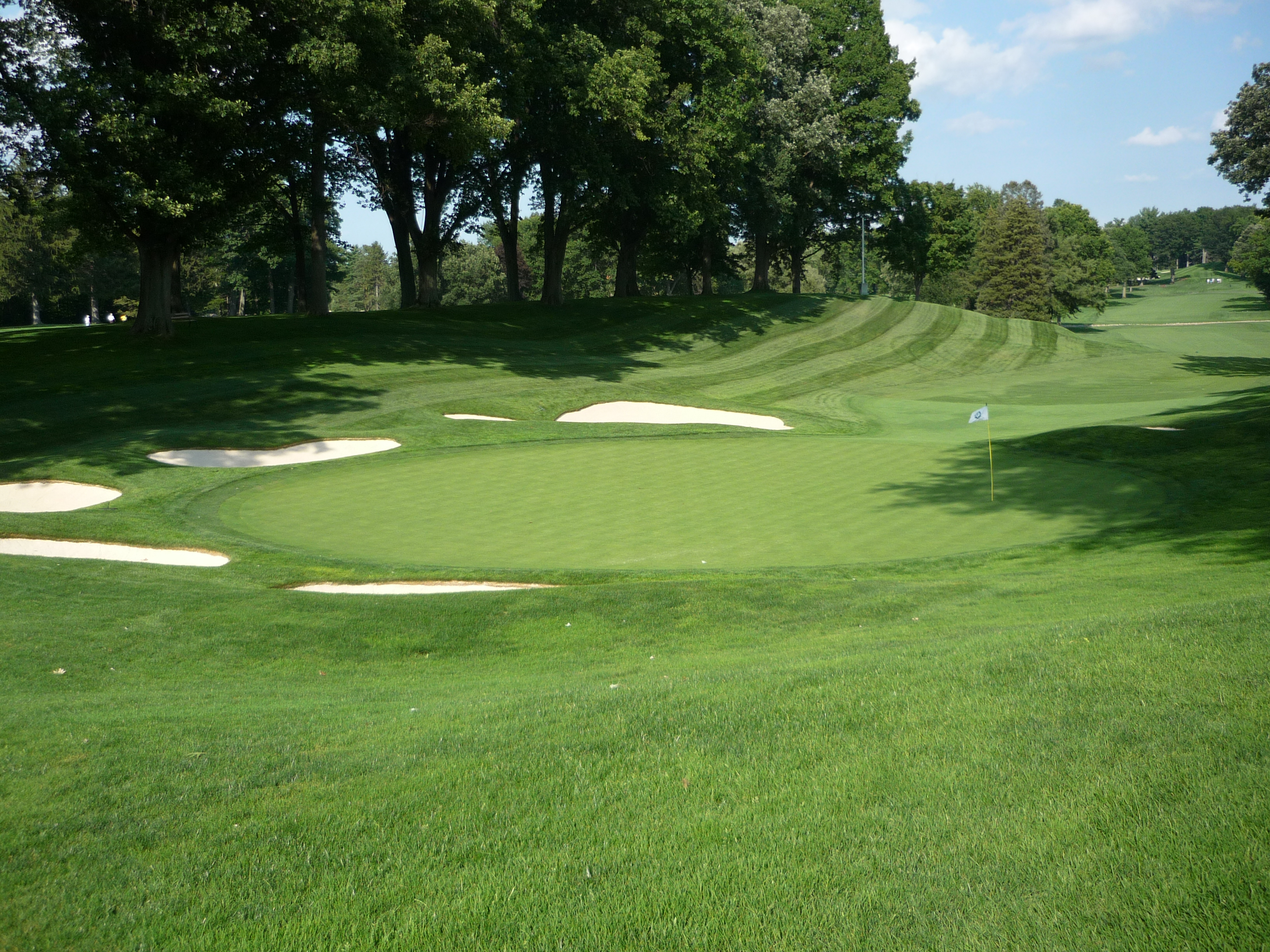
Here is another angle. The Hill of Fame is up on the hill behind the green.
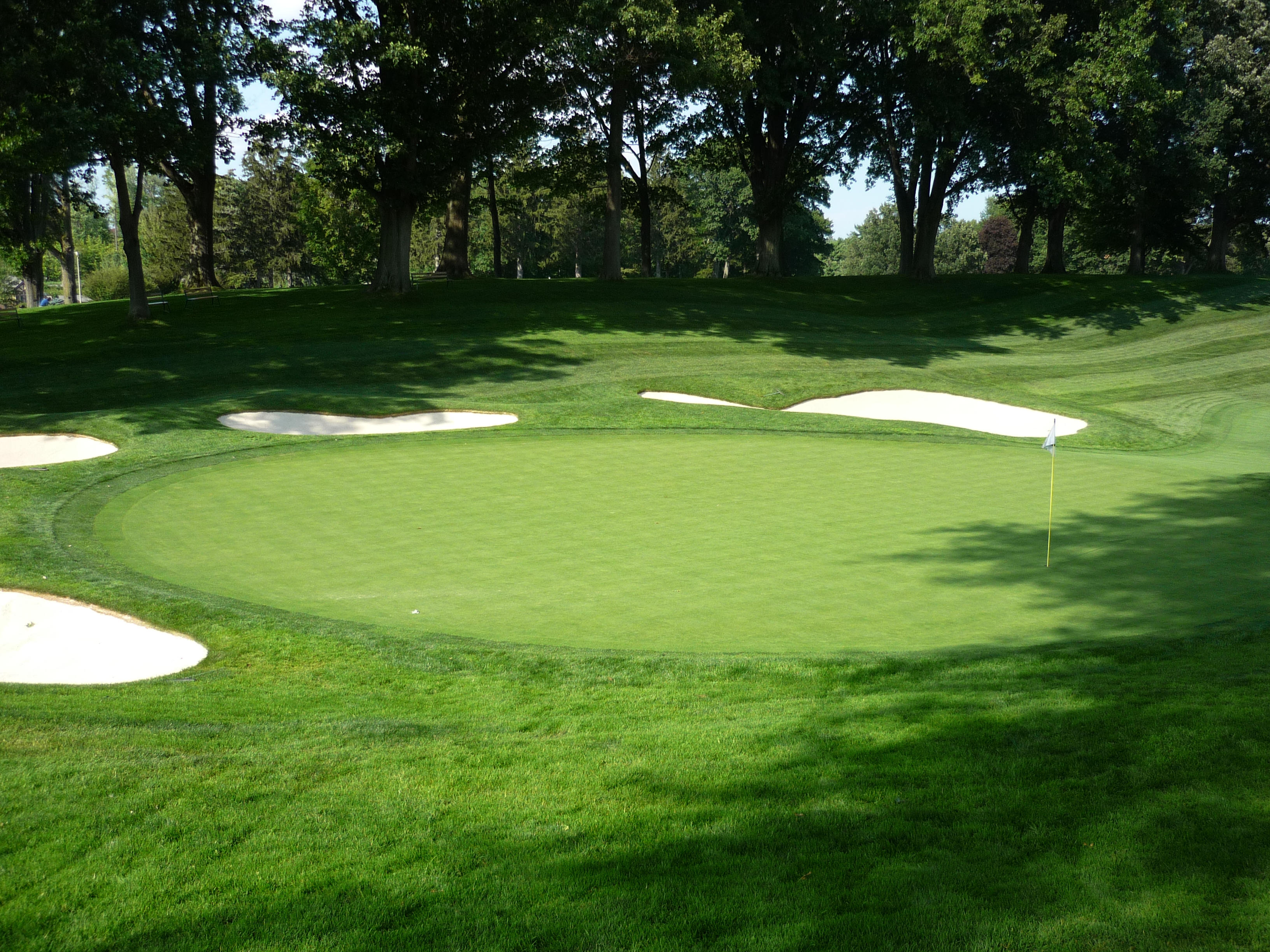
Hole 14 – 319 yards – Par 4 – Bunker Hill
This hole is best played with a shorter club from the tee. The trees really hem down your aiming lines. You can see the green up the hill in the distance.
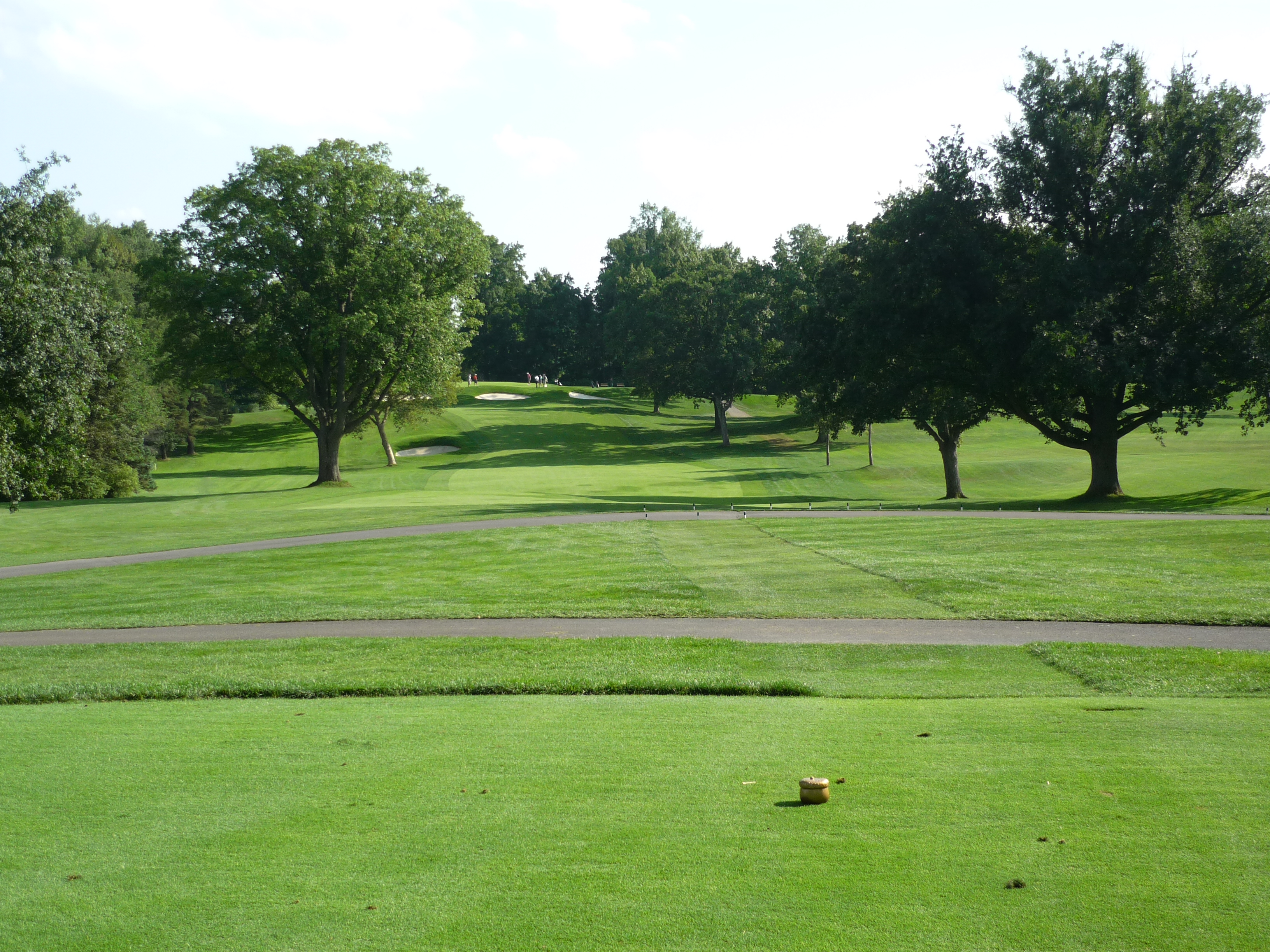
The approach shot is challenging due to the elevated green.. The deep bunkers in front of the green are also a danger. You want to make sure you take enough club.
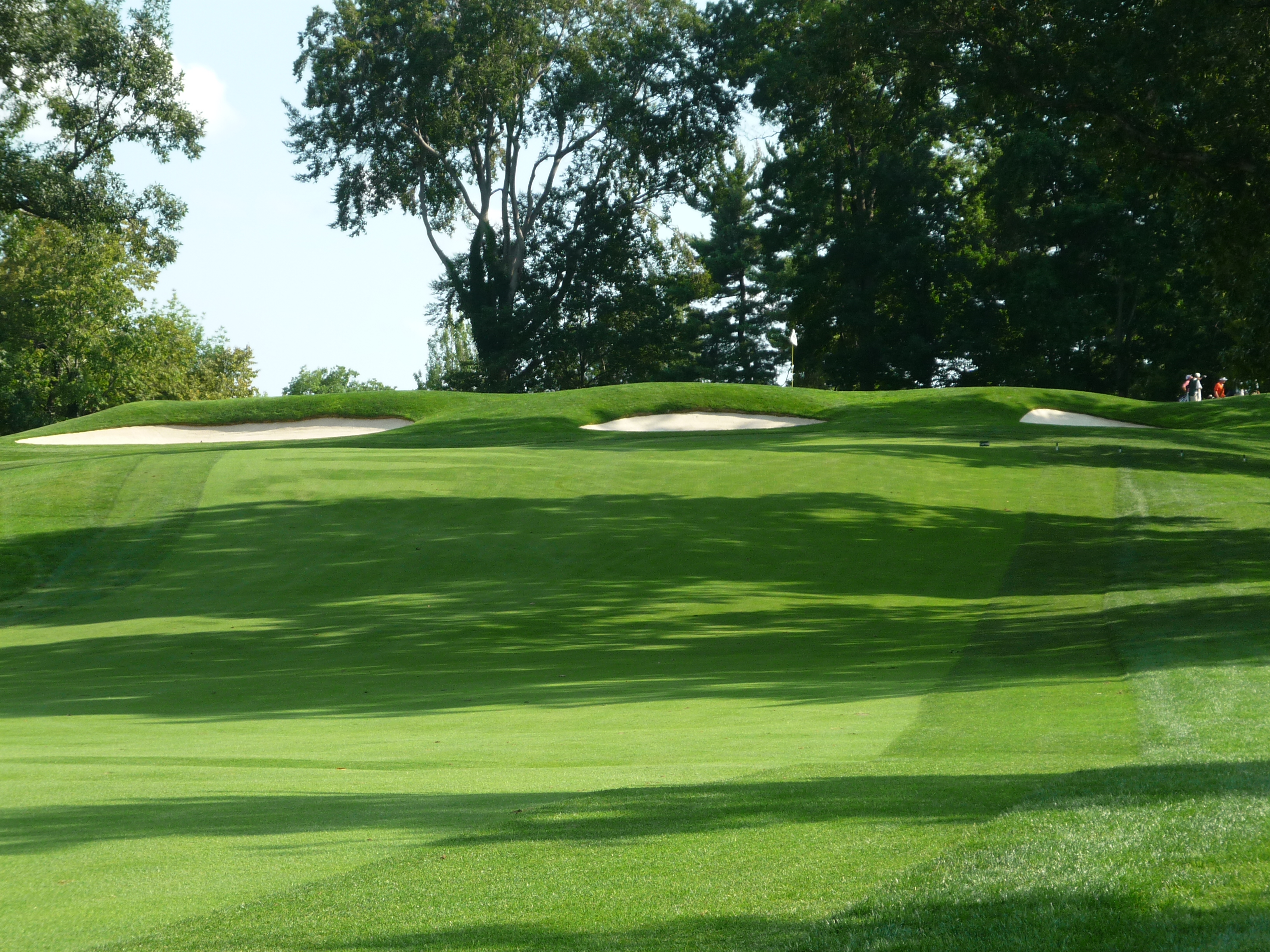
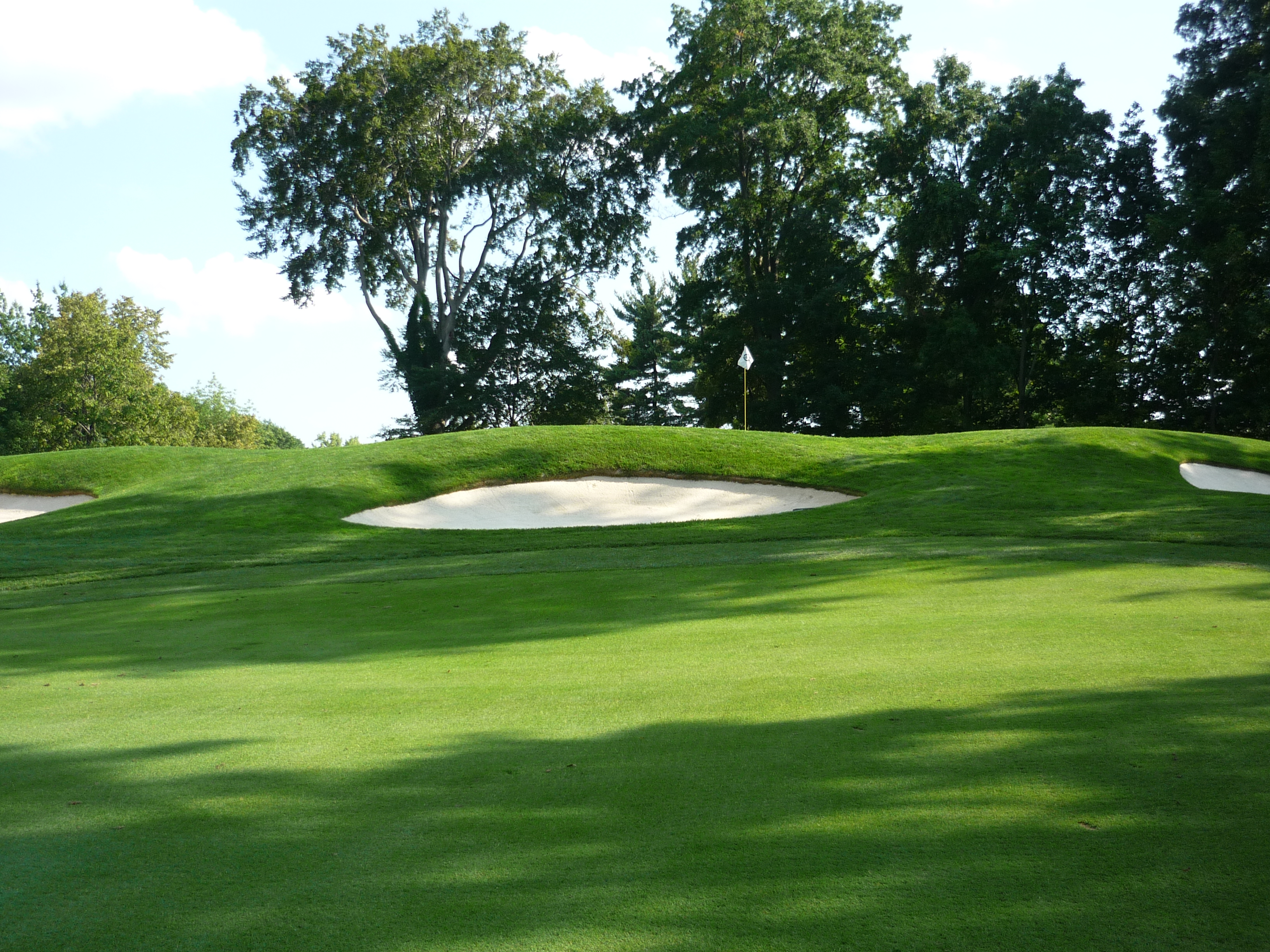
The green is two-tiered and can give you some interesting putts if you are on the wrong level.
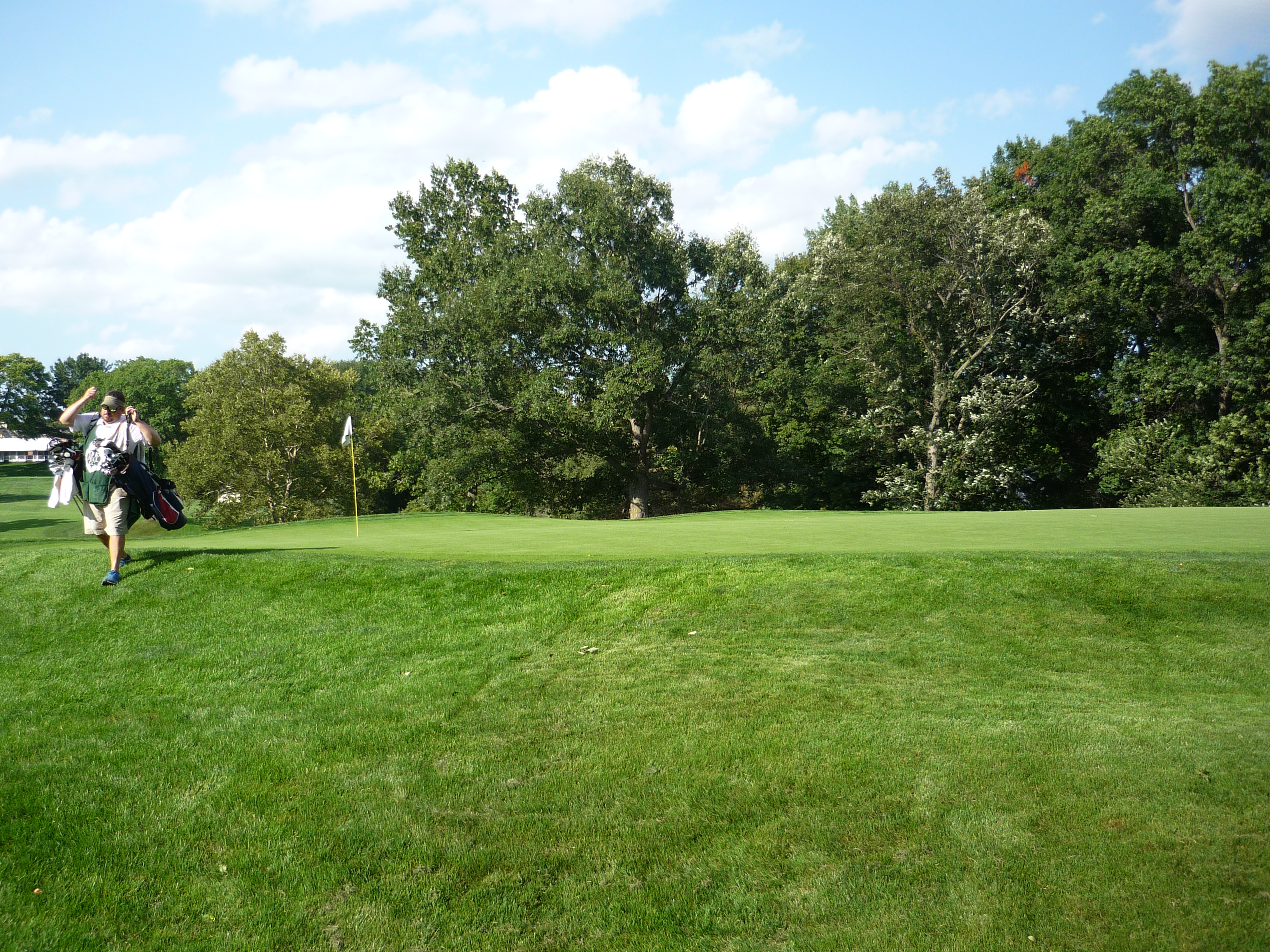
Hole 15 – 161 yards – Par 3 – The Plateau
There is plenty to fill your mind here. There is the pond on the right and bunkers on the left. The water is definitely in play. If you can manage a fade here it is the safest play since it will mostly fly over land.
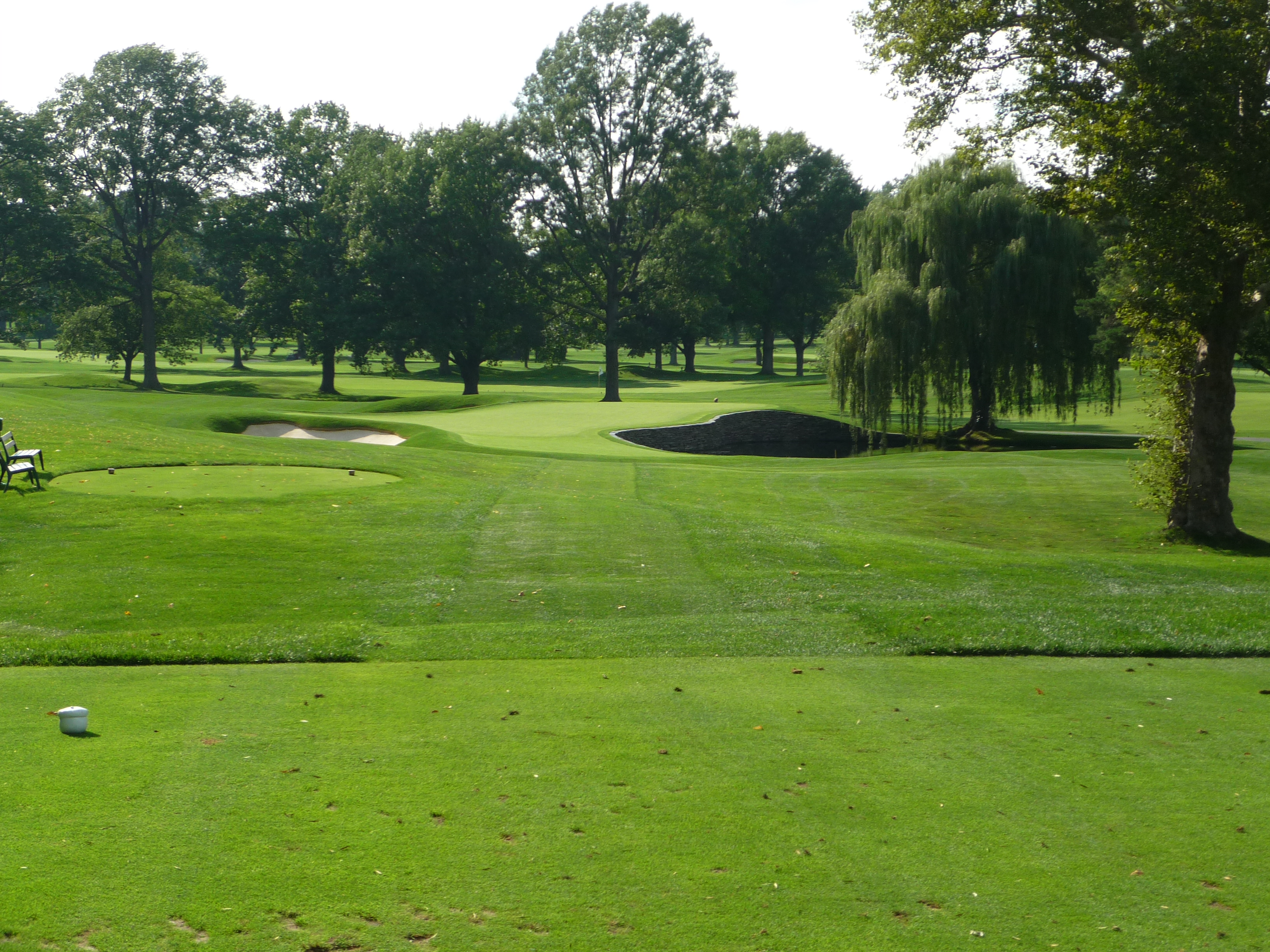
Here is a closer look showing the landing area.
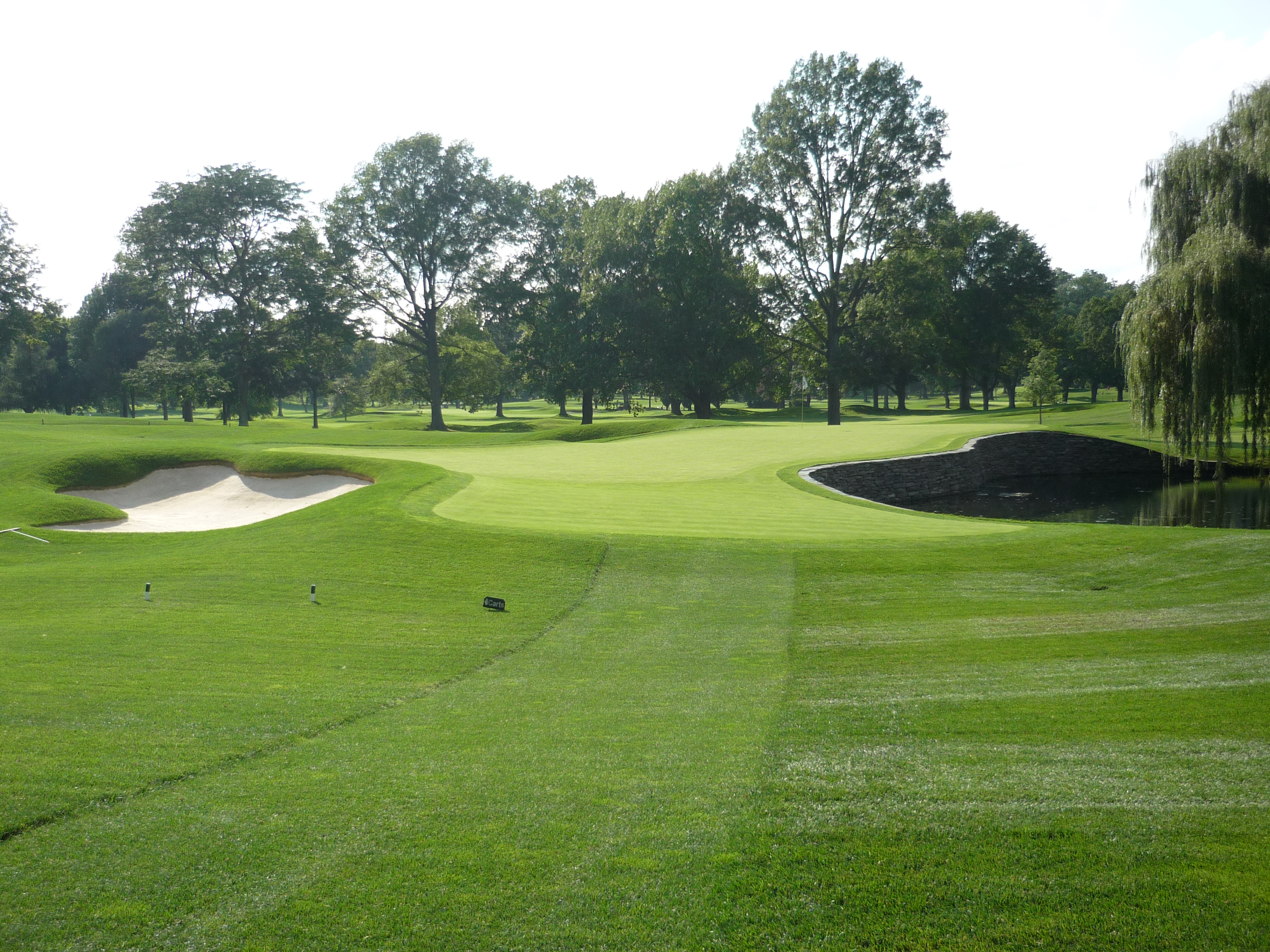
The stone wall along the green and pond was very well constructed as you can see below.
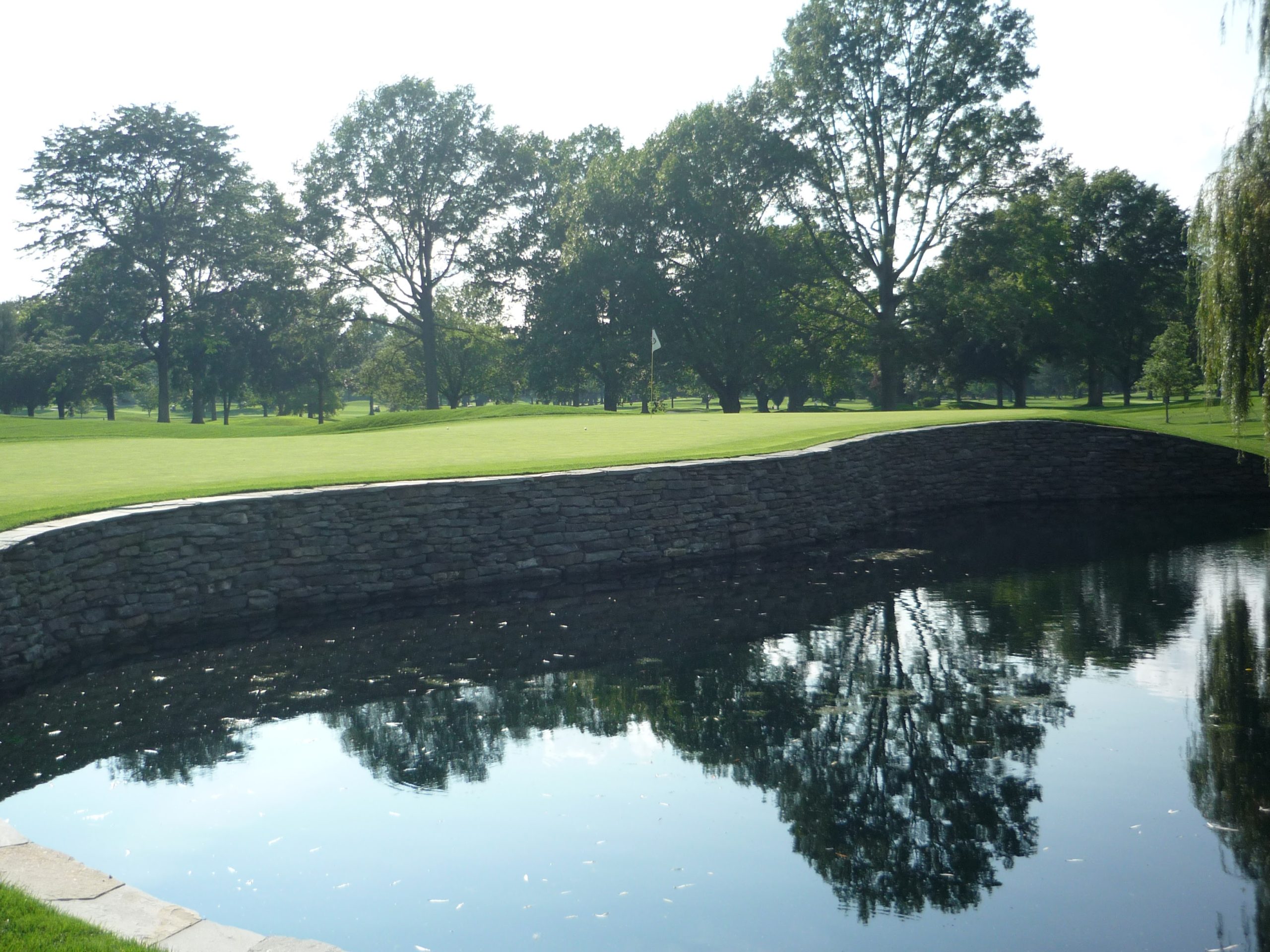
The putting surface is a difficult one to putt. You can see it from the left side below. The bunker shots are especially tough since they go back towards the water.
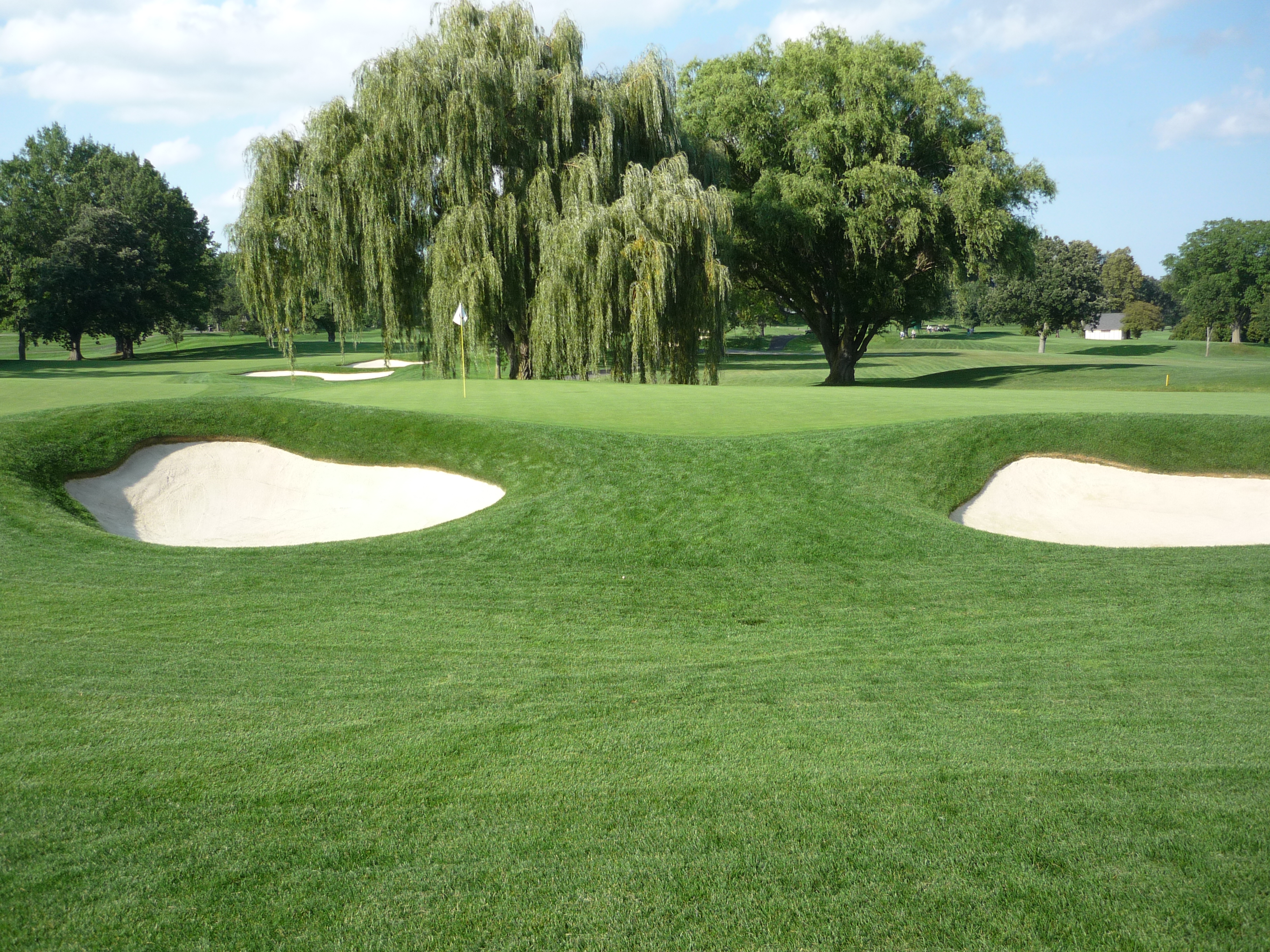
Hole 16 – 432 yards – Par 4 – Straight Away
This is a long, brutish hole. The fairway slopes severely to the left and will kick balls into the rough. In light of that, you will want to keep the drive up the right.
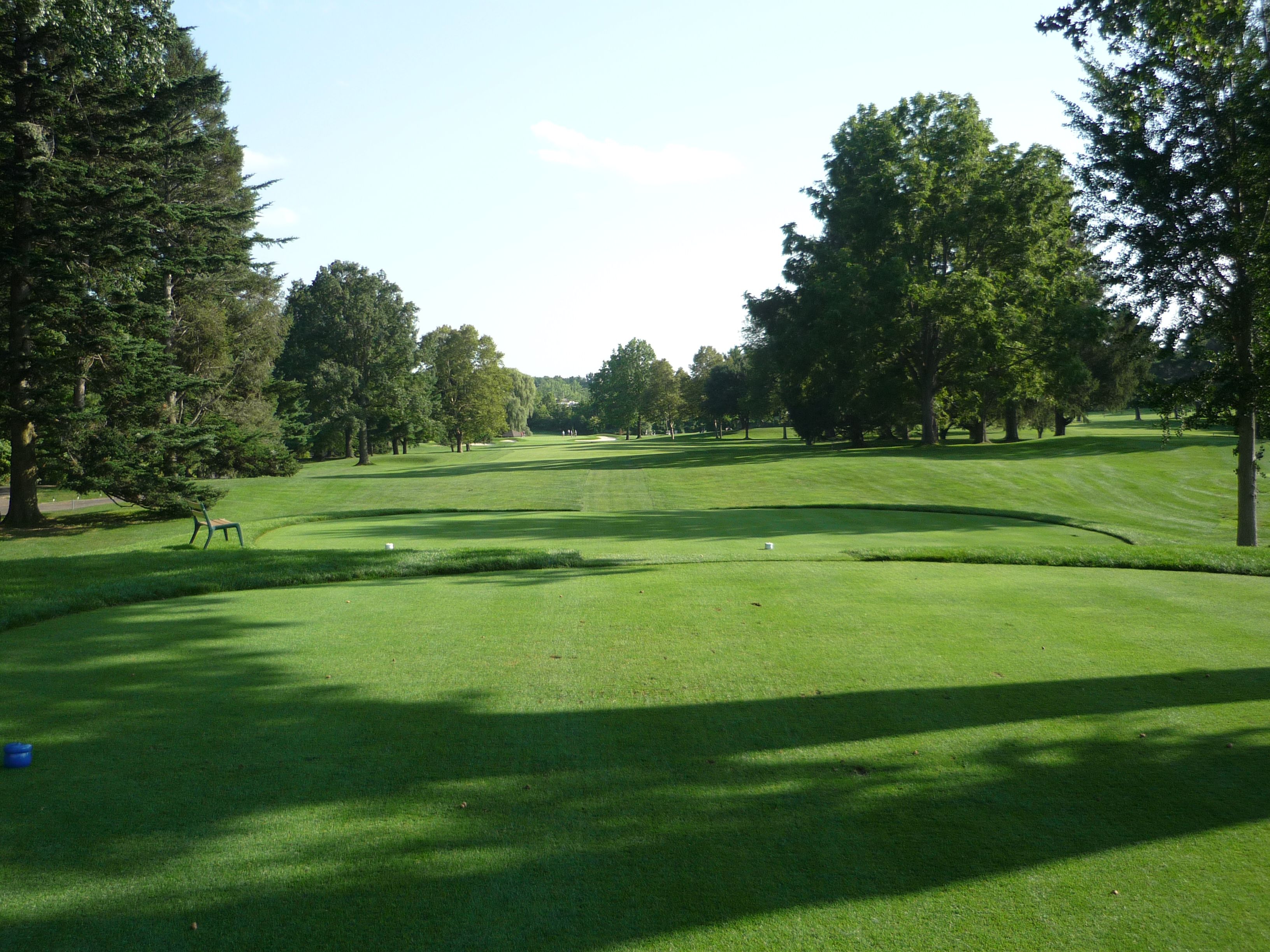
The second shot can be a long one depending on how good of a drive you hit. The green is open in front though if you choose to run something up. You don’t want to go long since it drops off.
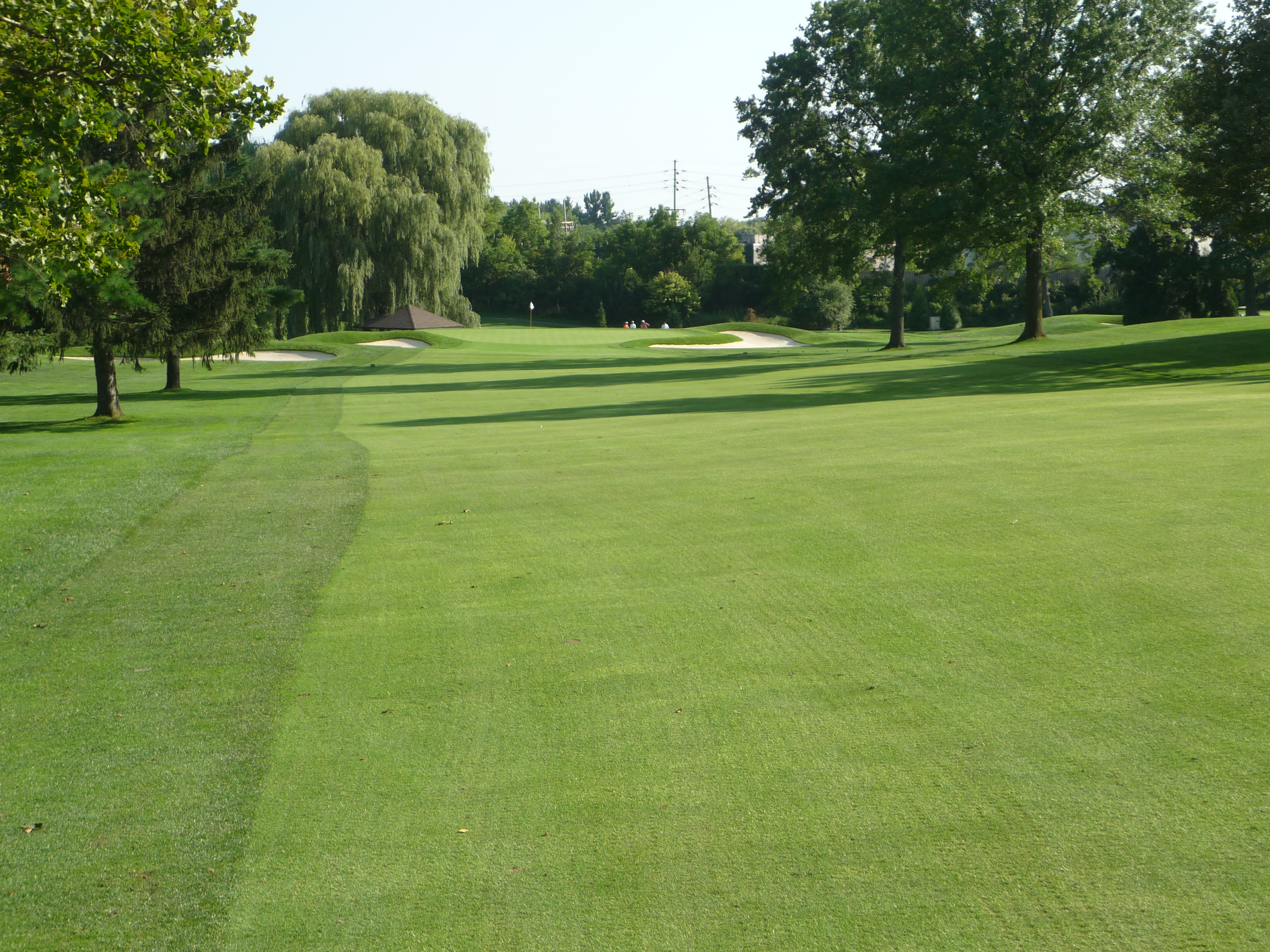
Here is a closer look at the green.
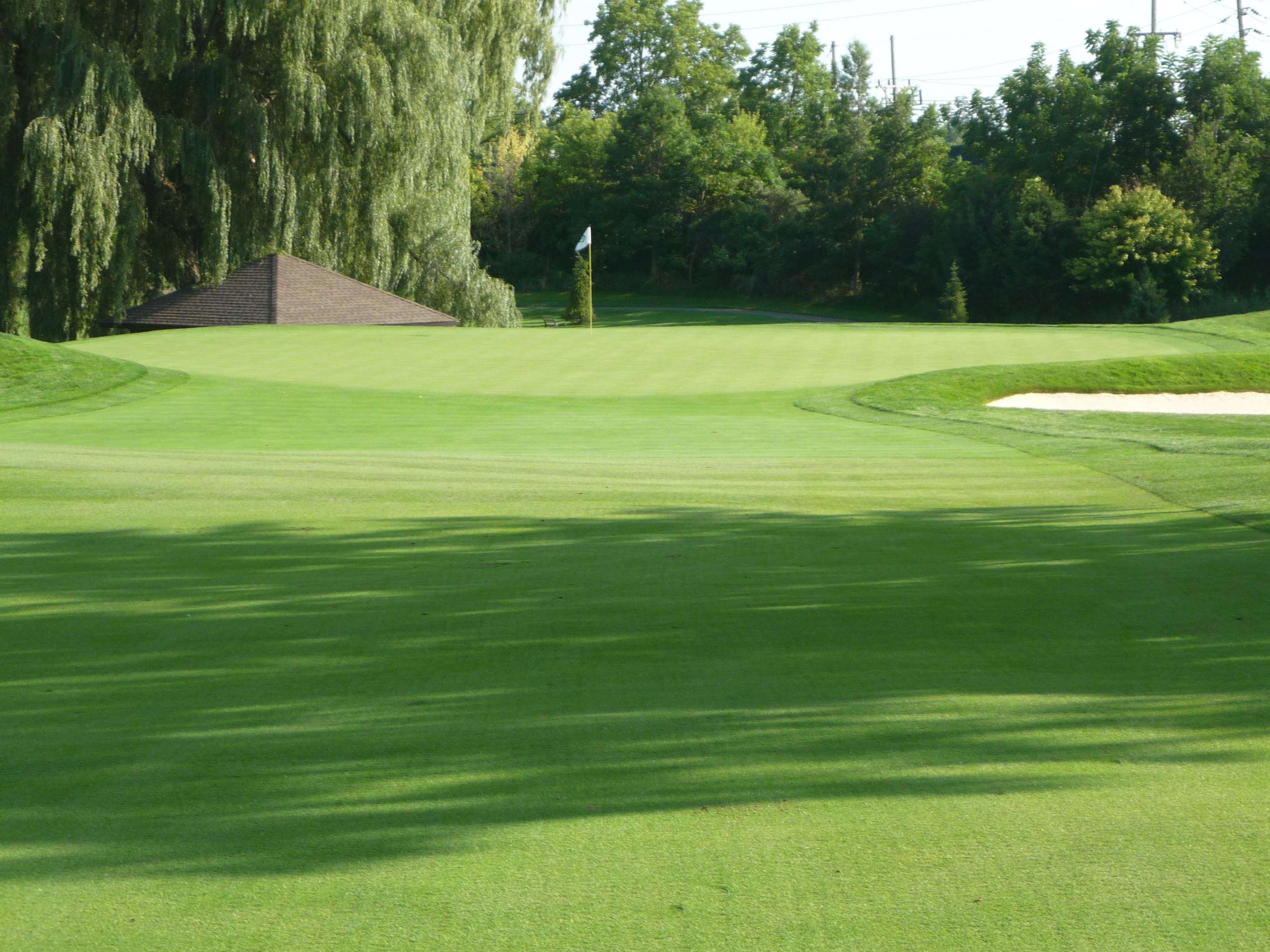
Hole 17 – 452 yards – Par 5 – Twin Tees
This shorter par five turns sharply to the right. It plays as a par four in the major championships. The trees frame your line and anything straight will do here.
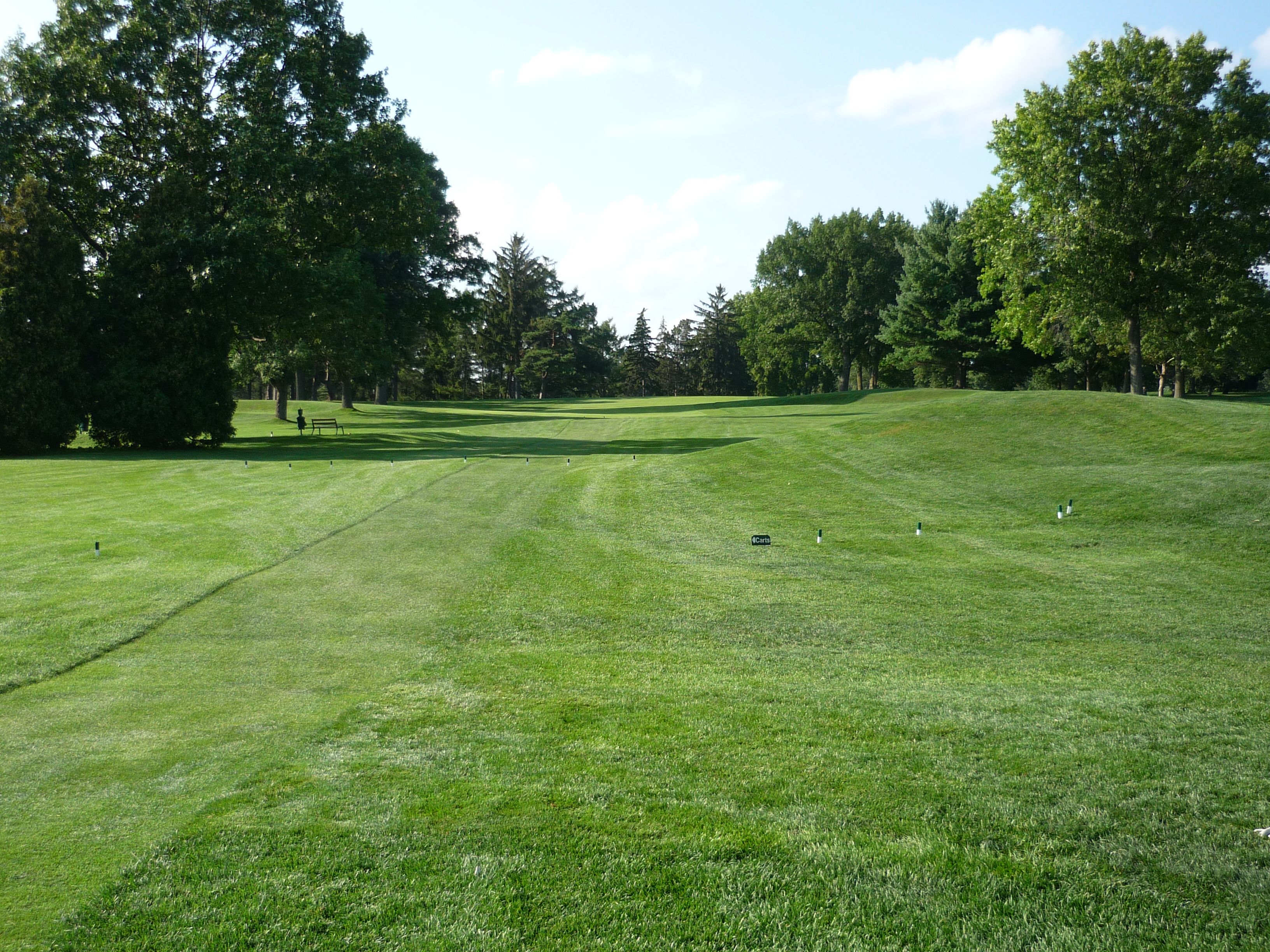
The approach is also lined by trees. I mentioned earlier how Dr. Williams had put so many trees on Oak Hill. Our member host said they had taken out more than 5,000. Think about that after all the pictures you have seen.
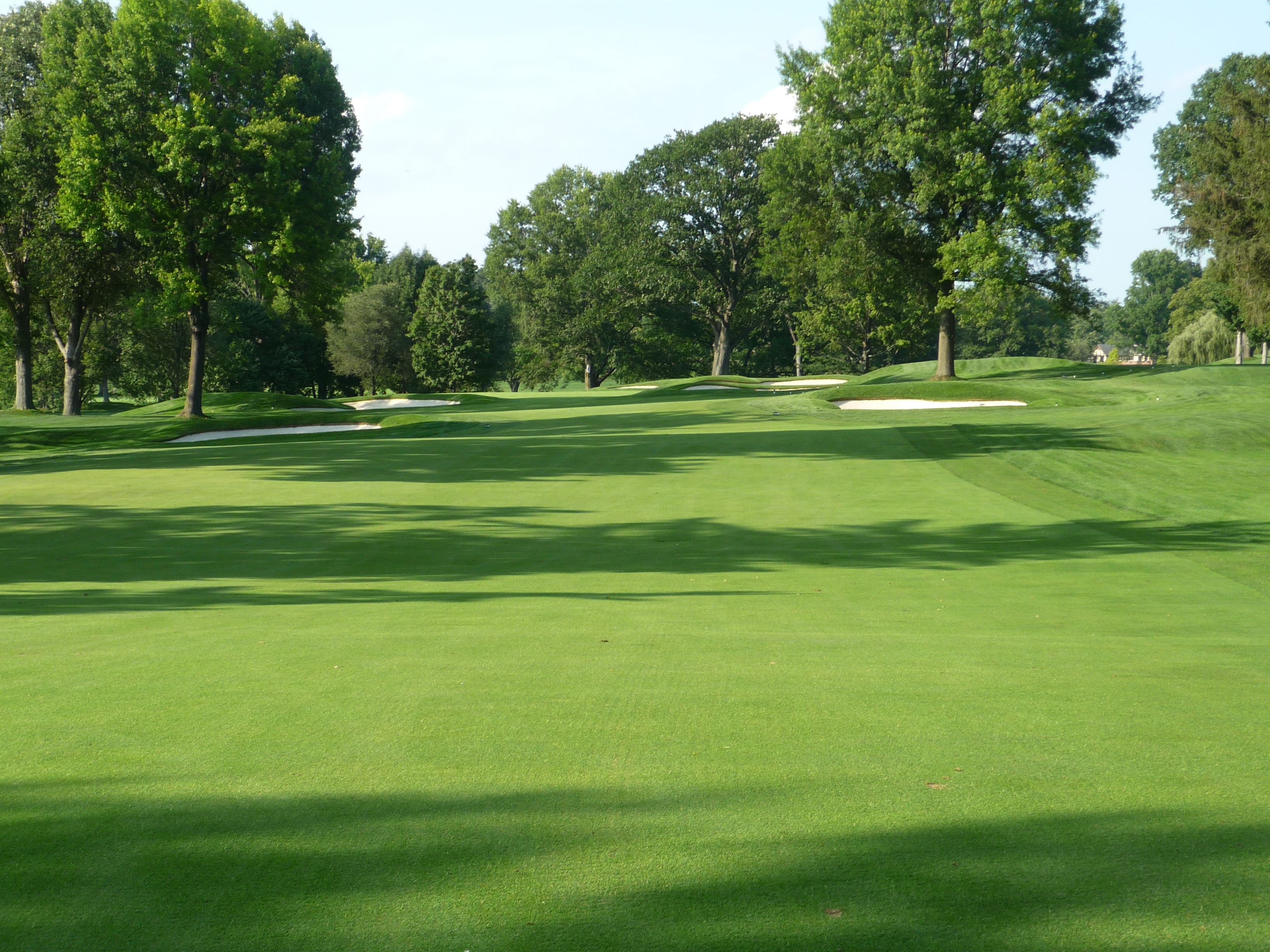
The green has a little sliver of an opening at the front. Four bunkers guard the green and make for some difficult up and downs.
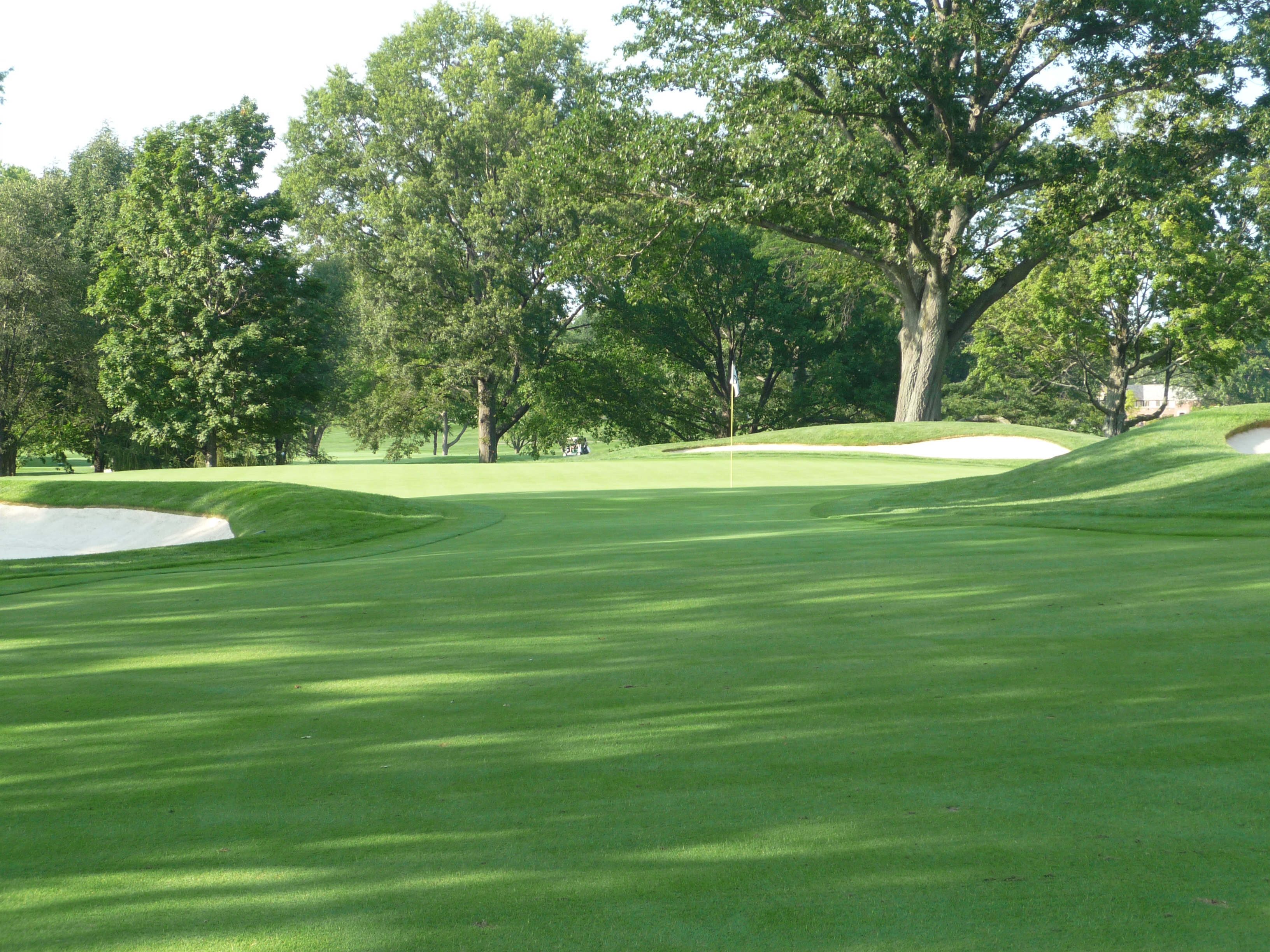
Here is a closer look at the putting surface.
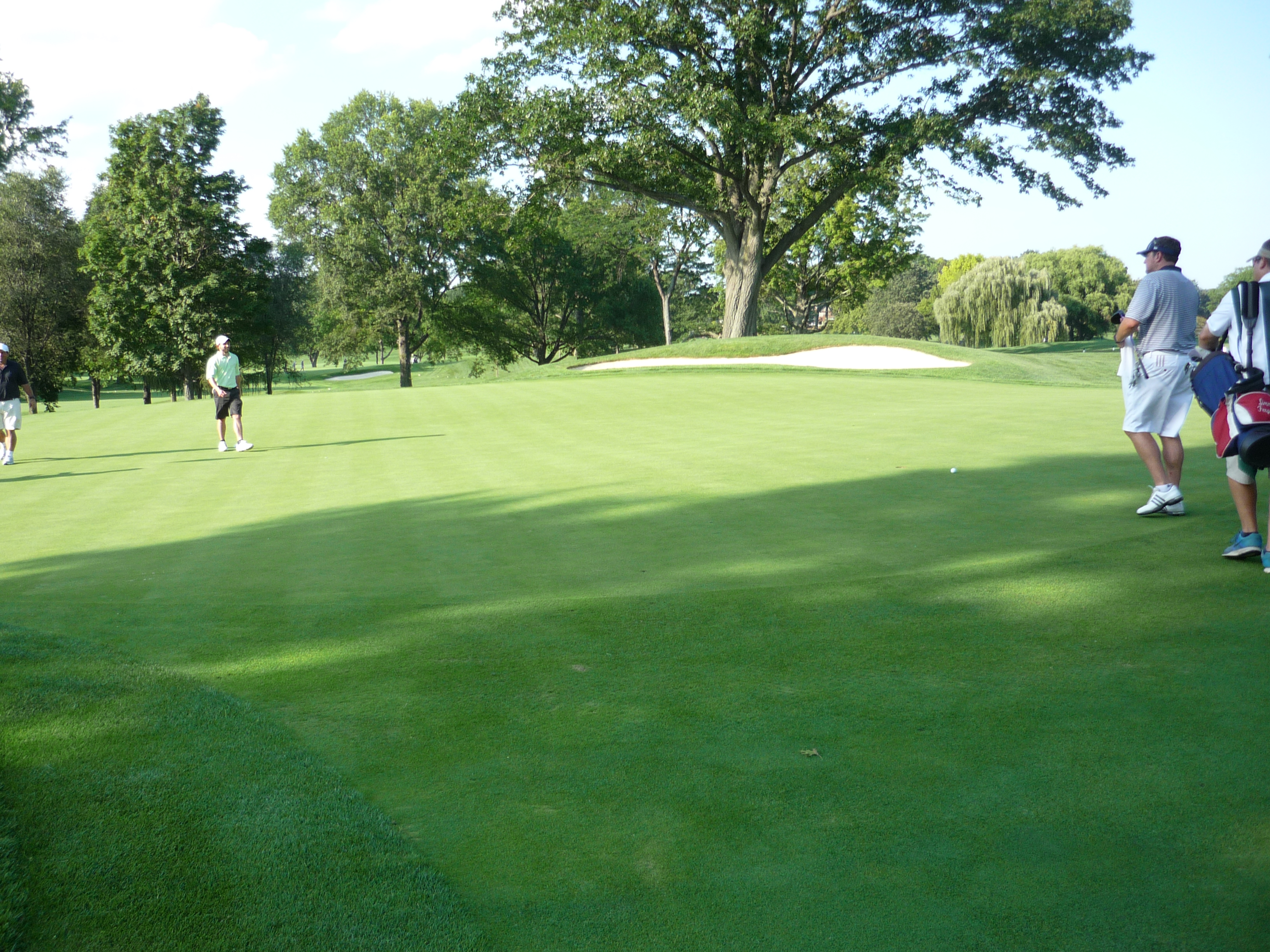
Hole 18 – 405 yards – Par 4 – Goin’ Home
The last hole is no picnic. You need another long and straight drive here. That has been a hallmark of Oak Hill. You really need to position your tee shot. The bunkers on the right are in play so keep the tee shot to the left of them.
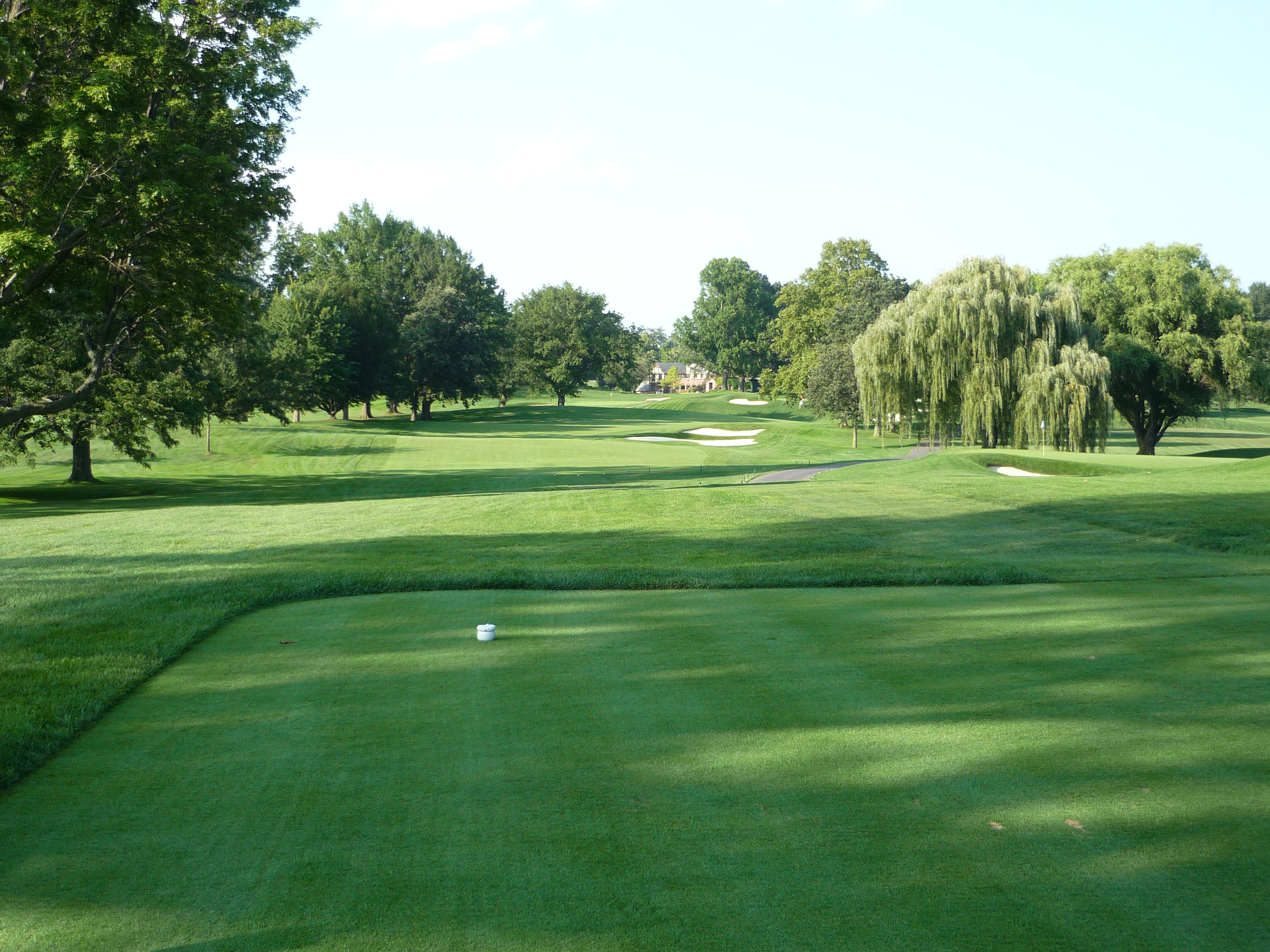
The approach shot plays over a deep slope that fronts the green. It has rough all over it and bunkers flanking it. You want to play for the middle or the back of the green on this shot.
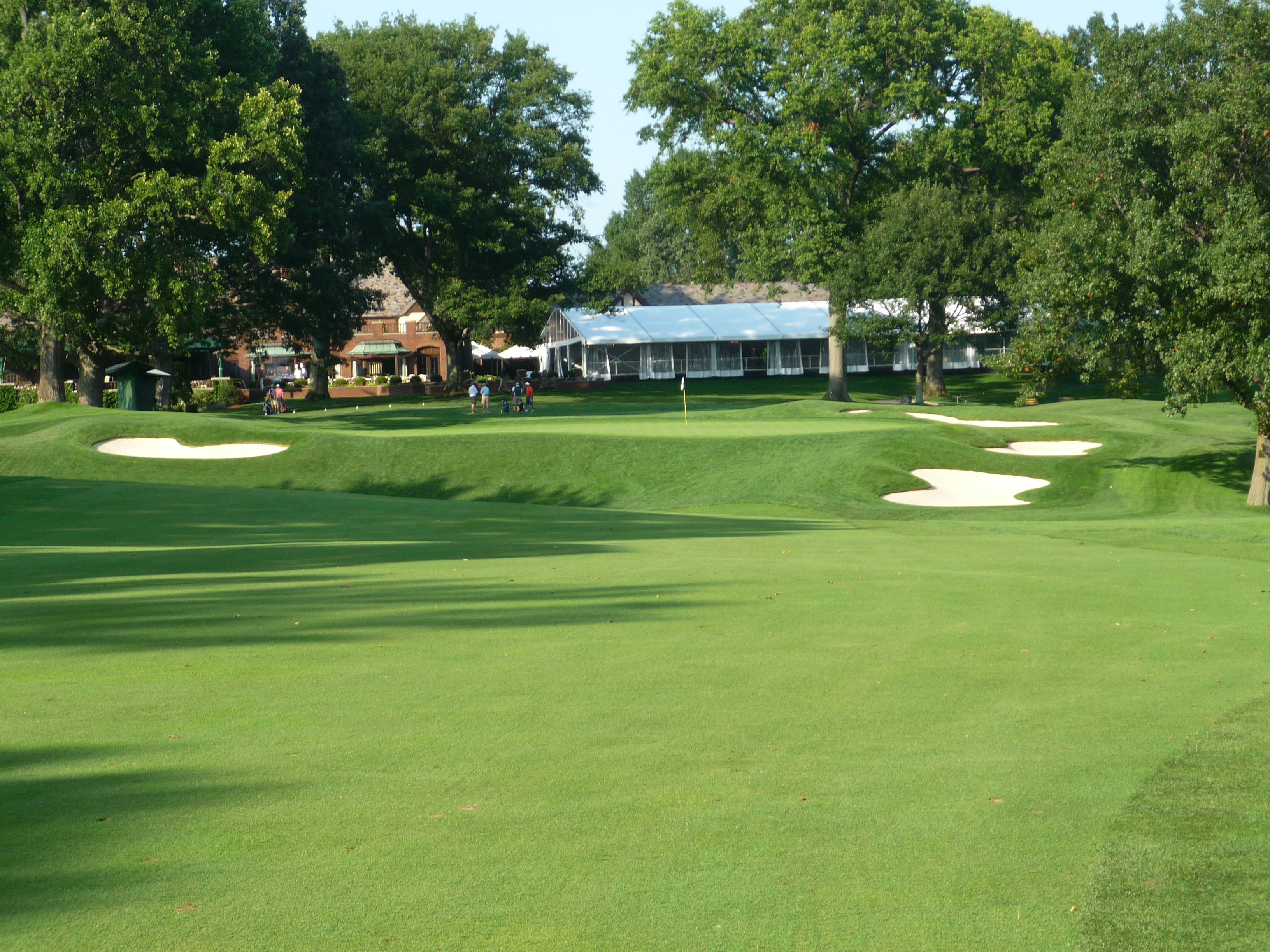
You can see the severity of the slope in the photo below.
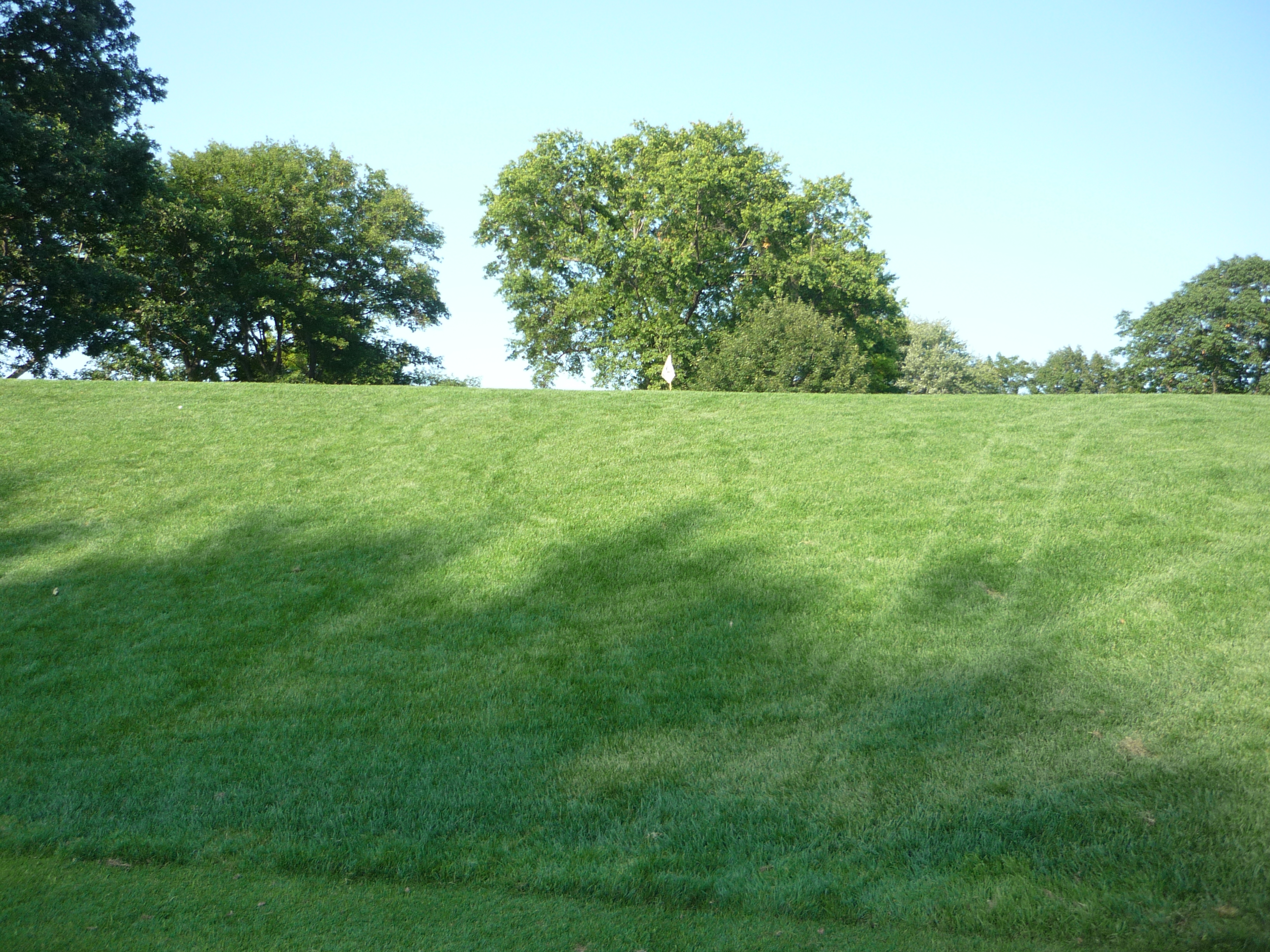
Occasionally I like to take photos looking back down a hole. It gives you a different perspective and can open up the architect’s plans.
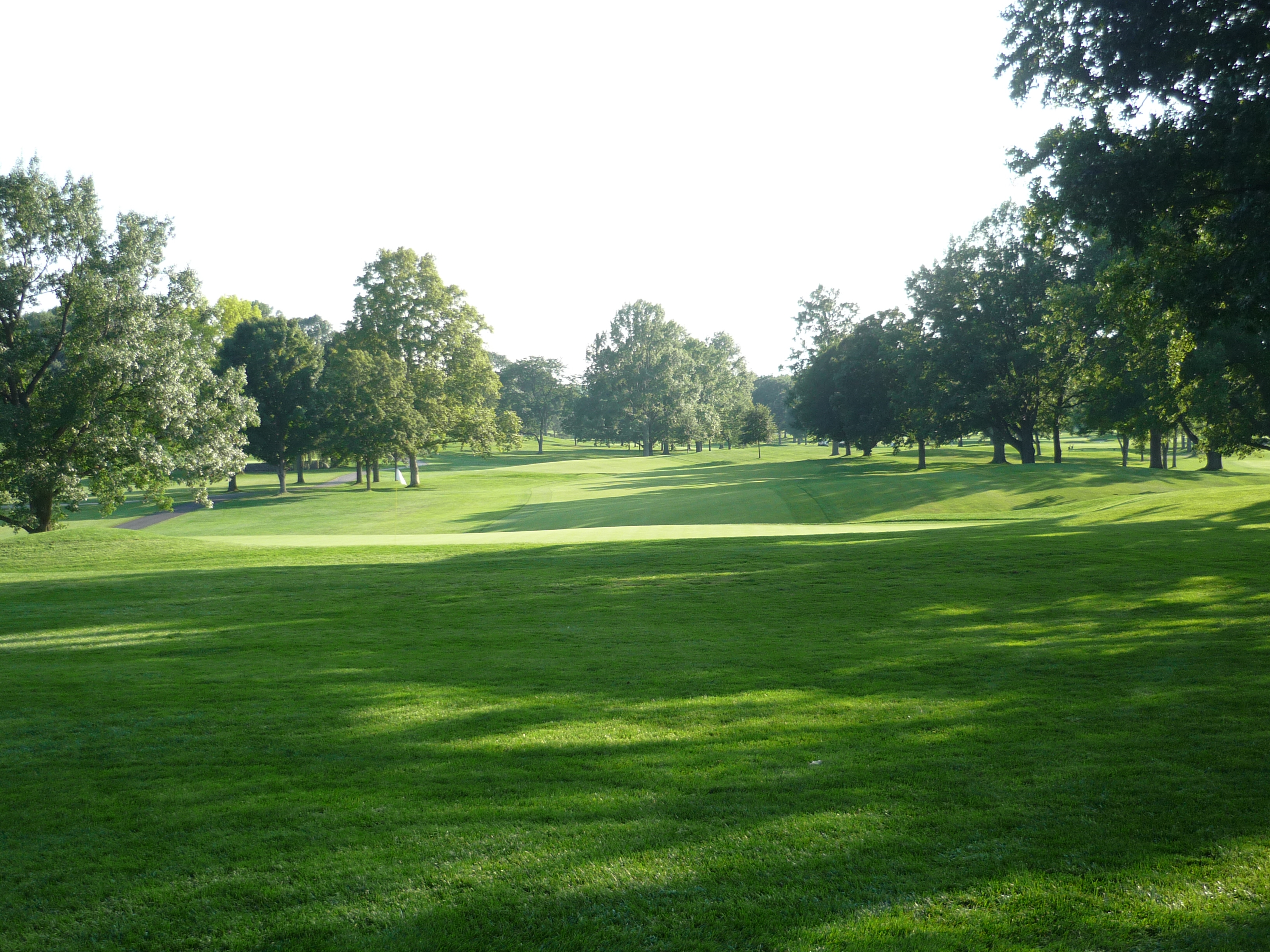
Here is a look at the final green from the patio.
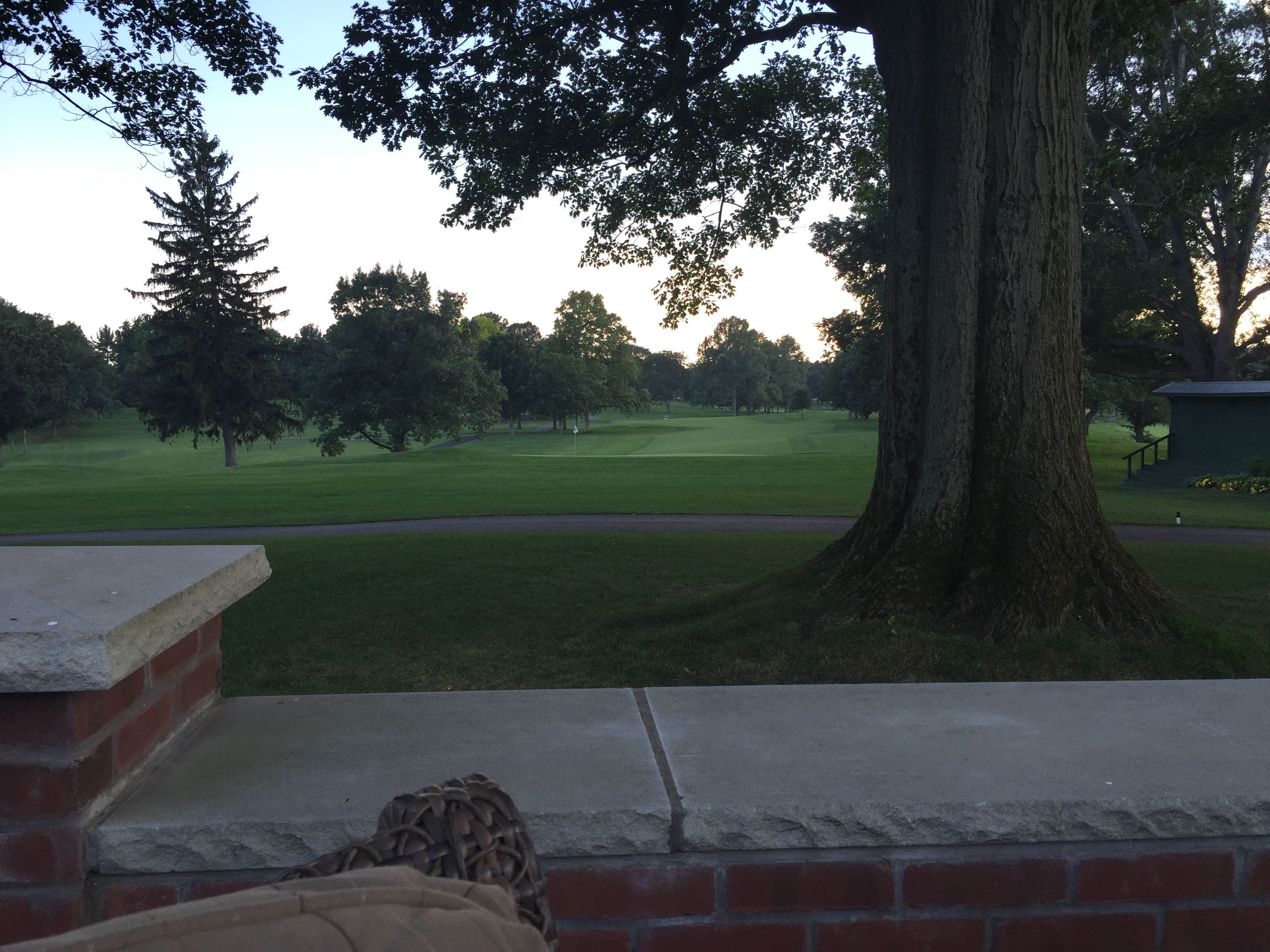
We had a couple of drinks on the patio behind the clubhouse. This was a really cool spot to hang out after a round while the sun was going down.
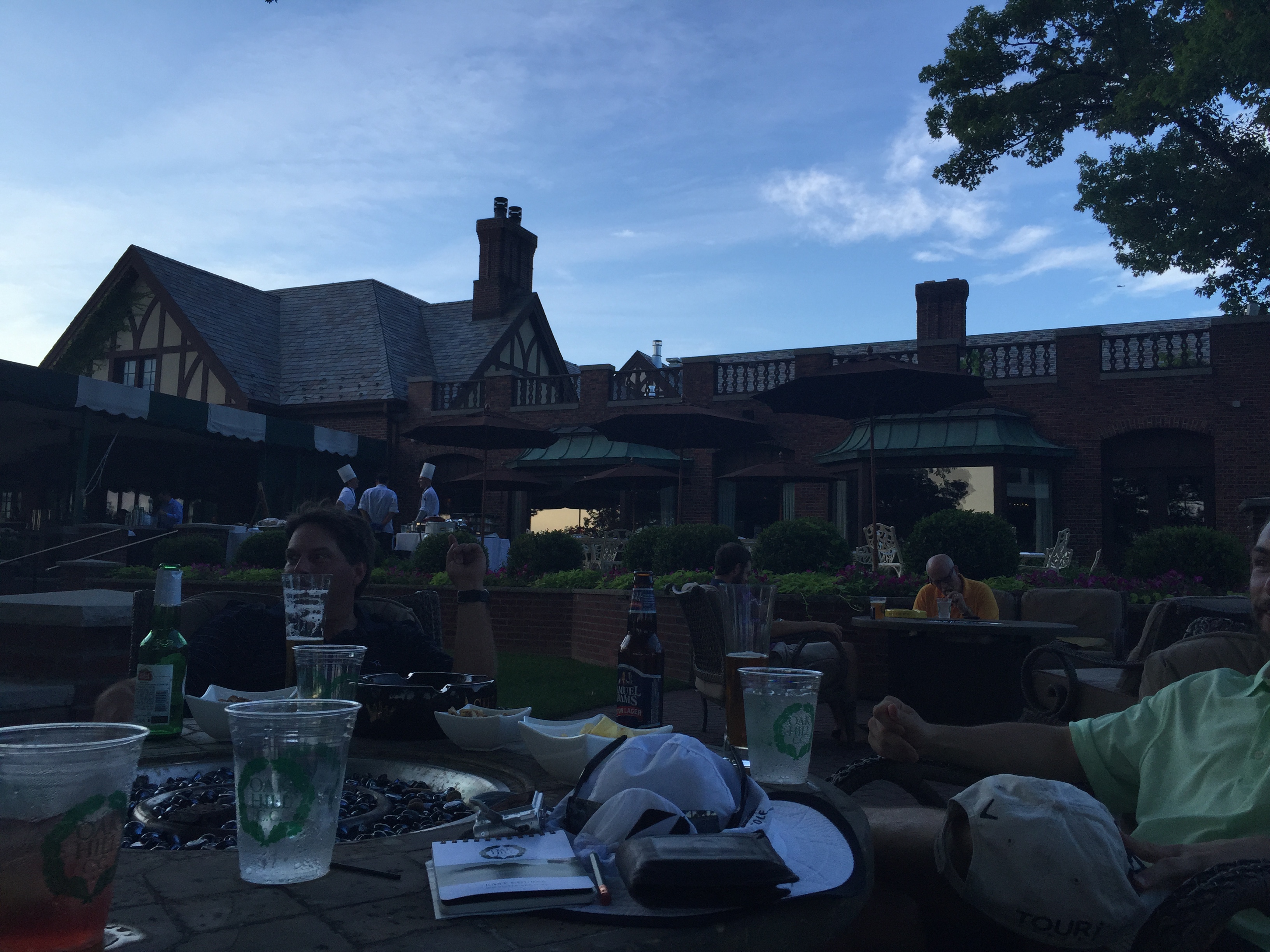
This was one of my best experiences at a Top 100 so far. Our member host had a great personality and was very open with us. He told us a lot of history and gave us a great tour of the grounds. We had great caddies. Mine was a school teacher and played in a band in his spare time. He had been at Oak Hill for a long time and knew the course very well. I couldn’t think of a better way to spend a day unless the wife had been able to come along.

Sounds like a great day, Jimmy. That is awesome you were able to get an invite. Nice pictures, as always.
Cheers
Josh
Thanks Josh!
Jimmy
Awesome journey! The course looks like it lived up to its reputation!
Cheers
Jim
Thanks Jim, it was a spectacular course.
awesome! totally jealous. Congrats on getting to play here.
Thank you! It was out of nowhere. I followed your blog as well. Looks good! Look forward to reading more. Thanks for reading.
Hey! I see myself in a few of these pics 😉 I had an absolutely amazing time here and so glad you made it. Great write-up as usual, Jimmy. Now I have to work on getting mine up sometime this week. Haha
Thanks man! Looking forward to reading yours.